2025 eBird Taxonomy Update
As part of our commitment to data quality, accessibility, and ease of use, we strive to use an integrated taxonomy across eBird, Macaulay Library, Birds of the World, Merlin and other Cornell Lab of Ornithology projects. Our 2025 update includes 40 species gained because of splits and 18 species lost through lumps, resulting in a net gain of 22 species and a new total of 11,167 species worldwide. With this update, the eBird taxonomy and the AviList taxonomy, released in June 2025, are in nearly full alignment; we expect complete alignment by October 2026.
The update process is ongoing—please do not start editing your lists until we alert you that the process is complete. This includes your My eBird lists, range maps, bar charts, region and hotspot lists; data entry should be behaving normally, but you may notice unexpected species appearing on eBird Alerts as eBirders continue to learn the new taxonomy (this issue will diminish with time). If you see unfamiliar bird names in the list, please refer to the story below to understand the change and why it happened. If you still see records appearing in unexpected ways please write to us.
Also, please check out these three important pieces of news in celebration of Taxonomy Time from the Birds of the World team (and note that they have already released accounts for all new species from this update; navigate there easily from eBird by clicking the link at the bottom of any species page, like this one).
Open access period: This year, we are opening Birds of the World for an extended period to allow for deeper exploration of these species. For those that don’t already have access, BOW open access will be from 12:00 pm ET Oct 29 to 11:59 am ET on Nov 7. Feel free to share this news within your community.
Taxonomy 2025 surprise: For those that struggle to understand changes to your Life List after a taxonomic update, check out our new Personalized eBird Taxonomy Report!
Taxonomy webinar: In related news, our taxonomy team (Pam Rasmussen, Marshall Iliff, and Shawn Billerman) will give their annual What’s New in Avian Taxonomy webinar on 13 November at 9:00 am ET. At that time, we’ll again leave the site open from 13–14 November to encourage more exploration. Registration link for the webinar is here. The webinar will be in English.
2025 eBird Taxonomic Update
This year’s update is v2025 of the eBird/Clements Checklist. The eBird/Clements Checklist is an integrated global taxonomy for the birds of the world, including all species and subspecies, as well as additional taxa useful to field birders to report in eBird. The list of species available in eBird is the eBird Taxonomy (v2025) and includes all species, subspecies groups (which we call identifiable sub-specific forms or ISSF), hybrids, intergrades, spuhs (e.g., scoter sp.), slashes (e.g., Short-billed/Long-billed Dowitcher), domestics, and forms. The Clements Checklist includes only species and subspecies, along with subspecies groups which are further identified as monotypic (consisting of one subspecies) or polytypic (consisting of more than one subspecies). Read more about the eBird Taxonomy.
The Clements Checklist provides two update pages (overview and 2025 updates & corrections) and also provides all three files (eBird/Clements, Clements, and eBird) for download, each as either an Excel spreadsheet or comma-delimited (csv) format. [note: these pages will be available only after 30 October 2025]
The Clements Checklist 2025 updates & corrections provides details (including references) for all species splits and lumps, new species descriptions, revisions to subspecies groups (ISSFs) or subspecies, and other changes relevant to the Clements Checklist. We refer anyone wishing to learn more about these splits to that page.
A list of all the taxonomic changes is below. This year’s changes incorporate the latest supplement to the AOS-NACC checklist, the 66th supplement as well as many changes adopted by AOS-SACC as revisions to the South American Checklist through through 31 July 2025.
The below summary is largely in sync with the above Clements update; references are not listed in full, but are included in the Clements update. Since this is a long article, here is a short index:
- Introduction
- Languages
- Species splits
- Species lumps
- Subspecies reshuffles
- Shuffles of other taxa and subspecies group lumps
- New subspecies groups
- New hybrids and intergrades
- New forms
- New domestics
- New slashes and spuhs
- Common Name changes
- Scientific Name changes
- Additional changes
SUMMARY
The below article is a long, detailed accounting of all taxonomic changes in this cycle. Many of the changes are in South America for this cycle, partly because of the rhythm of updates related to AviList. Below are two tables with a quick summary of major changes by region (these are regional highlights, not a complete listing; see the itemized listing below for the entire set of splits, lumps, and other changes):
| Global | Eurasia | North America |
| Striated Heron (3-way split) | Red Grouse split from Willow Ptarmigan (2-way split) | Squirrel Cuckoo (2-way split) |
| Whimbrel (2-way split) | Elegant Trogon (2-way split) | |
| Oceanic | Caribbean | Nutting’s Flycatcher (2-way split) |
| White Tern (3-way split) | Greater Antillean Elaenia (2-way split) | Dagua Thrush split from White-throated Thrush (2-way split) |
| Fea’s Petrel (2-way split) | Red-legged Thrush (2-way split) | Warbling Vireo (2-way split) |
| Imperial Cormorant (7-way lump) | Yellow Warbler (2-way split) | |
| White-eared Ground-Sparrow (2-way split) |
| South America | South America (continued) | Australasia |
| Red-lored Amazon (3-way split) | Gray-headed Bush Tanager (2-way split and name change to Cnemoscopus) | Little Shrikethrush (7-way lump) |
| Monk Parakeet (2-way split) | Black-faced Dacnis (2-way split) | Black-eared Catbird (5-way lump) |
| Painted Parakeet (4-way split) | Yellow-breasted Brushfinch (2-way split) | |
| Pale-breasted Canastero (3-way split) | Pectoral Sparrow (2-way split) | |
| Tawny-crowned Greenlet (4-way split) | Buff-breasted Mountain Tanager (3-way split) | |
| Rose-breasted Chat (2-way split) | ||
INTRODUCTION
When the taxonomy is updated in eBird, many of the changes are fairly simple to implement. When a common name changes, a scientific name changes, or when the taxonomic sequence is revised, those changes roll through and appear in eBird output fairly quickly. Staying on top of name changes is a challenge, and consulting Avibase is one of the best ways to keep track. Just type any bird name in Avibase and Avibase will show you the history of that name, and—if it differs from eBird—it will show what the eBird equivalent is for that name. Try it with “Louisiana Heron”, for example.
When species are ‘lumped’ (e.g., two taxonomic entities that used to be considered separate species, but are now one), eBird usually retains the former species as an identifiable group. In these cases, your records may shift to the lumped form and your totals may (or may not) drop by one. The actual entity that you observed and reported has not changed in any way other than being changed from species to subspecies. For example, last year, those who had birded in the Northern Hemisphere (and New Zealand) will have noticed that your previous reports of Lesser Redpoll Acanthis cabaret, Hoary Redpoll Acanthis hornemanni and Common Redpoll Acanthis flammea, have changed to Redpoll Acanthis flammea, but note that each will still carry the subspecies group (formerly species) expressed as Redpoll (Lesser) Acanthis flammea cabaret, Redpoll (Hoary) Acanthis flammea hornemanni/exilipes and Redpoll (Common) Acanthis flammea [flammea Group].
When splits occur, the process is more complicated. In most cases, we have had subspecies options available for reporting in anticipation of the split. All records reported to a subspecies group level update automatically to the new species. When a bird is reported at the broader species level (without a subspecies listed on your entry), and then that species is split, we update the records in eBird to one of the “child” species whenever possible. We try to be very conservative with this. When two species do not overlap in range (i.e., they are allopatric) we go ahead and make the change. When the species do overlap (i.e., are sympatric), and do not have clear seasonal or habitat differences, we usually do not make the change. This results in your records being left as the more conservative “slash” option. An example this year is Warbling Vireo, which is split into Western and Eastern species. Birds breeding in the Rocky Mountains and the Pacific coast have distinctive songs, usually given during the breeding season. Their structure and plumage are nearly identical, with only minor differences in the amount of contrast in the face and in bill size, as well as in molt timing. Birds breeding east of the Rocky Mountains are split as Eastern Warbling Vireo (Vireo gilvus), while those from the slopes of the Rocky Mountains westward are split as Western Warbling Vireo (Vireo swainsoni). During breeding season most records can be safely assigned, but both migrate through Mexico and they may overlap on the Great Plains of the US and Canada. The wintering grounds are poorly known, although as is often the case the western species winters primarily in western Mexico while the eastern species occurs in the Atlantic Slope of eastern and southern Mexico and into Central America; the most southerly wintering birds are likely to be Eastern. However, as the winter ranges are very poorly known, birders should take any opportunity to confirm the identification by studying molt, audio-recordings songs, or even collecting genetic material for analysis when possible to make sure that our beliefs about wintering range hold true. As a result, a large number of records in overlap zones, during migration, and on the wintering grounds will be treated as a slash: Eastern/Western Warbling Vireo. We encourage reporting of records in this way whenever there is doubt (including unseasonal records in the East and West, which could involve vagrants). These slash options are a very important part of data integrity at eBird.
If you want to review your records of Eastern Warbling Vireo or Western Warbling Vireo, there are a couple ways to do this through the My eBird tools. The easiest is to go to My eBird, click on your Life List number, and then use the search option at the top to find whichever species you are looking for. You can then review the records in full. Importantly, in 2023 we added the ability to also view all your records of hybrids, slash, and spuh taxa. Reviewing slash taxa is especially useful during eBird Taxonomy Updates, so to find your Eastern/Western Warbling Vireo records please go to My eBird > Life List and then expand the “Detailed Stats” option and then select “Additional Taxa”. The search at the top of the page is a species-level search, so sorting taxonomically and searching on the page (perhaps using a browser search) will help you find any Eastern/Western Warbling Vireo. Click “View all” to see all your records. Note that we do provide direct links to relevant slashes from this year’s splits and the direct link for the Eastern/Western Warbling Vireo slash is this: https://ebird.org/lifelist?r=world&time=life&spp=warvir.
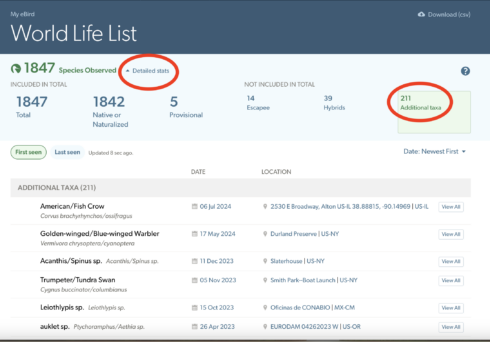
There are some other ways to find your records too. If you know the checklist it is on, you can find the list in “Manage My Checklists” and edit it as needed. If you can find your checklist on the range map then you can just click on the marker for your list and open it from there. Another option to review your records is to go to My eBird and then click Download My Data from the left side. This downloads your entire eBird database as a CSV file that can be opened in Excel or a similar spreadsheet program. From there, you should easily be able to sort by name or search for any species or taxon you are looking for to find your records. Then you can scroll to the correct date or just replace the Submission ID in the URL for a checklist view.
Finally, there are some minor changes to taxonomic sequence this year, reflecting new understanding of relationships among tinamous (Tinamiformes: Tinamidae), fruit-doves and blue-pigeons (genera Megaloprepia, Ramphiculus, Alectroenas, and Ptilinopus), Grus cranes, Protopelma chrysolophum, and Turdus thrushes, along with a few more minor adjustments. See the Clements narrative for more details on these changes.
This may be a bit disorienting if you have memorized the sequence of species, but please be aware that Quick Entry makes it very easy to find and enter any species during data entry. Did you know that typing “37 weca” in eBird mobile will quickly add 37 Western Capercaillies to whatever total you have already entered? (Learn how!). Also, learning to search for a species within your browser may be helpful too, since this works to quickly jump to a species in any species list (e.g., bar chart, Location Explorer) on eBird.
GLOBAL CHECKLIST ALIGNMENT
AviList v2025 was published in June 2025 and provides a consensus taxonomy that involved representatives from eBird/Clements, BirdLife International, the IOC World Bird List, Avibase, AOS-NACC, AOS-SACC, and other global experts in taxonomy, nomenclature, and classification. This effort is intended to replace the independent efforts that previously had produced multiple checklists, including the BirdLife International Checklist, the IOC World Bird List, and eBird/Clements Checklist. In the near future we expect the IOC World Bird List to cease its updates and we expect eBird/Clements and BirdLife International to cease independent operation and to align their efforts around the collaborative efforts of AviList. The eBird/Clements Checklist is currently 99.993% aligned, with just a few dozen species that do not match perfectly between the taxonomies (there are some English name differences, but users can pick which set of English names they prefer! See below). The next update to AviList is expected in autumn 2026 and next year’s update to the eBird/Clements checklist should be fully aligned with AviList.
LANGUAGES
We provide bird names in eBird for some 72 languages (e.g., Arabic, Bulgarian, Thai, etc.), as well as 47 additional regional versions of some languages (total 115). For example, Pluvialis squatarola is known as Black-bellied Plover in our taxonomy, but known by its winter dress in some areas such as the United Kingdom, where it’s called Grey Plover. You can access name preferences under “Preferences” from most eBird pages, which is also where you can set the names to show as common names or scientific names. One option is English (AviList), which gives a full translation of species names into the AviList v2025 nomenclature, since some English names differ between the two lists. Note that these names are exact taxonomic matches, so they reflect as slashes when a species is split by AviList and not by eBird; similarly, species split by eBird will appear as subspecies groups for AviList. Our Bird Names in eBird article explains more about regional common name preferences.
SPECIES SPLITS
The species below were split in eBird. To see a map of the new species, click “map”. To see your personal lists in My eBird, just make sure you are logged in and click “My Records”. If you have seen the species but don’t have any records shown, then please enter your sightings! Full details for all below accounts can be seen at the Clements Updates & Corrections page. We encourage all birders to carefully review the below splits and check your personal records and to update them if you think we made an error.
As with last year, we are documenting more explicitly the logic rules we have used to make bulk changes that assign records to a given species (later, the normal review process may help to correct or refine records, especially those with photos). These are highlighted in red-orange text: Regional Record Change Logic. In almost all cases (except very obvious errors by users and/or reviewers) we have retained the original identification by the observer. If the observer specified a subspecies, which later was split to become a species, that identification is retained. If the observer did not specify a subspecies, then we have tended to convert the record to the expected species if and only if the alternative species is impossible or extremely remote. However, since the probability of bird occurrence across space and time has infinite shades of gray, we need to make judgment calls. As an example, all Thailand records of Whimbrel (Numenius phaeopus, sensu lato) should pertain to the expected taxon, Eurasian Whimbrel (Numenius phaeopus). But Whimbrels in British Columbia, Canada, will all be Hudsonian Whimbrel (Numenius hudsonicus). While both species may occur as vagrants on the “wrong” continent, it is only on some parts of the mid-ocean and along the Aleutian island chain in Alaska that we cannot safely assume the species from the observer’s reports. In cases where the observer did not specify the subspecies at the time of data entry, the records will appear as Eurasian/Hudsonian Whimbrel.
Below are the splits for this update, which this year are beautifully illustrated with composite images made by Pam Rasmussen (these and many more also appear in the Clements v2025 updates). Thanks also to the staff of Birds of the World for the maps and the tens of thousands of photographers who have shared their avian images and sounds with the Macaulay Library; these composite images would not have been possible without them.
Red Grouse Lagopus scotica is split from Willow Ptarmigan Lagopus lagopus. This split gives Great Britain a second endemic species, the other being the always-controversial Scottish Crossbill. This Lagopus split has also been controversial: while the red plumage of Red Grouse (which could also be known as Red Ptarmigan) is held year-round, unlike the many subspecies of Lagopus lagopus, other differences (including calls) are minimal. Ultimately, AviList opted to split this species based in part on a recent analysis in support of species status.
- Red Grouse Lagopus scotica [map] [media] [my records]
-
- RANGE: Ireland, Outer Hebrides, Scotland, northern and western England, and Wales
-
- Willow Ptarmigan Lagopus lagopus [map] [media] [my records]
-
- RANGE: Holarctic, mainly in tundra, southward to steppes of southwestern Siberia and northern Kazakhstan, western Mongolia (Tanmu-Ola, Khangai, and Kentei mountains), and northwestern British Columbia to Newfoundland
-
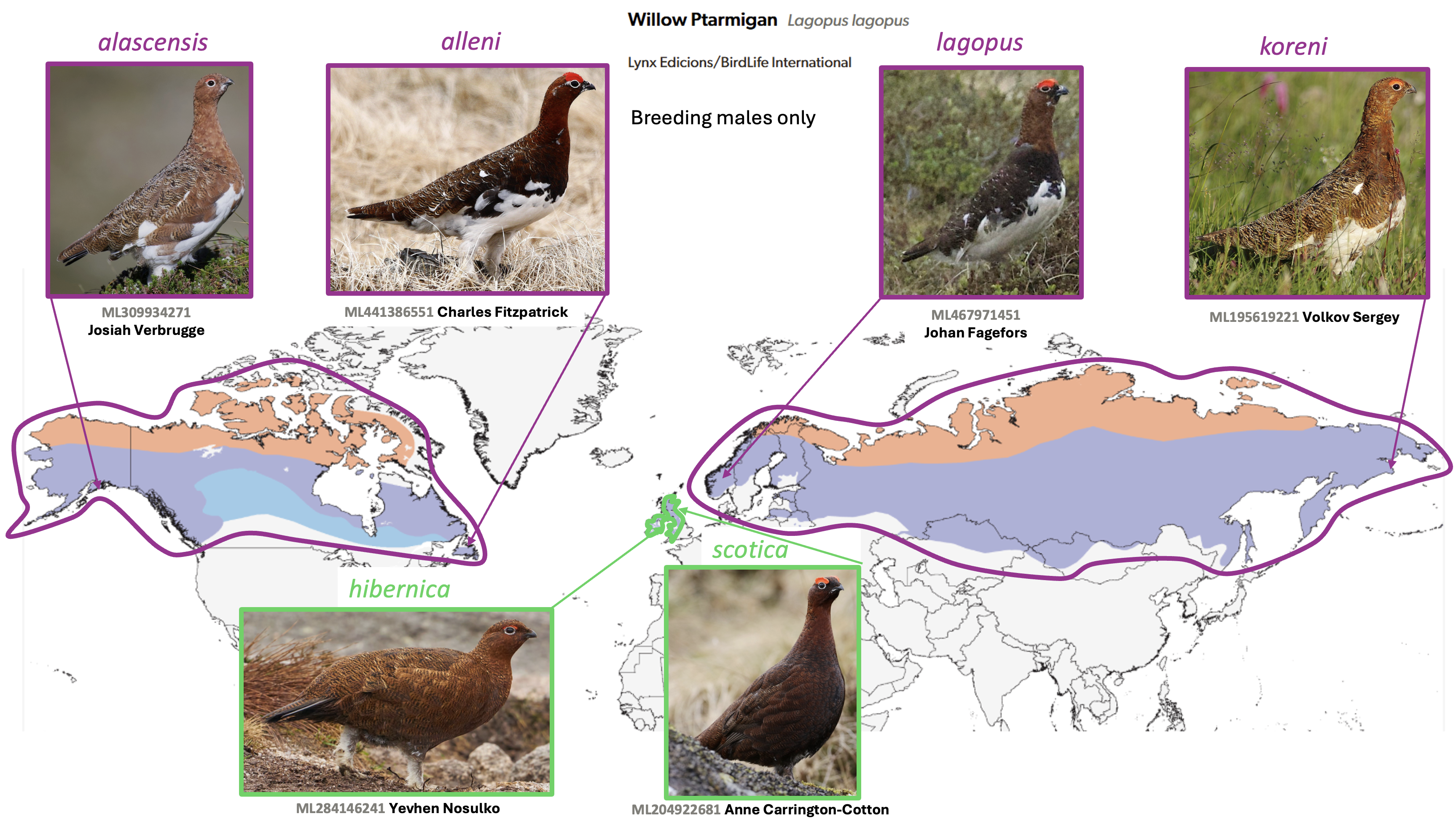
Mexican Squirrel-Cuckoo Piaya mexicana and Common Squirrel-Cuckoo Piaya cayana are split from Squirrel Cuckoo Piaya cayana. A recent proposal that assessed plumage, voice, and genetics of many of the subspecies of Squirrel Cuckoo revealed that the west Mexican form, which has a uniquely rufous underside to the tail and bare bluish facial skin, was the most distinctive. This adds to a long string of recent splits of West Mexican taxa (e.g., Cinnamon-breasted Seedeater, West Mexican Euphonia, etc.) that have been recognized as full species in recent years. Take note of the composite image below, however. Another deep genetic split involved the suite of taxa in Amazonia (the cayana Group in the below composite) and the image shows that their red orbital ring stands apart from the cis-Andean taxa (west of the Andes). This is one to watch for the near future and to expect “Common Squirrel-Cuckoo” to be further subdivided.
- Mexican Squirrel-Cuckoo Piaya mexicana [map] [media] [my records]
-
- RANGE: Pacific slope of Mexico (central Sonora southward to Isthmus of Tehuántepec)
-
- Common Squirrel-Cuckoo Piaya cayana [map] [media] [my records]
- Common Squirrel-Cuckoo (Middle American) Piaya cayana thermophila [map] [media] [my records]
- RANGE: eastern Mexico (eastern San Luis Potosí and southern Tamaulipas southward to Veracruz, Yucatán, and Isthmus of Tehuantepec on Gulf coast southward to near Tehuantepec City) through Central America to Panama and northwestern Colombia
- Common Squirrel-Cuckoo (nigricrissa) Piaya cayana nigricrissa [map] [media] [my records]
- RANGE: western Colombia (west slope of western Andes, the Cauca Valley, and the east slope of the northern central Andes), western Ecuador, and far northwestern Peru (Tumbes and Piura)
- Common Squirrel-Cuckoo (Amazonian) Piaya cayana [cayana Group] [map] [media] [my records]
- RANGE: Amazonian parts of Colombia to northern Venezuela, Trinidad, and south to s. Bolivia and adjacent n. Argentina
- Common Squirrel-Cuckoo (Middle American) Piaya cayana thermophila [map] [media] [my records]
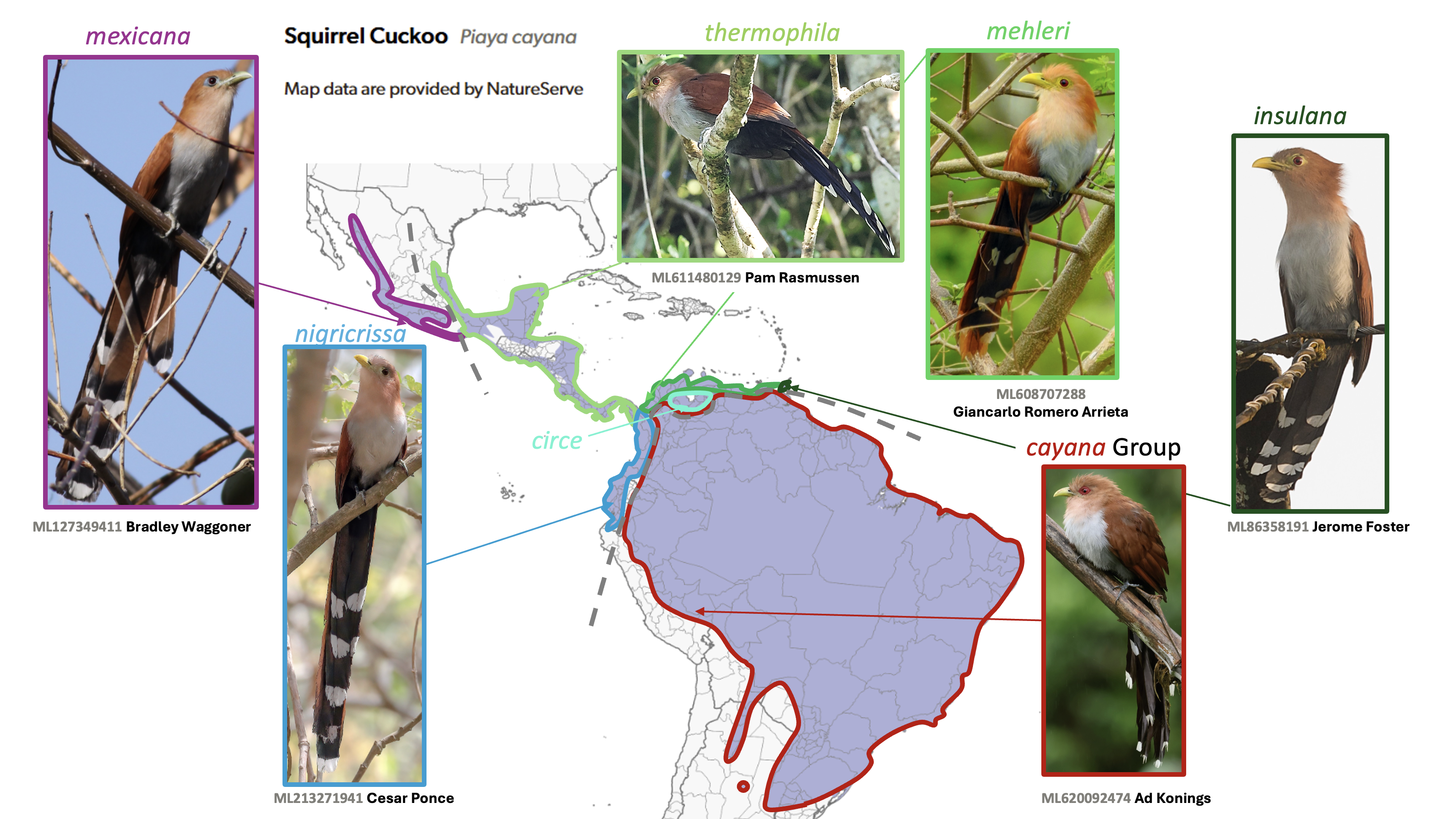
Regional Record Change Logic: We use this section to clarify how eBird has changed records that were reported at the species-level before the split (records that specified a subspecies are generally not changed, but will instead update to the correct species after the split).
Mexican Squirrel-Cuckoo and Common Squirrel-Cuckoo approach one another only in Oaxaca and a very small number of records in the potential contact zone may be retained as a Mexican/Common Squirrel-Cuckoo slash in that region. Check your records with care in the Valley of Oaxaca and hills to the north and east and be alert for potential hybrids in that area.
Eurasian Whimbrel Numenius phaeopus and Hudsonian Whimbrel Numenius hudsonicus are split from Whimbrel Numenius phaeopus
- Hudsonian Whimbrel Numenius hudsonicus [map] [media] [my records]
-
- RANGE: Alaska to northern Canada; winters to southern South America
-
- Eurasian Whimbrel Numenius phaeopus [map] [media] [my records]
- Eurasian Whimbrel (European) Numenius phaeopus phaeopus [map] [media] [my records]
- RANGE: northwestern Palearctic; winters to Africa and India
- Eurasian Whimbrel (Steppe) Numenius phaeopus alboaxillaris [map] [media] [my records]
- RANGE: breeds steppes of Kazakhstan? and southwestern Siberia; winters islands and coasts of western Indian Ocean
- Eurasian Whimbrel (Siberian) Numenius phaeopus variegatus/rogachevae [map] [media] [my records]
- RANGE: breeds north-central and ne. Siberia; winters Indian Ocean coasts to Taiwan, southward through Philippines and Indonesia to Australia
- Eurasian Whimbrel (European) Numenius phaeopus phaeopus [map] [media] [my records]
Occasional birds will be seen (or heard!) in western Alaska or the middle of the Ocean or some other circumstance where either species is possible, so we offer the slash as an option for conservative reporting.
- Hudsonian/Eurasian Whimbrel Numenius hudsonicus/phaeopus [map] [media] [my records]
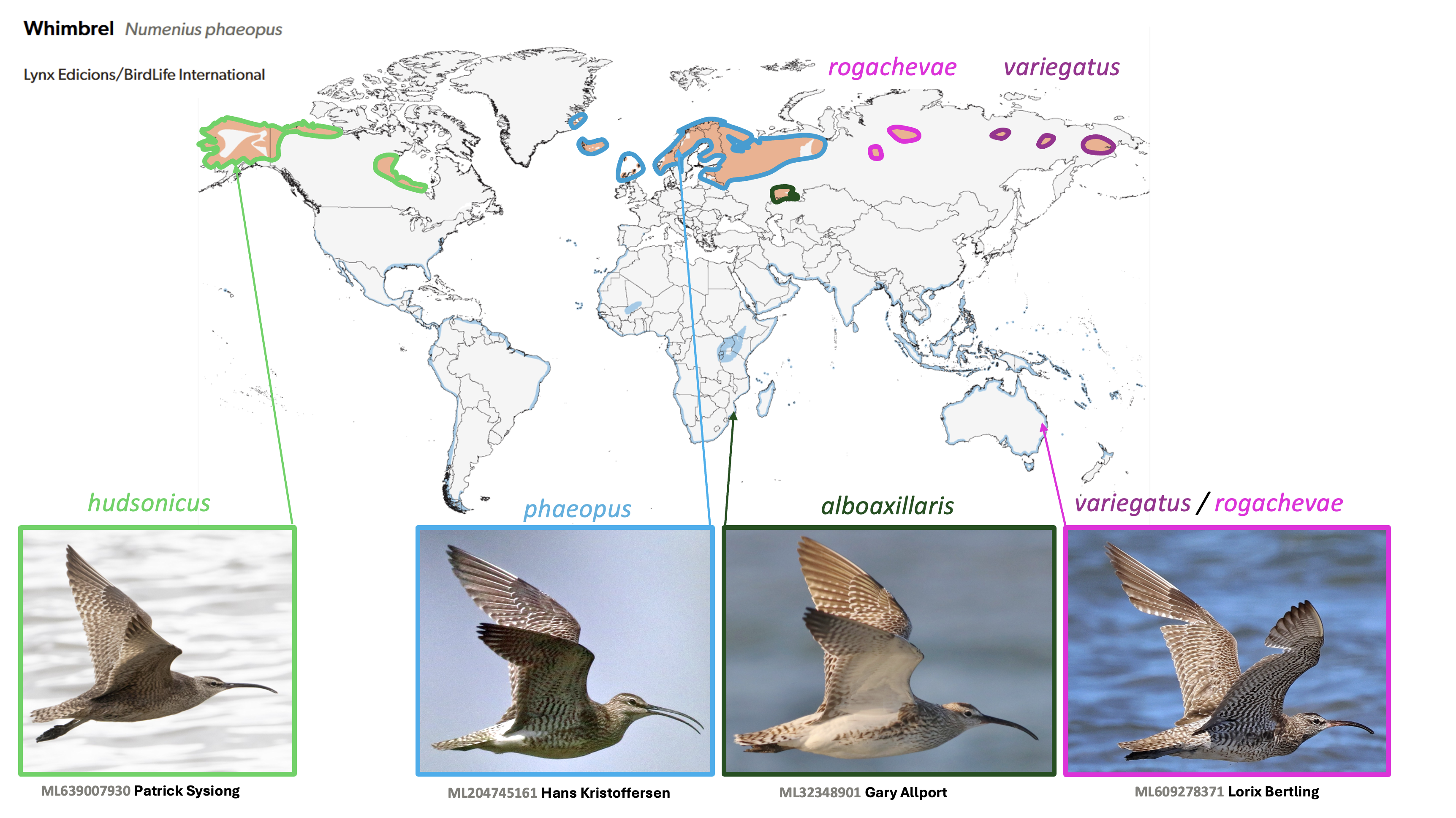
Regional Record Change Logic: Almost all Whimbrels are safely assigned based on the continent of the records. The only regions where we have not automatically changed records on behalf of observers are: 1) western Alaska, including the western Aleutians, Pribilof Island, and Gambell; 2) some mid-Atlantic islands, like St. Helena and Ascension (records from Bermuda are presumed to pertain to Hudsonian while those from the Azores presumed to pertain to Eurasian; 3) Hawaii and Midway, where we have not changed records and depended on birders to make the designation for us (although numerous known long-staying rarities have been assigned to species). In the Pacific west and south of Hawaii, records are presumed to pertain to Eurasian Whimbrel, since N. p. variegatus winters broadly in the South Pacific.
Blue-billed White-Tern Gygis candida, Little White-Tern Gygis microrhyncha and Atlantic White-Tern Gygis alba are split from White Tern Gygis alba. Along with the noddies, white-terns are highly distinct from the remainder of the gull-tern-skimmer radiation and have recently been recognized as a subfamily. This means that skimmers, Little Gull, Great Black-backed Gull, kittiwakes, Sooty Tern, Least Tern, Caspian Tern, and Black Tern are all more closely related to one another than any is to the white-terns. Traditionally treated as a widespread single species, White Tern, these three species look extremely similar, but calls, genetics, and the subtle differences in bill structure, measurements, and plumage indicate that they are better treated as three species and AviList, AOS-NACC, SACC, IOC, and now eBird/Clements all agree on this treatment.
White-Terns are fun for many reasons. First, they don’t build nests and rather they just make sure to delicately balance their eggs (and downy babies) on wide branches of trees on islands in the tropical oceans. They float like alabaster fairies over the ocean or over those remote islands, earning them their colloquial name of Fairy Tern (not to be confused with Australasian Fairy Tern Sternula nereis, a relative of Little Tern and Least Tern). Finally, white-terns have a remarkable penchant for vagrancy. Little White-Tern has reached Hawaii (a long time ago, but one to watch for again!) and Blue-billed White-Tern has multiple records from the Atlantic Basin, including two records from Bermuda (one in summer 2025), a recent record from Wales, and others from the Caribbean. Who knows where the next one might appear!?
- Atlantic White-Tern Gygis alba [map] [media] [my records]
-
- RANGE: Fernando de Noronha, Trindade, Martin Vas Rocks, Ascension, and St. Helena islands (tropical South Atlantic Ocean)
-
- Blue-billed White-Tern Gygis candida [map] [media] [my records]
-
- RANGE: Seychelles and Mascarene islands, Chagos and Maldives (Indian Ocean), and islands of southern Pacific from islands off New Guinea, Lord Howe, Norfolk, and Kermadec to Hawaii, Clipperton, Cocos, and Malpelo islands, and Henderson and Pitcairn islands (eastern Polynesia)
-
- Little White-Tern Gygis microrhyncha [map] [media] [my records]
-
- RANGE: Marquesas, formerly Phoenix and Line islands, and prehistorically westward to Micronesia and Samoa
-
Since white-terns are always difficult to identify, and since vagrants can occur far from where they belong, a conservative white-tern sp. option is available. Make sure to use this for the three species in the genus Gygis, and not for any tern (Sternidae) seen that looks whitish!
- white-tern sp. Gygis sp. [map] [media] [my records]
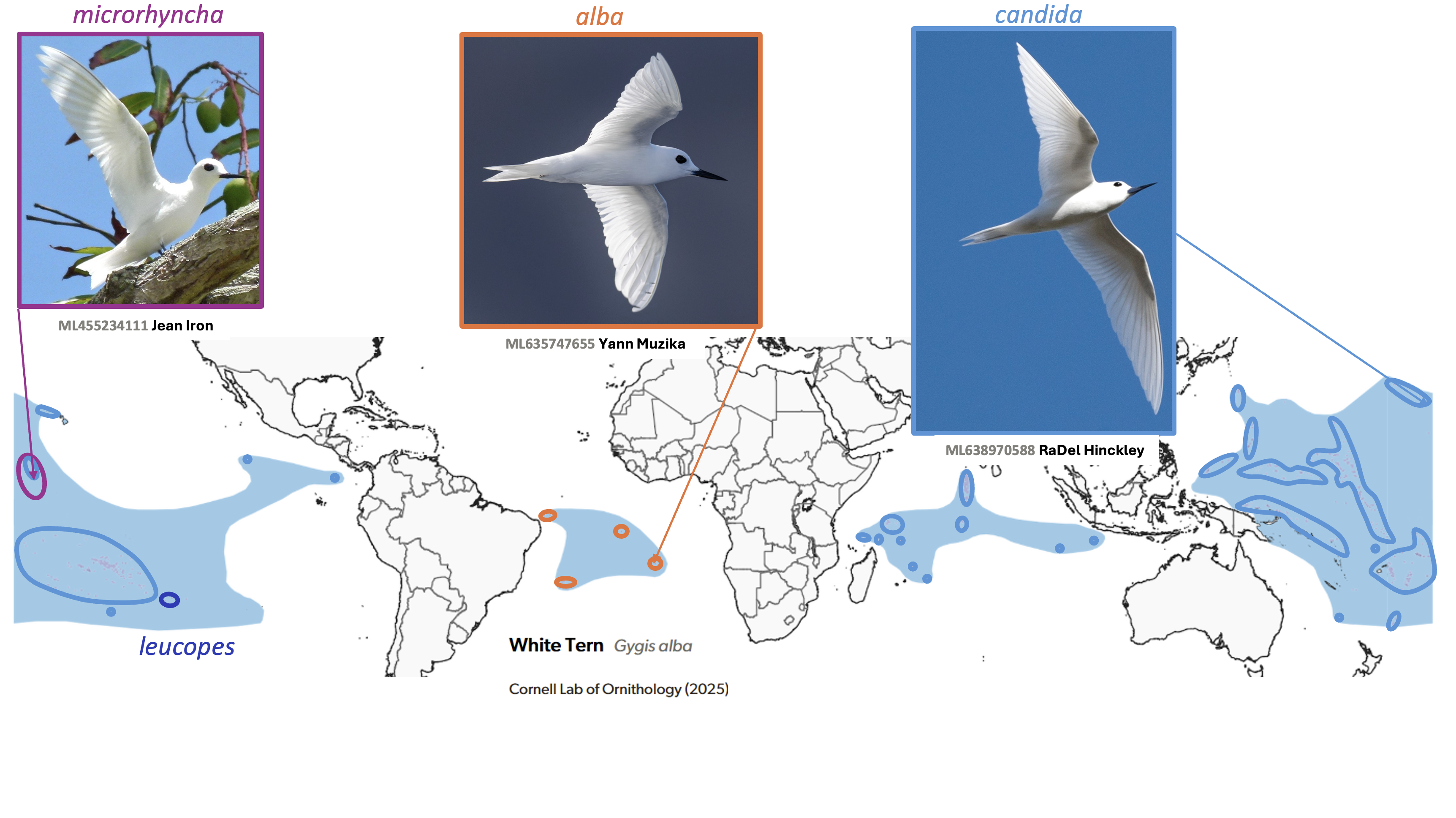
Regional Record Change Logic: Almost all white-terns can be safely assigned to species by range. Vagrant records in the North Atlantic must be identified conclusively, however, since both Blue-billed and Atlantic White-Tern are possible there (there are several records of Blue-billed White-Tern from that area). In addition, some Marquesas records may only be identifiable to Blue-billed/Little White-Tern.
Eastern Rockhopper Penguin Eudyptes filholi and Western Rockhopper Penguin Eudyptes chrysocome are split from Southern Rockhopper Penguin Eudyptes chrysocome. This split gives us a third rockhopper-penguin, following the split of Moseley’s Rockhopper-Penguin Eudyptes moseleyi a few years ago. All three are tough to identify, but pay attention to range. When that fails, focus on the details of the crest length (especially long in Moseley’s), details of the bill pattern (note the pinkish fringe in Eastern), and calls. Nobody can complain about more types of penguin in the world (although we aren’t really sure they are actually birds).
- Western Rockhopper Penguin Eudyptes chrysocome [map] [media] [my records]
-
- RANGE: breeds far southern Chilean islands of Magallanes Province to Cape Horn Archipelago and Falkland Islands; winters northward along Patagonian coast
-
- Eastern Rockhopper Penguin Eudyptes filholi [map] [media] [my records]
-
- RANGE: breeds coastally on Prince Edward, Crozet, Kerguelen, Heard (southern Indian Ocean), Macquarie (southeast of Australia), and Auckland, Campbell, and Antipodes islands (New Zealand)
-
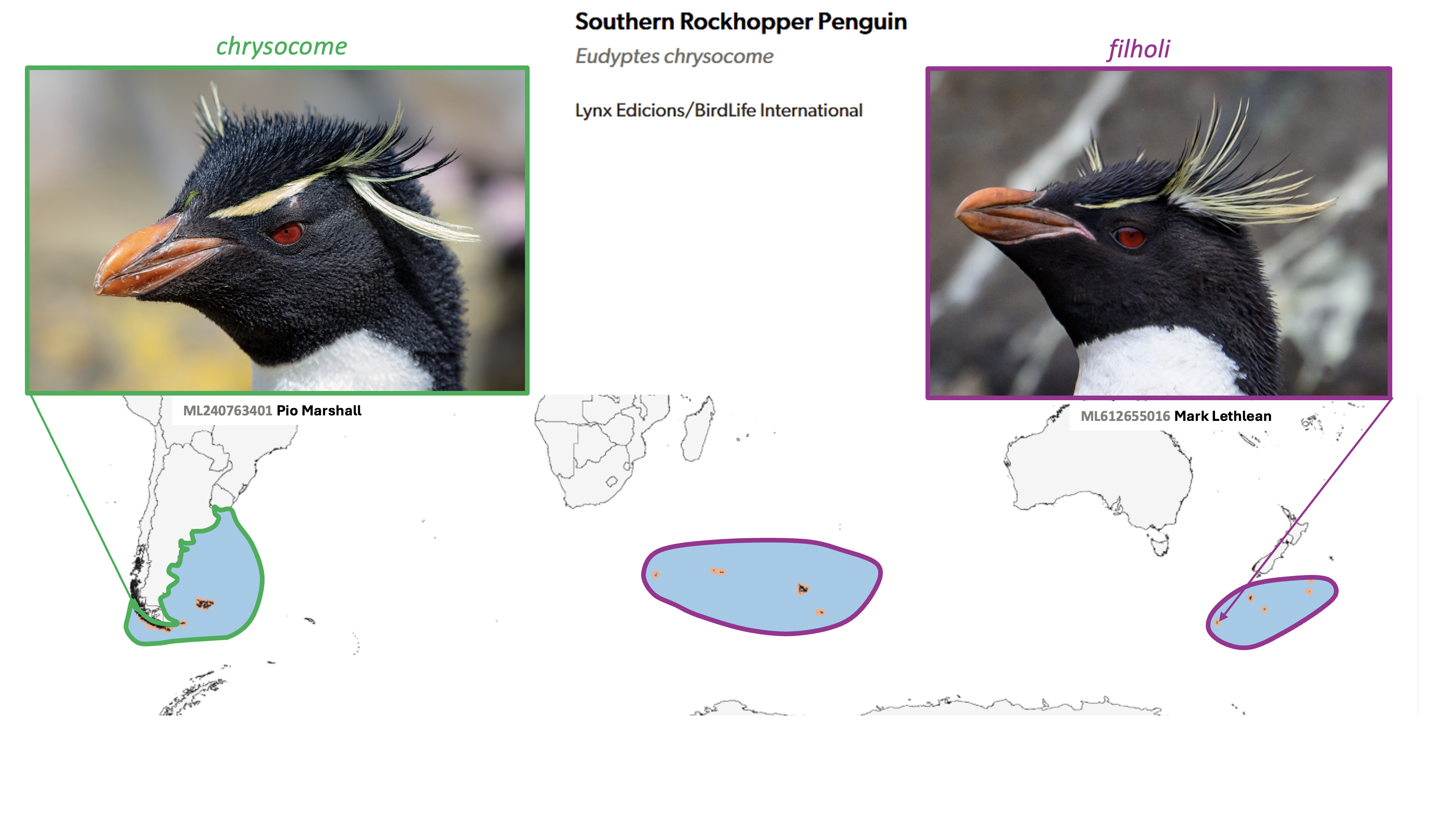
Desertas Petrel Pterodroma deserta and Cape Verde Petrel Pterodroma feae are split from Fea’s Petrel Pterodroma feae. Any seabird aficionado would have been expecting this split for a long time. Although they are essentially identical in plumage and in any other characters that might make at-sea identification in the field possible, the two species have long been known to differ in breeding timing (Desertas breeds in July to December, while Cape Verde breeds January to June) and calls (usually only heard around the breeding islands). Genetics have reinforced that these species are more different than they appear to the birder, and like other tubenoses, they probably can tell each other apart by smell far more easily than birders and taxonomists can distinguish them using all five of their senses. For intrepid birders there are rumors that an article may appear soon to help us all get a better handle on the field identification of these birds.
Both species are of high conservation concern, with Desertas being treated as Vulnerable by the IUCN and Cape Verde as Near-threatened.
Data from satellite tracks and geolocators show that Desertas ranges widely in the temperate waters of the North Atlantic during the boreal summer (May-September), reaching waters just east of North America (and presumably accounting for photo records from Georgia to Atlantic Canada). During the same period, Cape Verde remained in the waters near the Cape Verde archipelago. Cape Verde is thought to range west and south of the Cape Verde islands and to prefer more tropical water temperatures. But the two species likely overlap extensively, with tracks of Desertas reaching waters around the Cape Verde Islands in the boreal winter (November-March) and some records of Cape Verde north to at least Spain. See Global spatial ecology of three closely-related gadfly petrels (Ramos et al. 2016) for more information.
- Cape Verde Petrel Pterodroma feae [map] [media] [my records]
-
- RANGE: winter breeder mainly in rock crevices in montane Santo Antão, São Nicolau, Fogo, and Santiago (Cape Verde Islands, southern Macaronesia); non-breeding range probably mostly off northwestern Africa
-
- Desertas Petrel Pterodroma deserta [map] [media] [my records]
-
- RANGE: summer breeder in burrows on Bugio (Desertas Islands, just southeast of Madeira, central Macaronesia); non-breeding range probably mostly to Azores (northwestern Macaronesia) and southeastern Brazil, more rarely to Gulf Stream off eastern North America and western Europe
-
Given the MASSIVE field identification challenge, we recommend copious use of the slash for these taxa:
- Cape Verde/Desertas Petrel Pterodroma feae/deserta [map] [media] [my records]
And given that Zino’s Petrel (even rarer globally, with an estimated 80 pairs breeding on the high summits of Madeira) is also a huge at-sea field identification challenge (focus on its comparatively dainty bill and paler underwing), we also have the three-way slash for responsible reporting.
- Zino’s/Cape Verde/Desertas Petrel Pterodroma madeira/feae/deserta [map] [media] [my records]
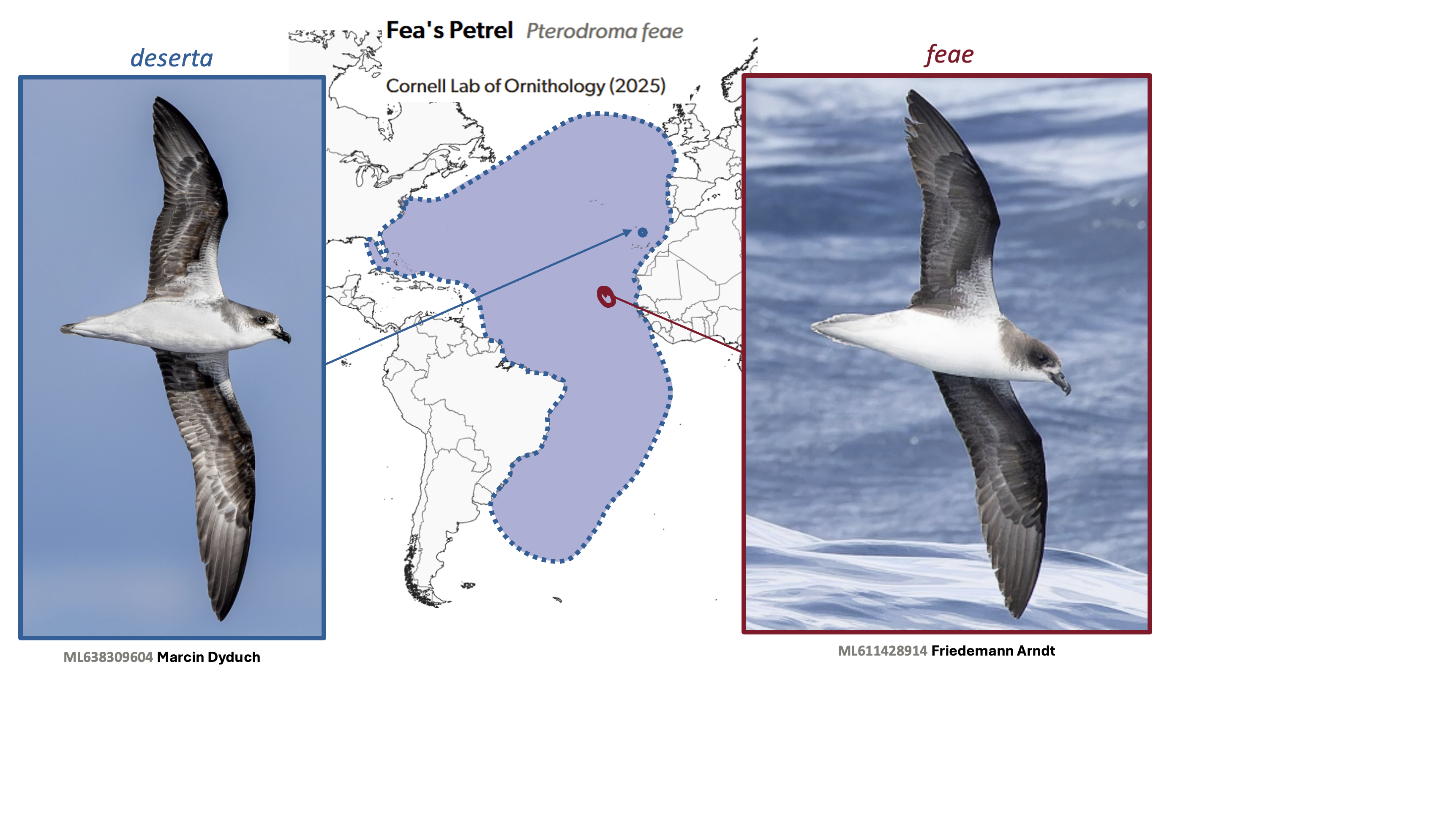
Regional Record Change Logic: The safest records are those of Desertas Petrels close to their breeding areas. Cape Verde Petrels can presumably be safely assumed around the breeding islands during April to September. In addition, we presume records from the United States and Canada pertain to Desertas Petrel. There remains no solid evidence of Cape Verde Petrel occurring in these waters, and if it does, it is likely to be extremely rare. Most other records will at this time remain as Cape Verde/Desertas Petrel, but if European authorities or other regions learn more about the presumed range, we may make further updates. Unfortunately, given the field identification challenges, these conversions are based almost entirely on assumptions and are open to question as we learn more. Try as hard as possible to get excellent photos of these species whenever encountered, on the hope that they may be separable in the field as we learn more.
Lava Heron Butorides sundevalli and Little Heron Butorides atricapilla are split from Striated Heron Butorides striata. Lava Heron, endemic to the Galapagos, is highly distinctive in its sooty (lava-colored) plumage and is from a region well-known for its endemism. Its split adds an endemic to the Galapagos and to Ecuador. Somewhat less expected, given their superficial similarity, is the split of South American Striated Heron Butorides striata from its Old World counterpart from Africa, the Middle East, south, east, and southeast Asia, Australasia, and Oceania. These birds are highly variable across a broad range, but interestingly they all differ from South American birds in the color of the facial skin in breeding condition (blue in Striated Heron, yellowish/greenish in Little Heron), as shown in the below image. eBird also adds a range of subspecies groups to help document the variety in plumage of the Old World birds.
- Striated Heron Butorides striata [map] [media] [my records]
-
- RANGE: eastern Panama and all South America to northern Argentina and Chile
-
- Lava Heron Butorides sundevalli [map] [media] [my records]
-
- RANGE: coasts and mangroves of Galapagos Islands
-
- Little Heron Butorides atricapilla [map] [media] [my records]
-
- RANGE: sub-Saharan Africa including islands in Gulf of Guinea and Malagasy region, coasts of Middle East, islands in northern Indian Ocean, Indian subcontinent, Sri Lanka, and Lakshadweep eastward through Japan, eastern China, Philippines, the Greater Sundas, New Guinea, Australia, Bismarck Archipelago, New Caledonia, Fiji, and disjunctly in Tahiti; northeastern Asian populations winter to southward
-
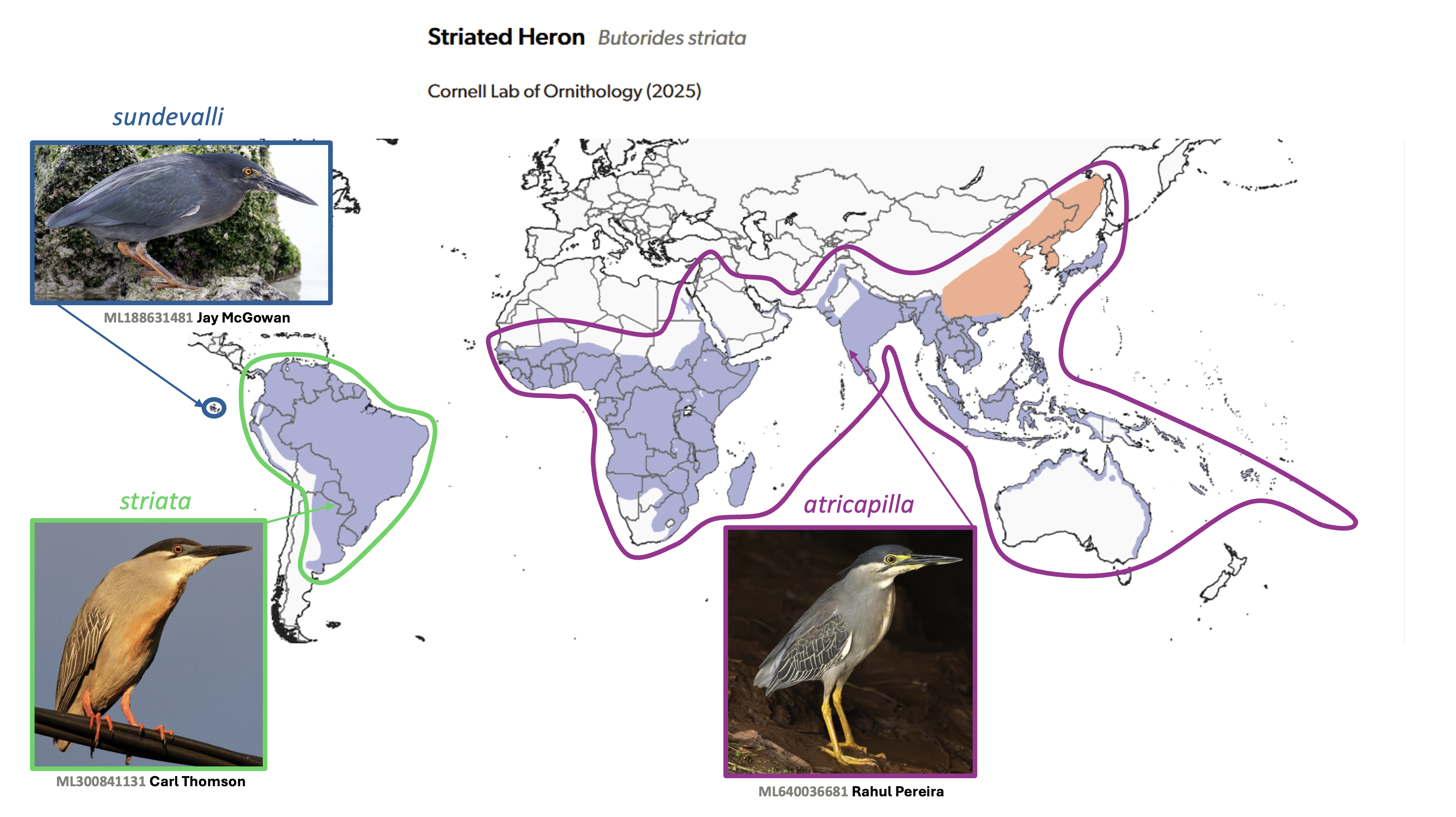
Coppery-tailed Trogon Trogon ambiguus is split from Elegant Trogon Trogon elegans. Trogons have been on a decade-long tear of increasing their diversity in the Neotropics, with splits within White-tailed, Black-tailed, Black-throated, Violaceous, and now Elegant Trogons. The northern birds, known in the United States from iconic places like Cave Creek Canyon, return to an older name: Coppery-tailed Trogon. This indeed is a good distinction from the southerly birds, which retain the name Elegant Trogon and which have greenish uppertails with at most a faint hint of bronze. The calls are more strikingly different, but those are rarely needed, since you just need to look at a map: Mexico (or the United States) is Coppery-tailed while anywhere in Central America is Elegant Trogon.
- Coppery-tailed Trogon Trogon ambiguus [map] [media] [my records]
-
- RANGE: oak-pine woodland of southeastern Arizona and southwestern New Mexico to northwestern Mexico (Sinaloa), Tres Marías Islands (off western Mexico), and northern Nuevo León and central Tamaulipas westward to Nayarit and southward to Oaxaca (eastern to southern Mexico)
-
- Elegant Trogon Trogon elegans [map] [media] [my records]
- Trogon elegans elegans
- RANGE: southeastern Guatemala (Motagua Valley), El Salvador, and southwestern and central Honduras
- Trogon elegans lubricus
- RANGE: eastern and southern Honduras, Nicaragua, and northwestern Costa Rica
- Trogon elegans elegans
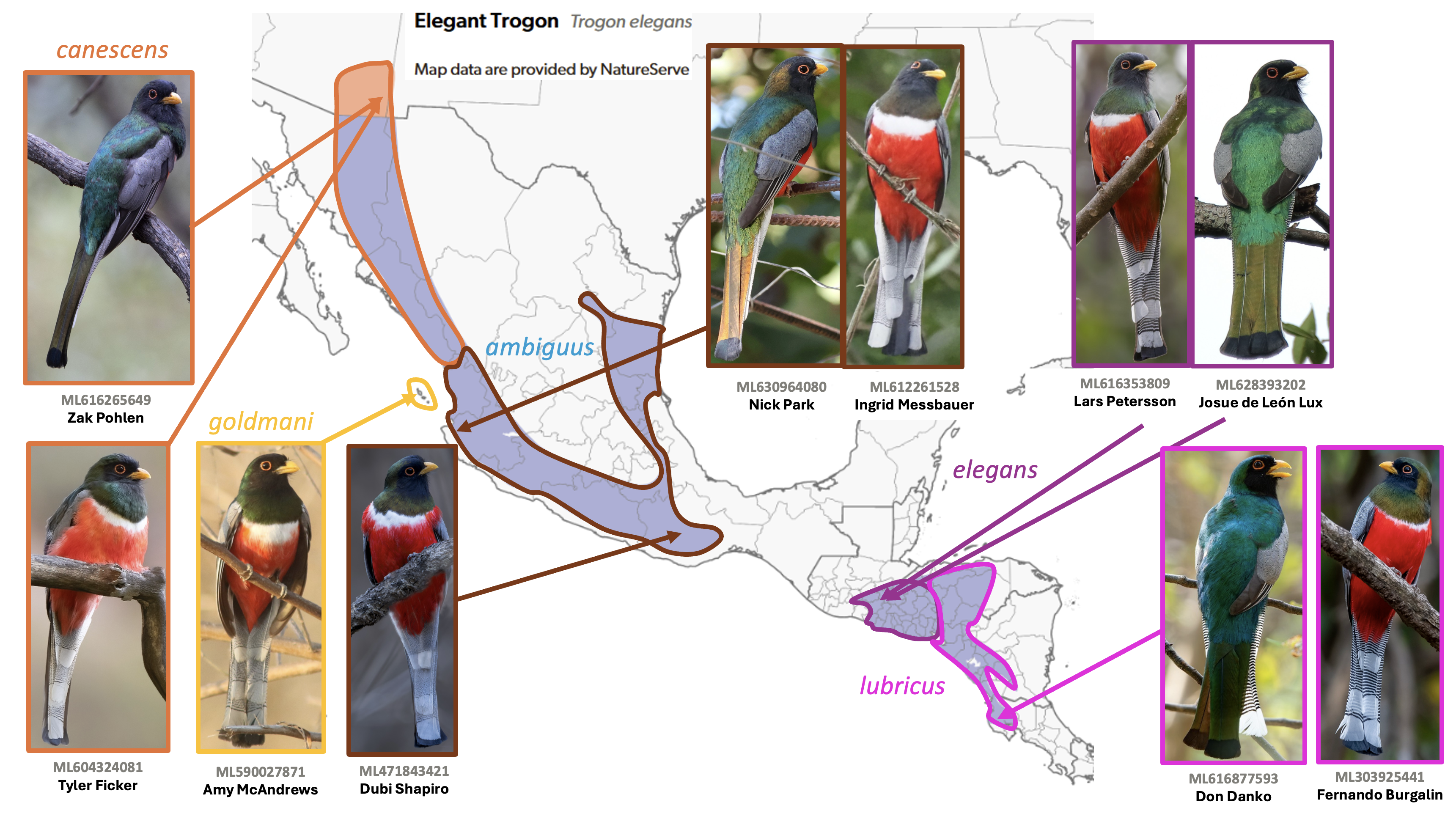
![]()
Pale-mandibled Aracari Pteroglossus erythropygius is split from Collared Aracari Pteroglossus torquatus. Some authorities (including the IOC) have recognized Stripe-billed Aracari and Pale-mandibled Aracari as separate species, but AviList and eBird are treating both as distinctive forms within Pale-mandibled Aracari Pteroglossus erythropygius.
- Collared Aracari Pteroglossus torquatus [map] [media] [my records]
-
- RANGE: humid and semi-humid forest on the Gulf of Mexico slope from Veracruz eastward to the northern lowlands of Panama, including most of the Yucatan Peninsula, and on the Pacific slope from Oaxaca eastward to eastern Costa Rica; in South America in the lowlands of northern Colombia and northwestern Venezuela southward to the middle Magdalena Valley, and west of the Andes southward across Ecuador to far northwestern Peru in Tumbes
-
- Pale-mandibled Aracari Pteroglossus erythropygius [map] [media] [my records]
- Pale-mandibled Aracari (Stripe-billed) Pteroglossus erythropygius sanguineus
- RANGE: eastern Panama and northwestern Colombia southward to northern Ecuador
- Pale-mandibled Aracari (Pale-billed) Pteroglossus erythropygius erythropygius
- RANGE: northern Ecuador southward to northwestern Peru (eastern Tumbes)
- Pale-mandibled Aracari (Stripe-billed) Pteroglossus erythropygius sanguineus
The two species come into contact in the Choco region of nw. Colombia and extreme se. Panama (and occasionally hybridize). Focus on the bill pattern to identify them, but use the slash whenever you are uncertain or when you might be seeing either species (or hybrids) and can’t study them in detail. And use the hybrid, with care, when you are certain you have an intermediate bird.
- Collared/Pale-mandibled Aracari Pteroglossus torquatus/erythropygius [map] [media] [my records]
- Collared x Pale-mandibled Aracari (hybrid) Pteroglossus torquatus x erythropygius [map] [media] [my records]
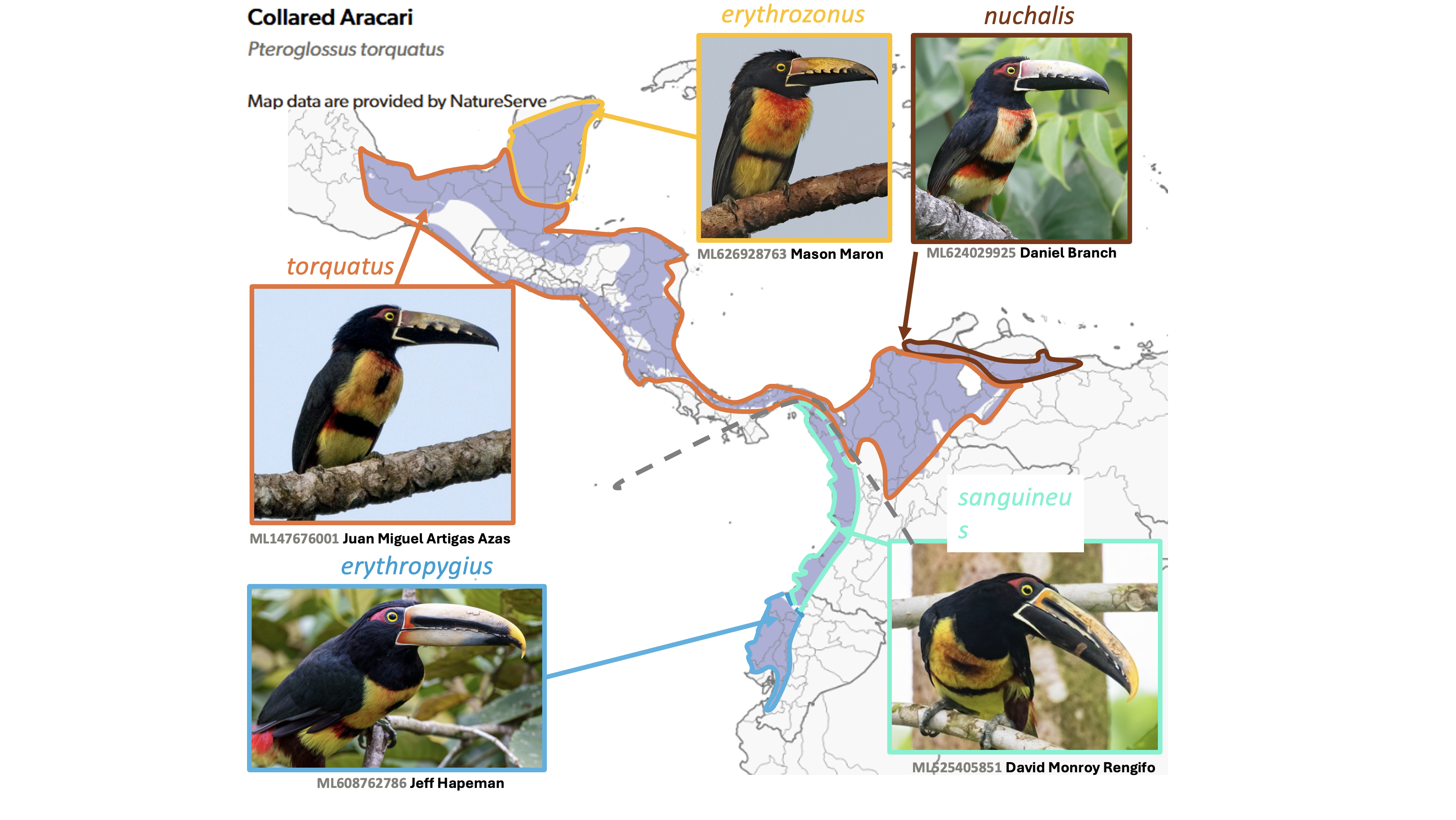
Cliff Parakeet Myiopsitta luchsi is split from Monk Parakeet Myiopsitta monachus. Smaller, more richly colored, and highly localized to cliff sites centered on Cochabamba, Bolivia, the Cliff Parakeet has long been anticipated as a split. The nesting substrate and nesting behavior is quite different between the two species, and the calls are also distinctly different. While this split has been recognized for a long time by the IOC, it took a long time to get across the finish line for SACC, ultimately aided somewhat by the AviList review. This bird gives birders one more reason to visit Bolivia, adding one to the country’s list of striking endemics. Monk Parakeet is one of the most widely introduced parakeets globally, and can be found widely in Mexico City, La Paz (Mexico), Chicago, New York City, Barcelona, Rome, and numerous other famous cities. Cliff Parakeet is virtually unknown in captivity or as an escapee.
- Monk Parakeet Myiopsitta monachus [map] [media] [my records]
-
- RANGE: semi-arid savanna with scattered trees and various grassland habitats in the cerrado from south-central Brazil, in southern Mato Grosso southward to southern Mato Grosso do Sul, Paraná and southern Rio Grande do Sul and southward across Uruguay to central-eastern Argentina, to the provinces of Rio Negro and Chubut; also west to Paraguay, and eastern Bolivia
-
- Cliff Parakeet Myiopsitta luchsi [map] [media] [my records]
-
- RANGE: xeric intermontane valleys of central Bolivia
-
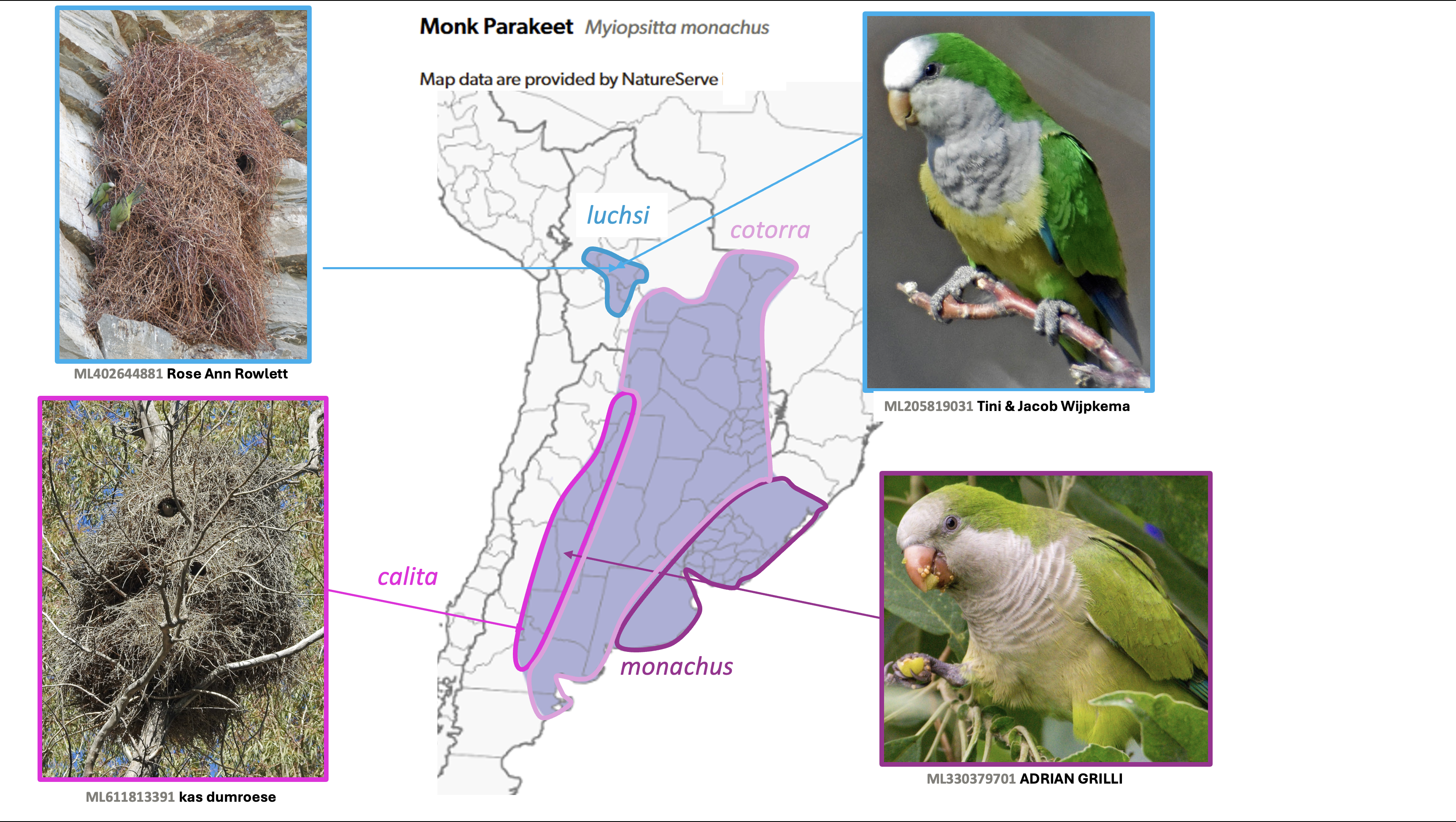
Lilacine Amazon Amazona lilacina and Diademed Amazon Amazona diadema are split from Red-lored Amazon Amazona autumnalis. Both have distinctive head patterns and don’t overlap in range.
- Red-lored Amazon Amazona autumnalis [map] [media] [my records]
-
- RANGE: deciduous to humid forest from the Gulf of Mexico slope in southern Tamaulipas southeastward across the Caribbean lowlands of Central America to Panama, and in the Pacific lowlands of Costa Rica and adjacent Nicaragua, eastward to Panama, including Coiba; in South America in the lowlands of northern Colombia and western Venezuela, southward along the Río Magdalena valley to Valle del Cauca; west of the Andes along the Pacific lowlands of Colombia south to northern Ecuador
-
- Lilacine Amazon Amazona lilacina [map] [media] [my records]
-
- RANGE: southwestern Ecuador (north shore of the Bahia de Caráque in central Manabí southward to El Oro)
-
- Diademed Amazon Amazona diadema [map] [media] [my records]
-
- RANGE: northwestern Brazil (lower Rio Negro and north bank of the upper Amazon River)
-
Since Red-lored and Lilacine Amazons almost come in contact, we have a slash available for conservative reporting (especially useful in central Manabí, Ecuador).
- Red-lored/Lilacine Amazon Amazona autumnalis/lilacina [map] [media] [my records]

Regional Record Change Logic: Subspecies salvini of Red-lored Amazon and Lilacine Amazon are nearly parapatric (their ranges nearly touch) in central Manabí of Ecuador, so birders should identify them there with extreme caution. We have tried to convert the records in accordance with the known range, but we encourage birders to check records from Manabí with care (and update them to the slash, if uncertain, or the correct taxon if you know which you saw). Also, since Amazon parrots are often kept in captivity, please check your records of escapees (although note that Red-lored Amazon is much more frequent in captivity, and as a free-flying exotic species, around the world and the other two are not well-represented in captivity to our knowledge). Because of this, we have assumed that free-flying exotics outside their normal range pertain to Red-lored Amazon.
Subandean Parakeet Pyrrhura subandina, Perija Parakeet Pyrrhura caeruleiceps and Venezuelan Parakeet Pyrrhura emma are split from Pyrrhura picta Painted Parakeet. These taxa have been divided by other taxonomies (e.g., IOC) in various ways, with Sinu Parakeet and Azuero Parakeet often split as separate species. The treatment as four species here follows AviList v2025; note that AOS-NACC and SACC have yet to adopt this revised classification. Still, these birds have distinct plumage and are well separated by range and their differences are commensurate with others in the diverse Pyrrhura genus.
- Subandean Parakeet Pyrrhura subandina [map] [media] [my records]
- Subandean Parakeet (Azuero) Pyrrhura subandina eisenmanni
- RANGE: humid forest in the Azuero Peninsula of southern Panama
- Subandean Parakeet (Sinu) Pyrrhura subandina subandina
- RANGE: Río Sinu valley, north of the western Andes, in Córdoba, Colombia (no recent records and possibly extinct)
- Subandean Parakeet (Azuero) Pyrrhura subandina eisenmanni
- Perija Parakeet Pyrrhura caeruleiceps [map] [media] [my records]
-
- RANGE: west slope of eastern Andes of northern Colombia and Sierra de Perijá
-
- Venezuelan Parakeet Pyrrhura emma [map] [media] [my records]
-
- RANGE: coastal northern Venezuela
-
- Painted Parakeet Pyrrhura picta [map] [media] [my records]
-
- RANGE: southeastern Venezuela to the Guianas and northern Amazonian Brazil (Amapá)
-
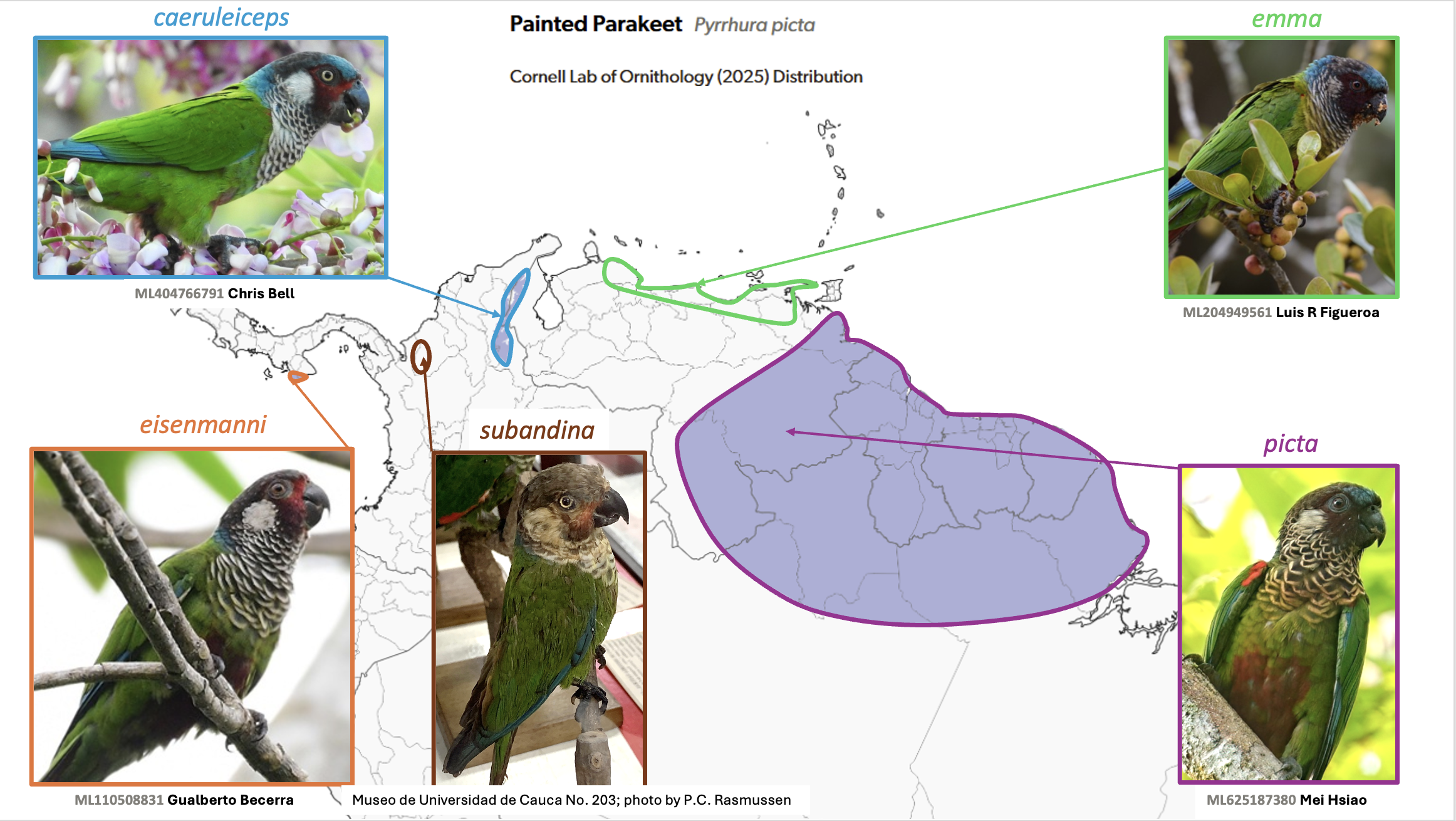
Marañon Antshrike Thamnophilus shumbae is split from Collared Antshrike Thamnophilus bernardi. These two differ in plumage (especially female plumage) and in song, and the dry Marañon Valley is a place well known as a dividing line between species in the north Peruvian Andes, but also for multiple localized or endemic species. Score one more endemic bird for Peru.
- Collared Antshrike Thamnophilus bernardi [map] [media] [my records]
-
- RANGE: arid tropical southwestern Ecuador to north-central Peru); Isla Puná
-
- Marañon Antshrike Thamnophilus shumbae [map] [media] [my records]
-
- RANGE: north-central Peru (Río Marañón drainage in Cajamarca and Amazonas)
-
While the species are currently believed to be almost parapatric (i.e., their ranges almost touch) we don’t actually know of a site where both occur But then again, we don’t know everything there is to know about birds, especially antshrikes in remote Peruvian valleys. We retain the slash as an option for conservative reporting in case one finds birds of the species pair that are not so easily assigned to either of the new species.
- Collared/Marañon Antshrike Thamnophilus bernardi/shumbae [map] [media] [my records]
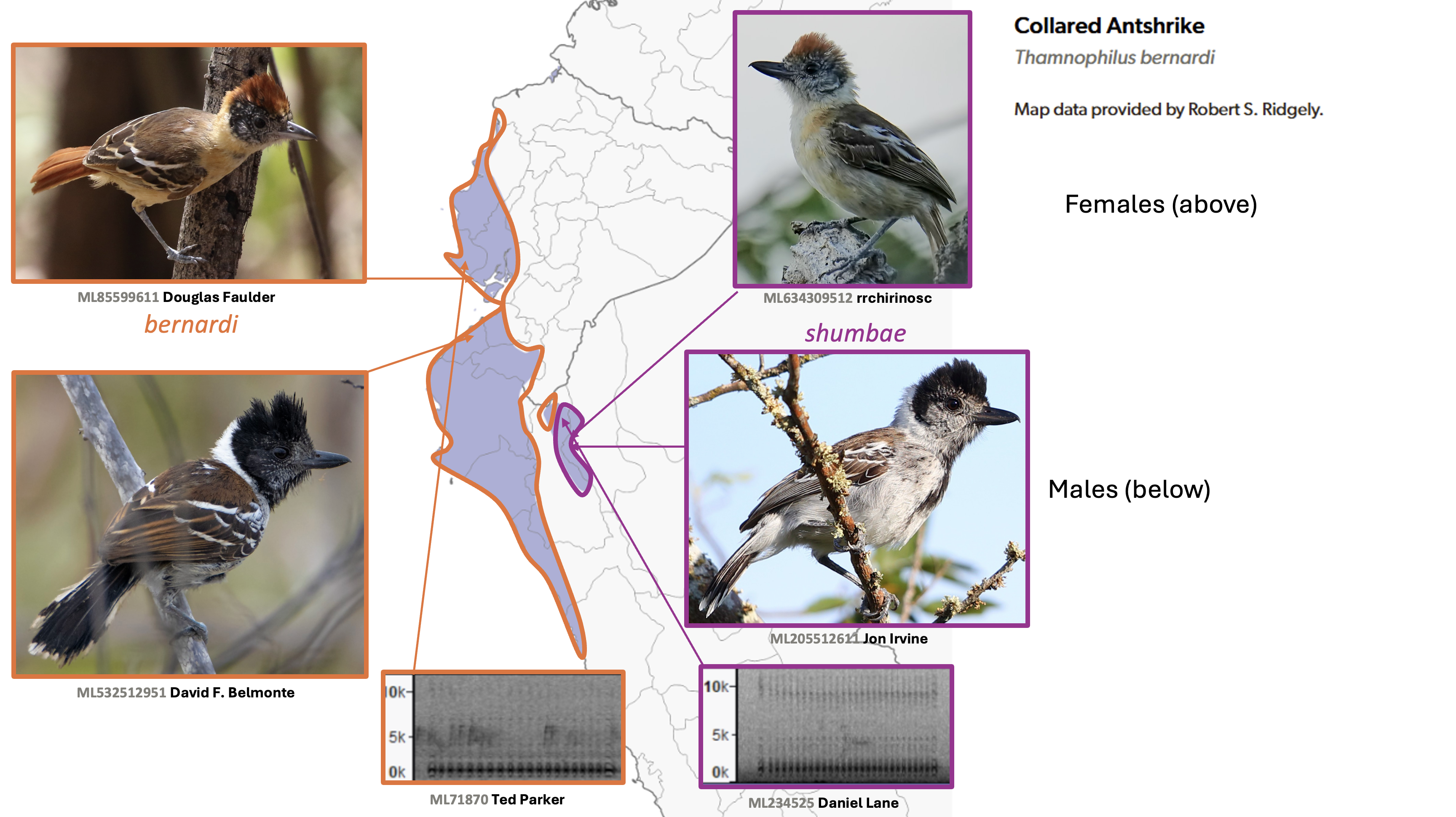
Black-hooded Antthrush Formicarius destructus and Black-capped Antthrush Formicarius nigricapillus are split from Black-hooded Antthrush Formicarius nigricapillus. A recent analysis of the songs, and (subtle!) plumage distinctions, of these two well-separated taxa reveals differences on par with many other species–and we know that songs are especially important to species delimitation in antthrushes (and antpittas, antwrens, antshrikes, antvireos, and ants…actually not the last one). A proposal to SACC paved the way for SACC and then AviList to endorse the species split. One outstanding question, and a goal for intrepid eBirders, is whether Formicarius nigricapillus occurs in Colombia (it likely occurs on Cerro Tacarcuna, which spans the Panama-Colombia border). If it does, it adds a species for South America.
- Black-capped Antthrush Formicarius nigricapillus [map] [media] [my records]
-
- RANGE: Caribbean slope of northwestern to central Costa Rica and both slopes of Panama
-
- Black-hooded Antthrush Formicarius destructus [map] [media] [my records]
-
- RANGE: tropical Pacific Colombia and western Ecuador
-
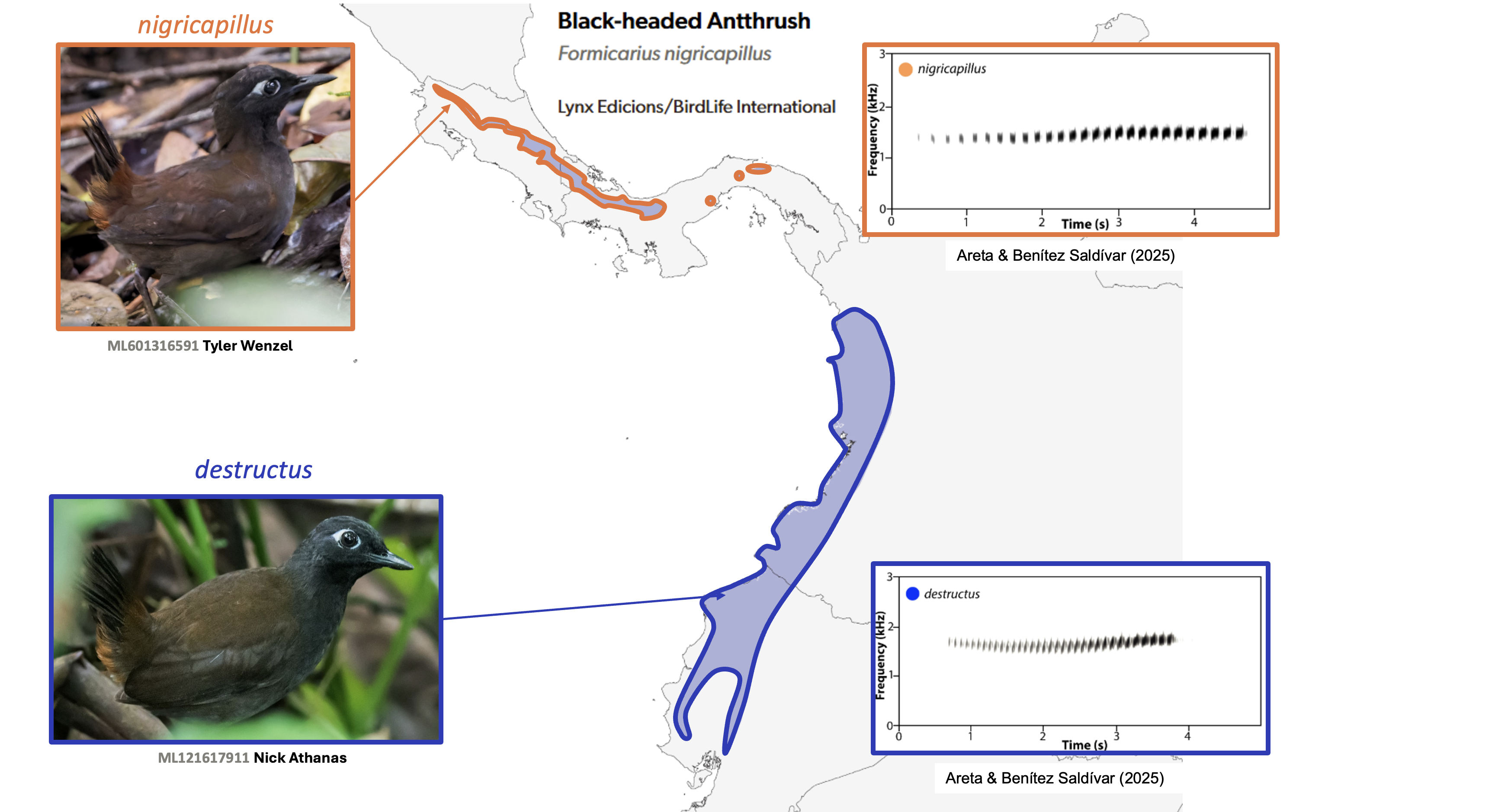
Pale-tailed Canastero Asthenes huancavelicae, Dark-winged Canastero Asthenes arequipae, and Rusty-vented Canastero Asthenes dorbignyi are split from Creamy-breasted Canastero Asthenes dorbignyi. These splits have been recognized in IOC for a long time, were supported by AviList v2025 (not yet by SACC), and are hereby adopted for eBird/Clements. Both have some taxonomic riddles yet to be resolved, particularly related to the undescribed taxa in Pale-tailed and Dark-winged Canasteros. These aren’t hard to find and are well known by birders, they just need some taxonomic legwork to resolve. Still, there could more more news within this complex in the coming years.
- Pale-tailed Canastero Asthenes huancavelicae [map] [media] [my records]
- Pale-tailed Canastero (Santa Valley) Asthenes huancavelicae [undescribed Ancash form] [map] [media] [my records]
- RANGE: arid Andes of northern Peru (Río Santa Valley, southern La Libertad and Ancash)
- Pale-tailed Canastero (Huancavelica) Asthenes huancavelicae huancavelicae [map] [media] [my records]
- RANGE: intermontane valleys of southwestern Peru (Río Mantaro drainage in Huancavelica and western Ayacucho)
- Pale-tailed Canastero (Pale-tailed) Asthenes huancavelicae usheri [map] [media] [my records]
- RANGE: intermontane valleys of south-central Peru (drainages of the Pampas and upper Apurímac river valleys, in northeastern Ayacucho, Apurímac, and southwestern Cusco)
- Pale-tailed Canastero (Santa Valley) Asthenes huancavelicae [undescribed Ancash form] [map] [media] [my records]
- Dark-winged Canastero Asthenes arequipae [map] [media] [my records]
- Dark-winged Canastero (Ayacucho) Asthenes arequipae [undescribed Ayacucho form] [map] [media] [my records]
- RANGE: western Andes of south-central Peru (southern Lima southward to southern Ayacucho)
- Dark-winged Canastero (Southern) Asthenes arequipae [Southern form] [map] [media] [my records]
- RANGE: southwestern Peru (Arequipa, Moquegua, and Tacna) south to northern Chile (Tarapacá) and western Bolivia (La Paz and Oruro); locally also in the Titicaca area in Puno, Peru
- Dark-winged Canastero (Ayacucho) Asthenes arequipae [undescribed Ayacucho form] [map] [media] [my records]
- Rusty-vented Canastero Asthenes dorbignyi [map] [media] [my records]
-
- RANGE: Andes of northwestern Bolivia (La Paz) to northwestern Argentina
-
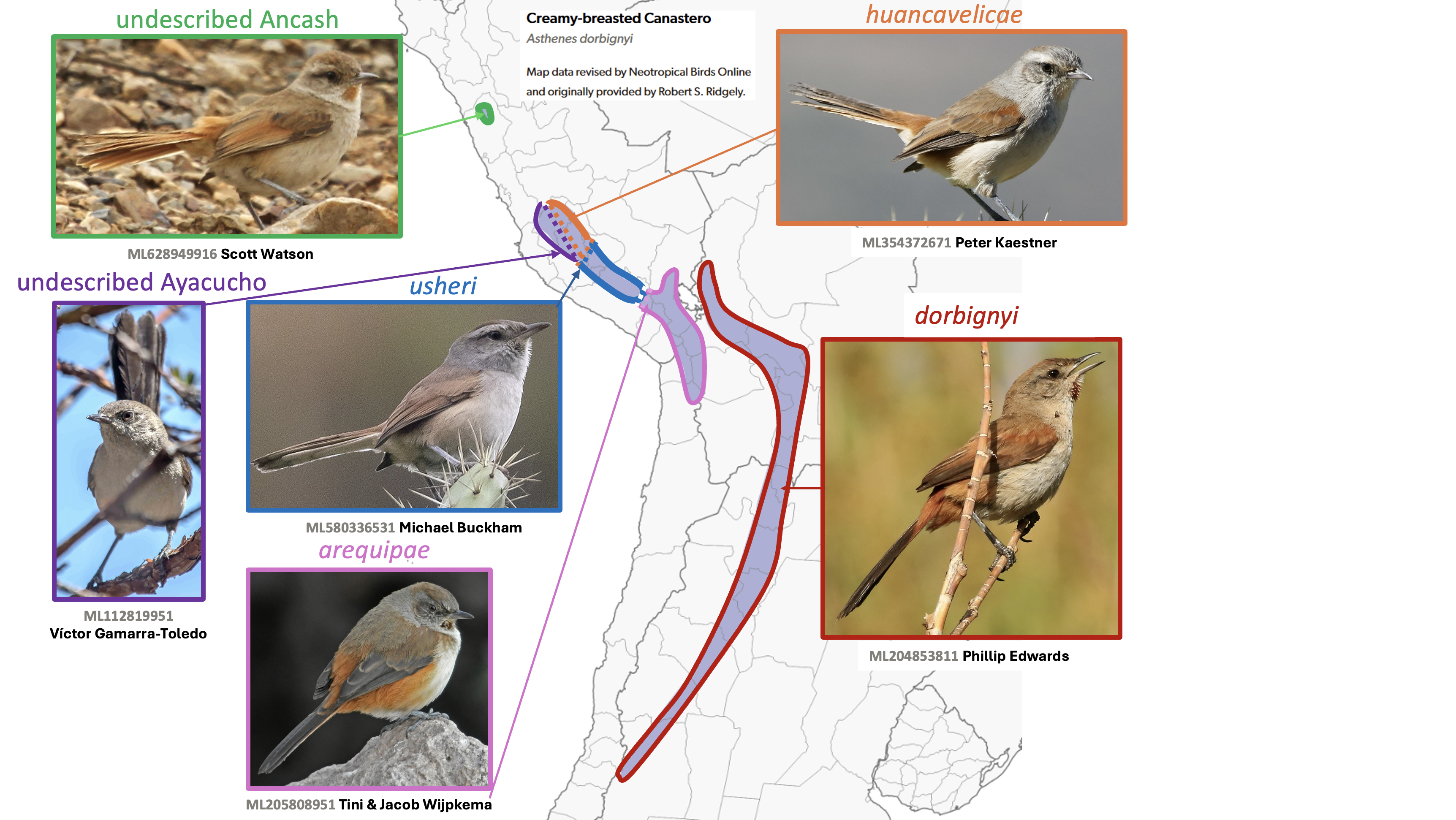
Vilcabamba Spinetail Cranioleuca weskei is split from Marcapata Spinetail Cranioleuca marcapatae. These two taxa differ in crown color and occur nearby to one another in the Andes of central Peru, but contact between them appears to be very limited. One more endemic for Peru!
- Vilcabamba Spinetail Cranioleuca weskei [map] [media] [my records]
-
- RANGE: Andes of south-central Peru (Mantaro Valley in southeastern Junín, northern Ayacucho, and southward to Cordillera Vilcabamba in Cusco)
-
- Marcapata Spinetail Cranioleuca marcapatae [map] [media] [my records]
-
- RANGE: southern Peru in Vilcanota and Carabaya Ranges (Cuzco)
-
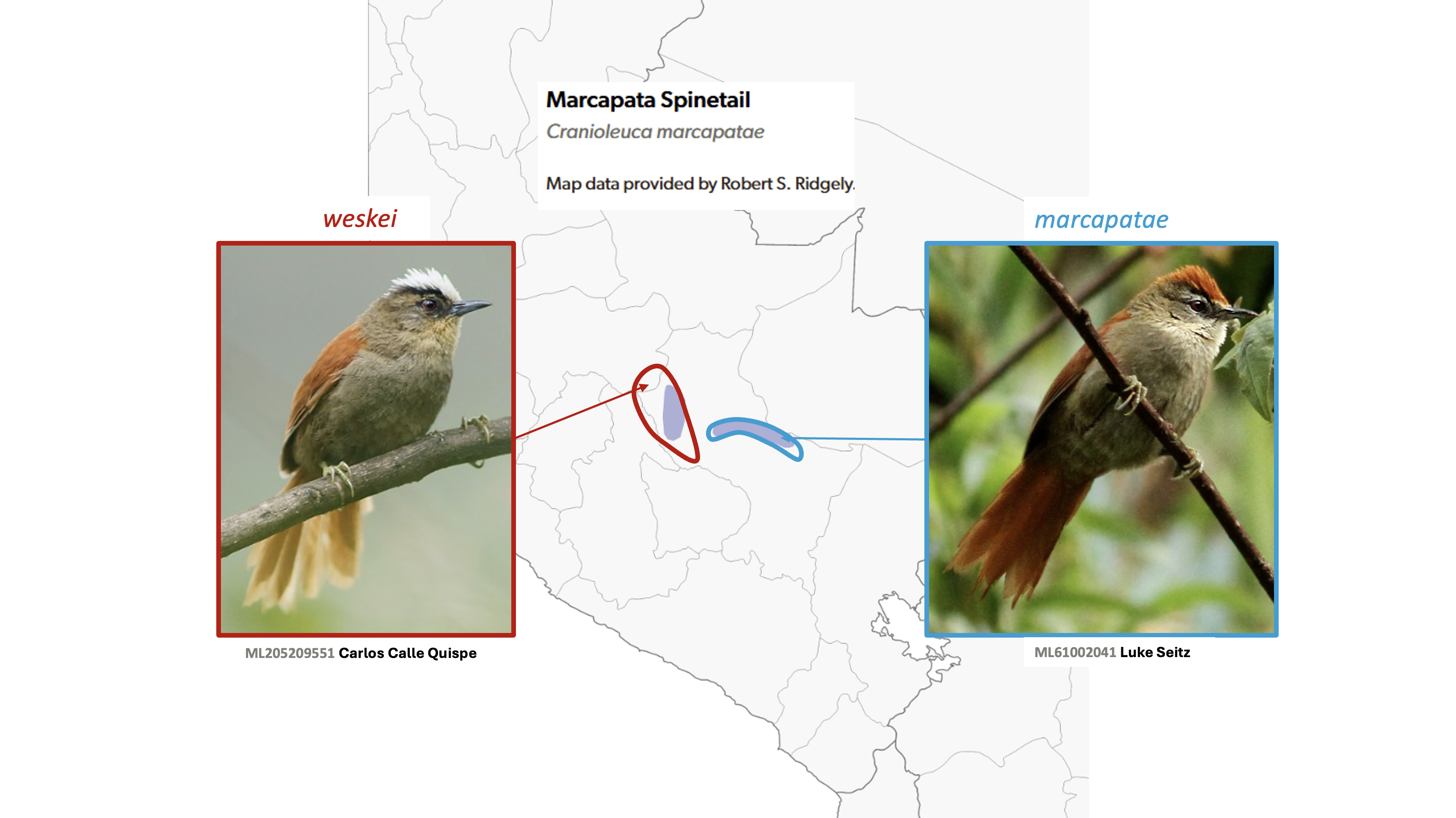
Regional Record Change Logic: While most records are easily assigned, and both species are well documented over most of their ranges, we had to make assumptions around a few unvouchered records southeast of Vitcos, Cusco. If you have observed either species in the area, please check your records.
Blue Mountain Elaenia Elaenia fallax and Hispaniolan Elaenia Elaenia cherriei are split from Greater Antillean Elaenia Elaenia fallax. The two species are quite similar, but differ subtly and consistently in vocalizations. It is increasingly rare that taxa that occur across multiple major islands in the Greater Antilles are proving to represent the same species. This split adds an endemic for each island. Note that the AOS-NACC has yet to endorse this split.
- Blue Mountain Elaenia Elaenia fallax [map] [media] [my records]
-
- RANGE: humid montane forest of Jamaica
-
- Hispaniolan Elaenia Elaenia cherriei [map] [media] [my records]
-
- RANGE: humid montane forest of Hispaniola
-
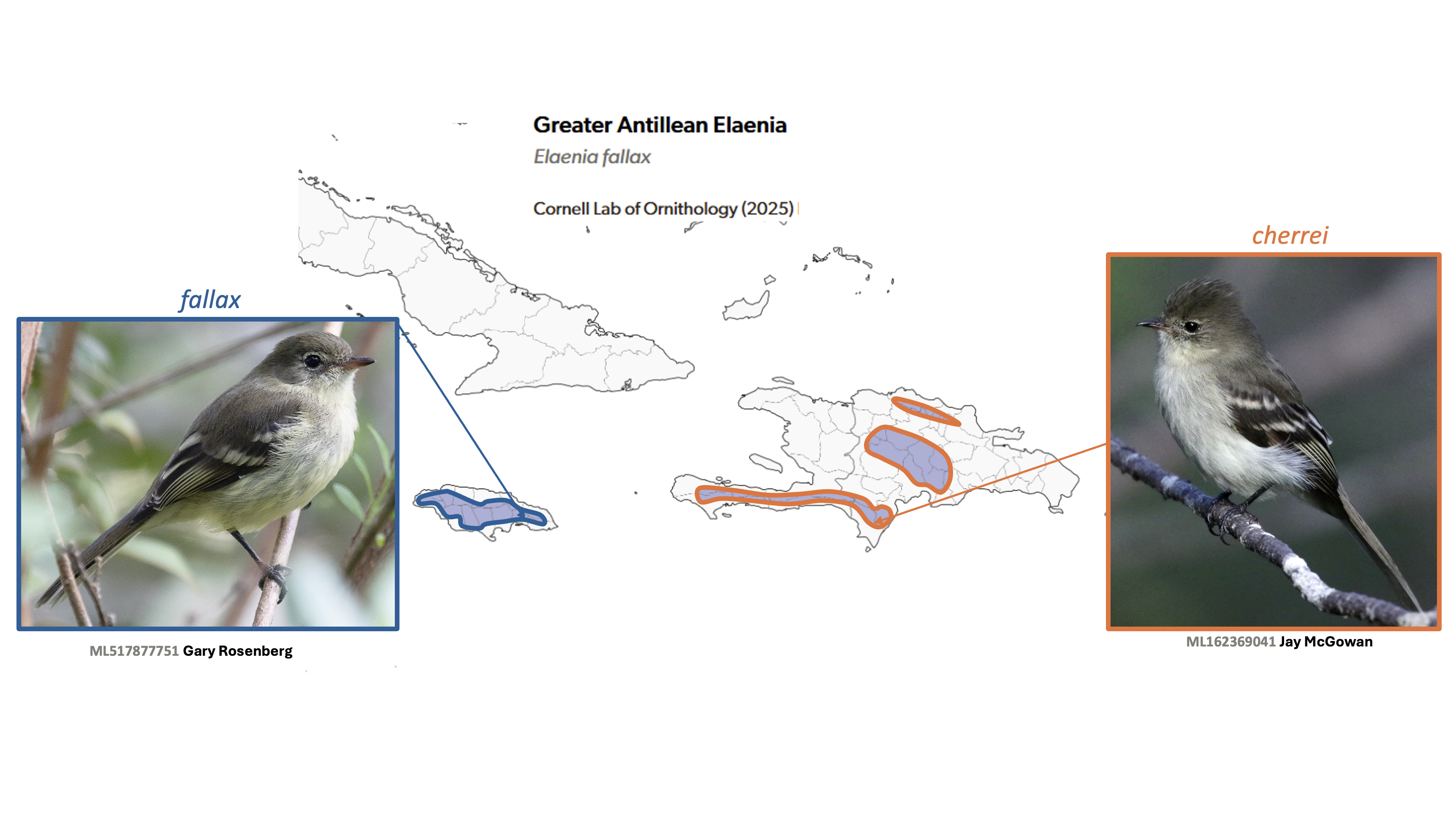
Salvadoran Flycatcher Myiarchus flavidior is split from Nutting’s Flycatcher Myiarchus nuttingi. This is a fairly new split, and although it had been proposed more than a decade ago (in 2013), it was initially not approved. New evidence, including lots more photos, vocal material, and results of playback experiments helped this proposal to pass AOS-NACC this year and has also now been more widely adopted by AviList, eBird/Clements, and (soon) IOC. Myiarchus flycatchers are extremely similar and pose enormous field identification problems, and this species pair is one of the hardest to distinguish. Vocalizations are the key to these two: a long, overslurred wheeéu in Salvadoran:
Versus a clipped, abrupt weep in Nutting’s:
Listen also for a long piping twitter, or trill, that is unique to Salvadoran (Howell et al. 2024):
In plumage, there is less to go on, but Salvadoran averages slimmer, with a more slender bill and often brighter yellow underparts. Obviously, make sure to eliminate Ash-throated (and Brown-crested, Dusky-capped, and Great Crested) Flycatcher as well!
- Nutting’s Flycatcher Myiarchus nuttingi [map] [media] [my records]
-
- RANGE: semiarid western Mexico (northern Sonora and southwestern Chihuahua southward to Chiapas) and central Mexico, and arid interior montane valleys of Chiapas to northwestern Costa Rica
-
- Salvadoran Flycatcher Myiarchus flavidior [map] [media] [my records]
-
- RANGE: Pacific lowlands of southern Mexico (Chiapas) to western Nicaragua, and arid interior valleys of Honduras
-
Given the huge identification problems, we will retain a slash to cover older records or birds that can’t be safely identified:
- Nutting’s/Salvadoran Flycatcher Myiarchus nuttingi/flavidior [map] [media] [my records]
and since Ash-throated is itself very very hard to separate from Nutting’s, we end up with three slashes now to cover this new complexity.
- Ash-throated/Nutting’s Flycatcher Myiarchus cinerascens/nuttingi [map] [media] [my records]
- Ash-throated/Salvadoran Flycatcher Myiarchus cinerascens/flavidior [map] [media] [my records]
- Ash-throated/Nutting’s/Salvadoran Flycatcher Myiarchus cinerascens/nuttingi/flavidior [map] [media] [my records]
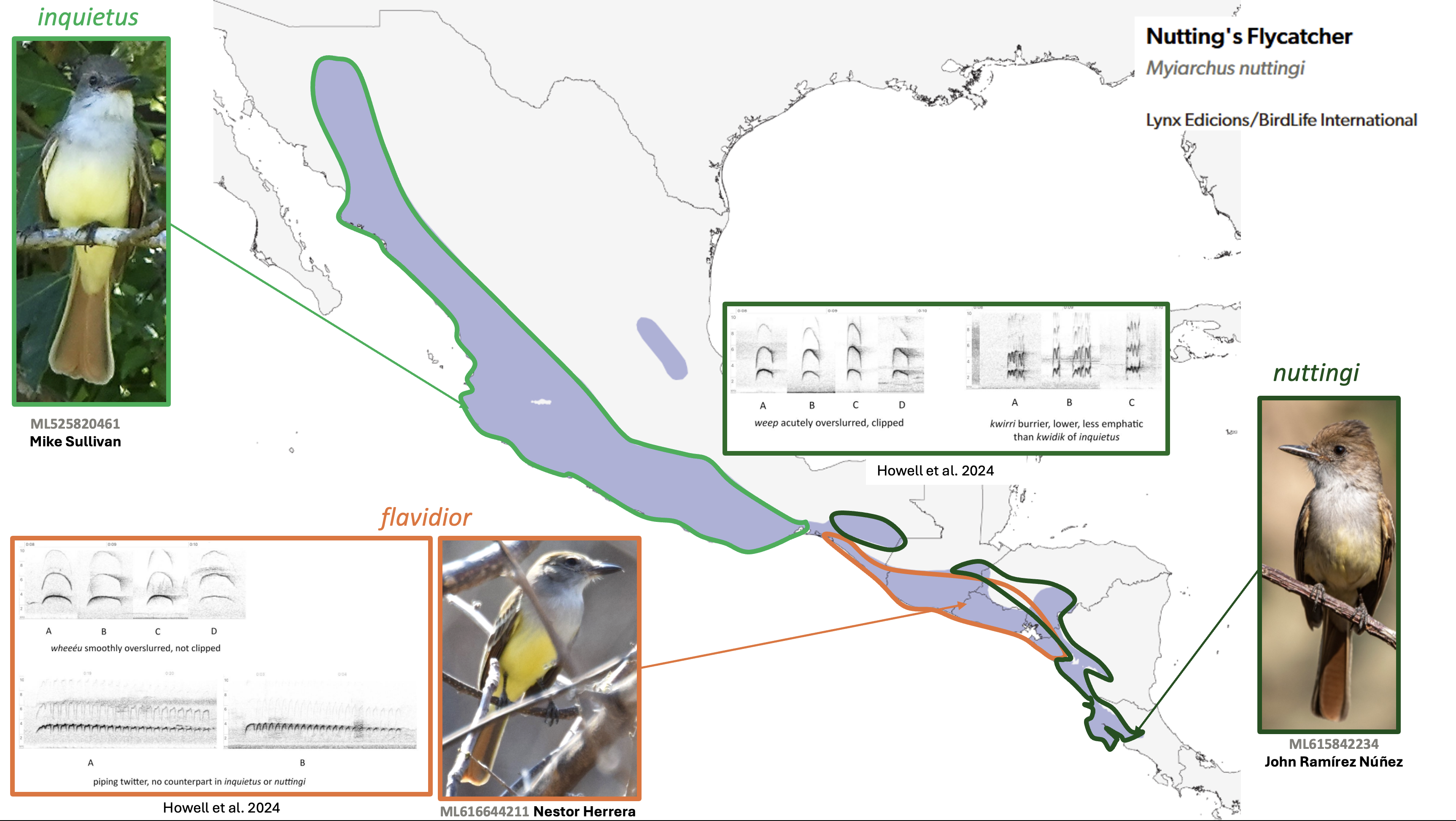
Regional Record Change Logic: As shown in the above map, these two species mostly do not come in contact, so most of Mexico and all of Costa Rica will pertain to Nutting’s Flycatcher. We do know of several areas where the species come in contact (although in those areas they segregate by habitat, with Nutting’s preferring dry thorn forest and Salvadoran being more a bird of open dry forest and patchy landscapes interrupted by agriculture). These contact zones include eastern Oaxaca and western Chiapas in Mexico, central-eastern Guatemala and southern Honduras, and extreme northwestern Nicaragua. In these areas most records will remain as a slash, unless observers have clearly identified them to species by vocalizations. The records closest to the coast (generally south/east of the Panamerican Highway) will pertain to Salvadoran. Only Salvadoran is known from El Salvador, so all records from that country have been converted to the aptly-named Salvadoran.
Ochre-crowned Greenlet Tunchiornis ochraceiceps, Rufous-fronted Greenlet Tunchiornis ferrugineifrons, Guianan Greenlet Tunchiornis luteifrons, and Para Greenlet Tunchiornis rubrifrons are split from Tawny-crowned Greenlet Tunchiornis ochraceiceps. This formerly widespread species is now split, based on vocal, plumage, and deep genetic differences, along familiar biogeographic boundaries in the Neotropics. Ochre-crowned is the Central American and trans-Andean bird (opposite side of the mountains from Amazonia); Rufous-fronted occurs in western Amazonia; Guianan is centered, as the name suggests, on the Guianan shield (north of the Amazon and east of the Rio Branco); and Para Greenlet occurs in eastern Amazonia, south of the Amazon River and east of the Madeira River. More detail can be seen in the SACC proposal.
- Ochre-crowned Greenlet Tunchiornis ochraceiceps [map] [media] [my records]
-
- RANGE: Gulf lowlands of southern Mexico to western Ecuador
-
- Rufous-fronted Greenlet Tunchiornis ferrugineifrons [map] [media] [my records]
-
- RANGE: southeastern Colombia eastward to southern Venezuela, far western Guyana, and western Brazil (west of the Río Negro), southward to eastern Peru and northern Bolivia
-
- Guianan Greenlet Tunchiornis luteifrons [map] [media] [my records]
-
- RANGE: far eastern Venezuela (eastern Bolívar), the Guianas, and northern Amazonian Brazil (east of the Rio Negro)
-
- Para Greenlet Tunchiornis rubrifrons [map] [media] [my records]
-
- RANGE: northern Brazil south of the Amazon River (Rio Madeira to Pará)
-
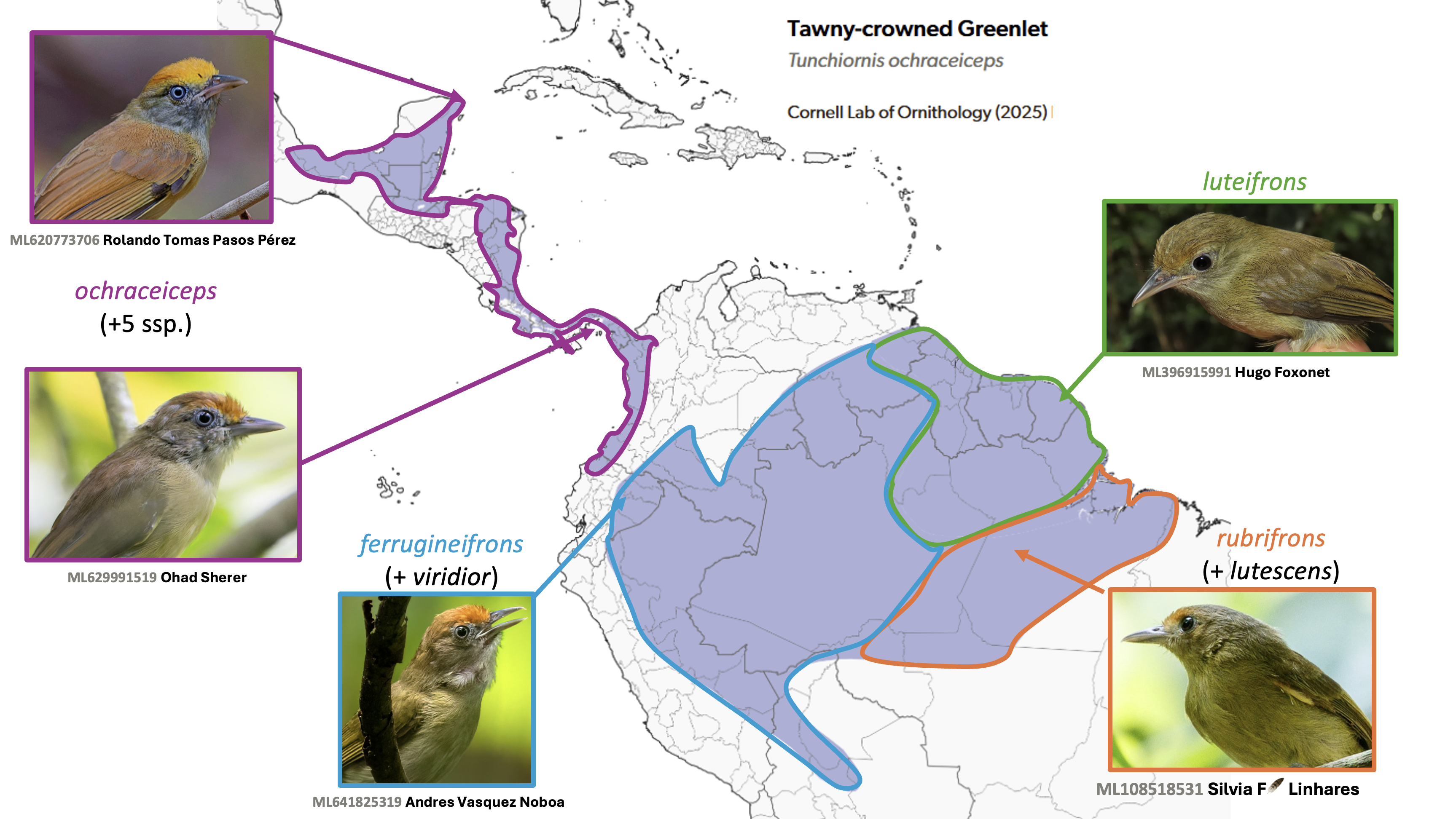
Western Warbling Vireo Vireo swainsoni and Eastern Warbling Vireo Vireo gilvus are split from Warbling Vireo Vireo gilvus. If you thought Philadelphia Vireo was hard to separate from Warbling Vireo (and they can be!), brace yourself for this one. Now that Western Flycatcher has been re-lumped, these vireos may take the cake and knock Willow and Alder Flycatcher out of the top spot for the most challenging field identification problem (of silent birds) in the United States and Canada.
Given pronounced differences in voice, and mounting evidence about differences in molt timing and genetics, this split has been on birders’ radar for a long time so should not come as a total surprise.
Identification by voice is possible in most cases for singing birds, but requires care and practice. Both birds give pleasant rambling warbles, but Eastern Warbling Vireo jumps up and down in pitch and varies in the strength of delivery in a rollicking pattern that consistently ends in a rising, upslurred final note. Their song has been described as “If I see you, I will seize you, and I’ll squeeze you till you squirt!”, but Western Warbling would never be described that way. Its song is different enough that birders from the East might wonder what finch is singing, but focus on the final note (which tends not to have a pronounced upslur) and the less rollicking, more steady warble, and you should quickly be able to get a handle on these two species. Intermediate songs do occur, and may occur where these two come in contact, so be cautious. We are not currently aware of differences in the call notes, and since these birds only really sing from April to July (rarely into September), and mostly do that on or near their breeding grounds, that leaves a lot of the year and a whole lot of the continent where these birds truly can’t be identified.
For those ready to dig in and help clarify how one might identify these birds in the field, here are a few starting points. First, be careful: while there is just one subspecies of Eastern Warbling, there are no fewer than four subspecies of Western, with two restricted to Mexico: sympatricus (resident in south-central Mexico; potentially a controversial one since it could be ore allied with Brown-capped Vireo) and victoriae (Sierra de la Laguna, Baja California Sur). The other two break out as swainsoni, a Pacific slope bird (breeds Alaska to northern Baja California), and brewsteri, the Rocky Mountains bird breeding from Montana to west-Texas and south to Oaxaca in Mexico. Be aware that there may be subtle differences to contend with between those two.
A vagrant Western in Cape May, New Jersey, was critically studied and photographed at close range and the checklist comments here give a good indication of how to use molt, structure, and subtle plumage queues to identify a vagrant (this one was confirmed genetically, thankfully!). Note that records have been changed in bulk to one or the other species, but some unseasonal records in winter and late fall should be reverted by observers, or questioned by reviewers, since out of season birds cannot be safely assumed to pertain to the local breeding taxon and, in fact, the opposite taxon could be more likely out of season!
- Eastern Warbling Vireo Vireo gilvus [map] [media] [my records]
-
- RANGE: breeds southern Canada from central Alberta eastward to southern Nova Scotia and southward to the northern parts of southeastern US states, but mostly from northern Oklahoma, Kentucky, and New Jersey northwards; winters from southern Mexico to northeastern Costa Rica
-
- Western Warbling Vireo Vireo swainsoni [map] [media] [my records]
-
- RANGE: breeds in deciduous and coniferous forest edge-wetland ecotones, and riparian woodland from southern Yukon and central Northwest Territories (northwestern Canada) and southwestern Alaska eastwards through central Alberta (southwestern Canada), southwards to northern Baja California and disjunctly in far southern Baja California, mountains of mainland Mexico to Oaxaca; winters mostly on the Pacific slope of northwestern Mexico (southern Sonora) southwards to Oaxaca
-
Many many many of these vireos will not be identifiable in the field, so this slash will be very useful, especially in migration and wintering grounds.
- Eastern/Western Warbling Vireo Vireo gilvus/swainsoni [map] [media] [my records]
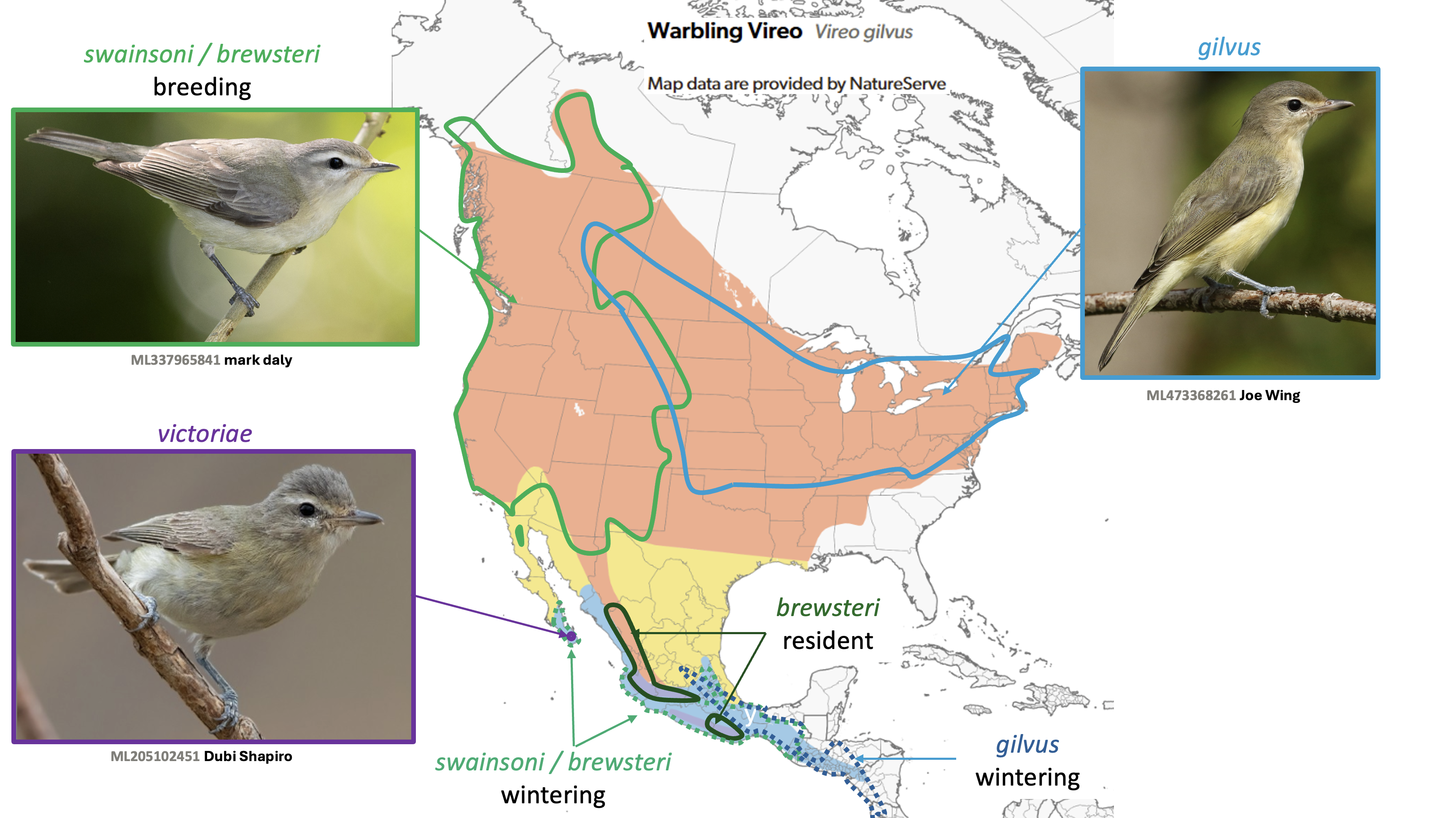
Regional Record Change Logic: This is a VERY complicated split and record conversion may take a month to get correct. Please be patient. The VAST MAJORITY of breeding area records have been converted to the correct species, but the contact zone (Great Plains in migration and breeding contact in Colorado, Nebraska, Wyoming, South Dakota, and Alberta) will need to be adjusted at a very fine scale. The initial subdivisions in the contact zones have been as follows:
- Texas: presumed to be Western Warbling Vireo in the western trans-Pecos counties of El Paso, Hudspeth, Culbertson, Jeff Davis, Presidio and Brewster (Western Warbling Vireo breeds in a few of these and predominates in migration); presumed to be Eastern Warbling Vireo from the 100th meridian eastwards; and presumed to be Eastern in the areas in between if seen between 5 June and 31 July, which is a date range suggesting territorial Eastern Warbling (and only Eastern would occur in those areas).
- Oklahoma, Kansas, Nebraska: converted to eastern in counties from the 100th meridian eastwards; birds west of there are treated as a slash, unless the observer has explicitly identified to species. Migrants are known and may be possible in those more westerly counties; in Nebraska Western has been known to breed in the Pine Ridge area, but seems to be extremely rare.
- South Dakota: converted to Eastern in counties east of the two westernmost tiers, including Harding, Perkins, Butte, Meade, Lawrence, Pennington, Custer, Oglala Lakota, and Fall River counties. Western is known as a common breeder in the Black Hills, while Eastern occurs in most of those counties as a lowland breeder, so observers must change those themselves.
- Colorado: presumed to pertain to Western in mountainous counties from the Front Range westward. The counties of Larimer, Boulder, Gilpin, Jefferson, Douglas, Teller, El Paso, Pueblo, Huerfano, and Las Animas, and counties to the east are treated as a slash, unless the observer has explicitly identified to species (although some breeding areas where only one species is known have been converted to the expected species).
- Wyoming: presumed to pertain to Western in mountainous counties from Big Horn, Washakie, Natrona, Carbon, and Albany and west; birds east of there are treated as a slash, unless the observer has explicitly identified to species
- North Dakota: all presumed to pertain to Eastern Warbling Vireo
- Montana: <in progress>
- Saskatchewan: all presumed to pertain to Eastern Warbling Vireo EXCEPT in Maple Creek County, where Western Warbling is known as a common breeder in the Cypress Hills; birds in Maple Creek County are treated as a slash, unless the observer has explicitly identified to species.
- Manitoba: <in progress>
- British Columbia, Yukon Territory, Northwest Territory, Alaska: all presumed to pertain to Western Warbling Vireo
In migration and winter, we feel safe assuming that the Baja California peninsula, Sonora, Sinaloa, Nayarit, Jalisco, and Colima pertain to Western Warbling Vireo, but records south of there could pertain to either species. We continue to work to refine records based on reliable information.
Note that records have been changed in bulk to one or the other species, but some unseasonal records in winter and late fall should be reverted by observers, or questioned by reviewers, since out of season birds cannot be safely assumed to pertain to the local breeding taxon and, in fact, the opposite taxon could be more likely out of season!
Western Red-legged Thrush Turdus plumbeus and Eastern Red-legged Thrush Turdus ardosiaceus are split from Red-legged Thrush Turdus plumbeus. These two taxa differ strongly in appearance and have been previously suggested for a split, with this split following that adopted by AviList v2025. Note that BirdLife International has previously split the Cuban and Bahamas birds as well.
There is one new group, this year: Western Red-legged Thrush (Cuban Slaty) Turdus plumbeus schistaceus. This is a split from Western Red-legged Thrush (Rusty-bellied) Turdus plumbeus [rubripes Group] which was previously called Western Red-legged Thrush (Cuban) Turdus plumbeus [rubripes Group]. It can be recognized by its slaty belly, which is washed in rufous in Rusty-bellied; the two have a broad intergrade zone in northeastern Cuba, beginning in east-central Holguín and extending west from there. Report as the intergrade if the bird is intermediate (or at the species level, which is always fine!)
- Western Red-legged Thrush Turdus plumbeus [map] [media] [my records]
- Western Red-legged Thrush (Bahamas) Turdus plumbeus plumbeus [map] [media]
- RANGE: northern Bahamas southward to Andros and Cat Island
- Western Red-legged Thrush (Rusty-bellied) Turdus plumbeus [rubripes Group] [map] [media]
- RANGE: central and western Cuba and Isla de la Juventud and Cayman Brac (eastern Cayman Islands); extinct (and lost!) subspecies perditus formerly on Swan Islands (north of Honduras)
- Western Red-legged Thrush (Cuban Slaty) Turdus plumbeus schistaceus [map] [media]
- RANGE: eastern Cuba (Holguín, Santiago de Cuba, and Guantánamo provinces)
- Western Red-legged Thrush (Bahamas) Turdus plumbeus plumbeus [map] [media]
- Eastern Red-legged Thrush Turdus ardosiaceus [map] [media] [my records]
-
- RANGE: Hispaniola, including Gonâve and Tortue islands, Puerto Rico, and Dominica (Lesser Antilles)
-
The Rusty-bellied and Cuban Slaty subspecies groups do hybridize, so an intergrade is added for those:
- Western Red-legged Thrush (Rusty-bellied x Cuban Slaty) Turdus plumbeus rubripes x schistaceus [map] [media]
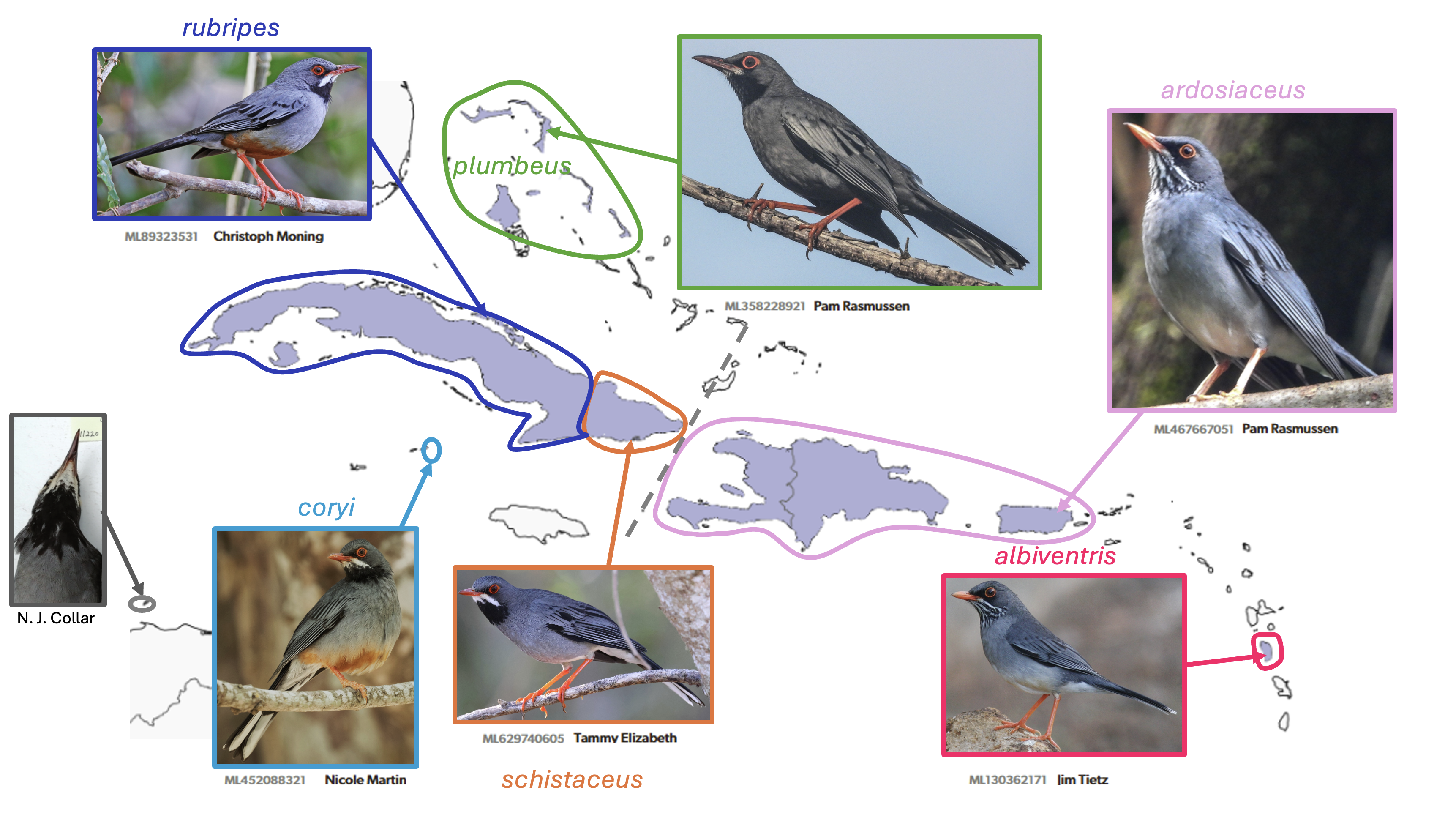
Dagua Thrush Turdus daguae is split from White-throated Thrush Turdus assimilis. Although Dagua Thrush replaces White-throated to the east of the Isthmus of Panama, genetics show they are not each other’s closest relatives. There may be more splits to come in a closely related species: the White-necked Thrush Turdus albicollis.
- White-throated Thrush Turdus assimilis [map] [media] [my records]
-
- RANGE: highlands of northwestern Mexico (southeastern Sonora), southwestern Tamaulipas, and eastern San Luis Potosí to northwestern Ecuador
-
- Dagua Thrush Turdus daguae [map] [media] [my records]
-
- RANGE: eastern Panama (Darién) to western Colombia and locally in southwestern Ecuador
-
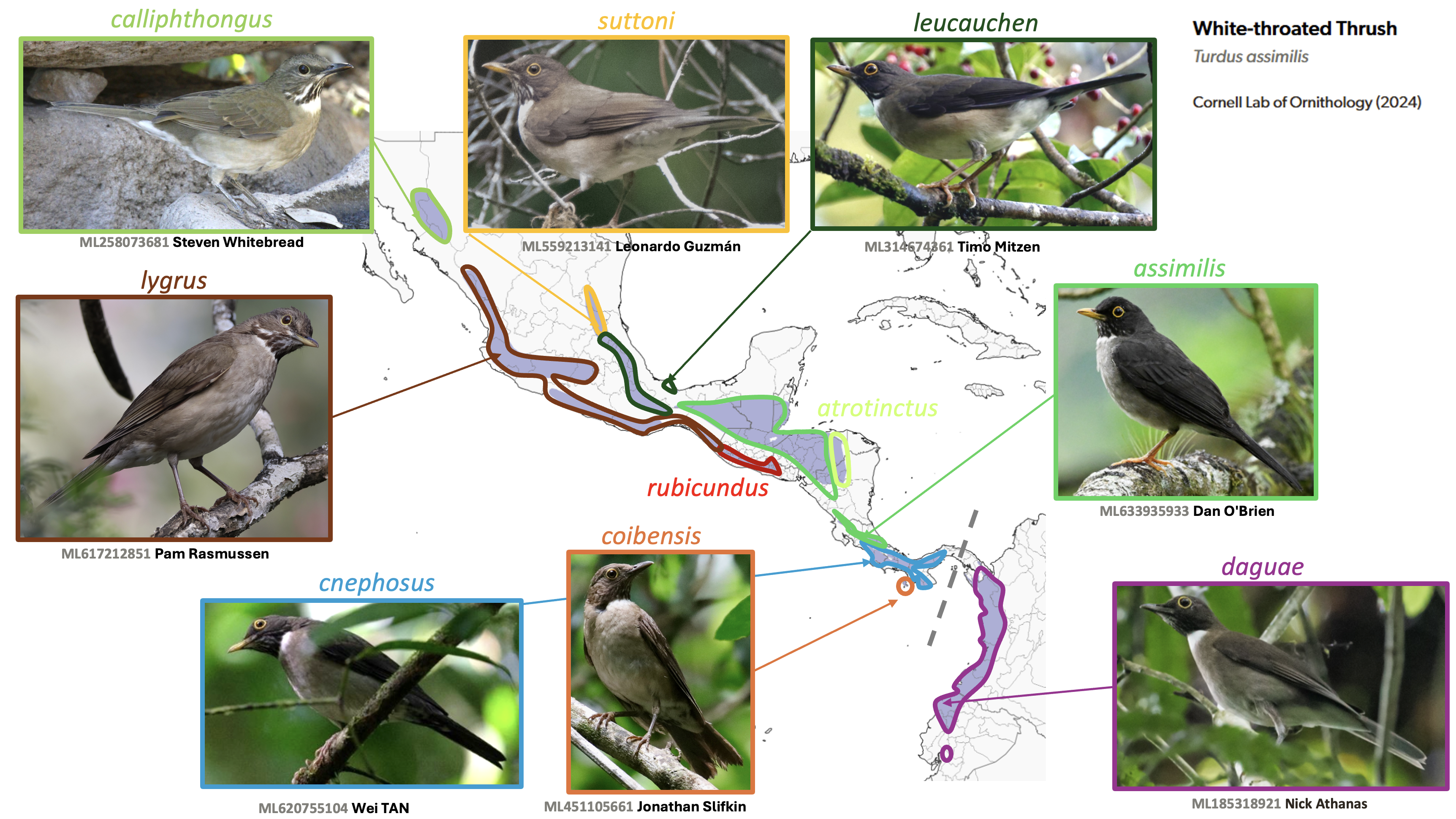
Yellow-mandibled Sparrow Arremon axillaris is split from Pectoral Sparrow Arremon taciturnus. While Pectoral is widespread, Yelow-mandobled is restricted to the east slope of the eastern Andes, from central Colombia into Venezuela.
- Yellow-mandibled Sparrow Arremon axillaris [map] [media] [my records]
-
- RANGE: base of eastern Andes in Venezuela (Portuguesa southward to eastern Táchira) and Colombia (Boyacá, Casanare and Meta)
-
- Pectoral Sparrow Arremon taciturnus [map] [media] [my records]
-
- RANGE: eastern Colombia to southern Venezuela, the Guianas, and Amazonian Brazil to southeastern Peru and northern Bolivia (eastward to western and northern Santa Cruz)
-
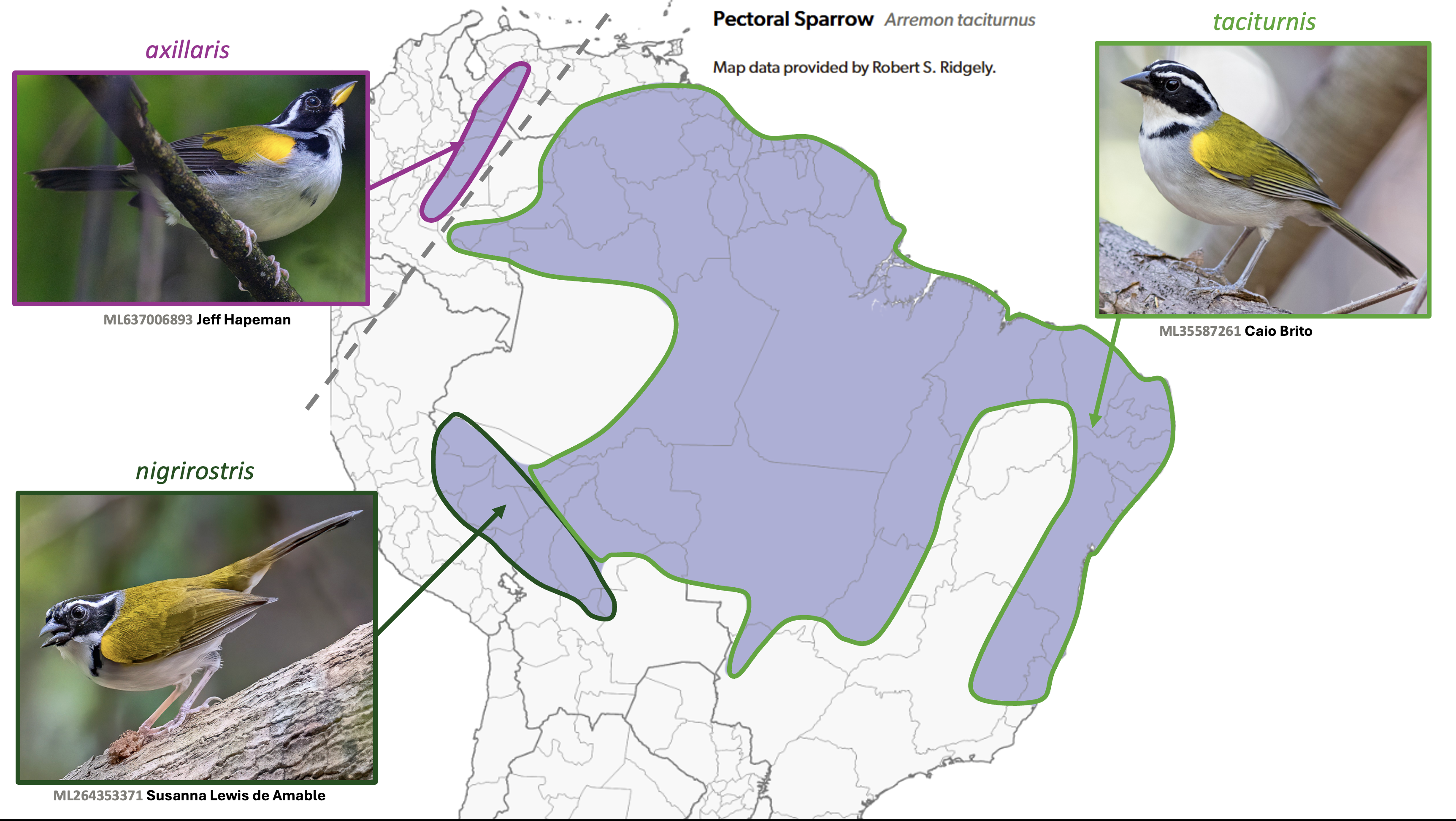
Regional Record Change Logic: As these species are almost entirely allopatric, most records were easily assigned. However, there is some uncertainty in western Meta, where photographed records of Pectoral Sparrow occur very close to ones of Yellow-mandibled. Un-vouchered records between the two were assigned as best as possible, but you may wish to check your records from this region if you have any.
Gray-crowned Ground-Sparrow Melozone occipitalis is split from White-eared Ground-Sparrow Melozone leucotis. These two are well separated by range and although similar in plumage, are here treated as separate species.
- Gray-crowned Ground-Sparrow Melozone occipitalis [map] [media] [my records]
-
- RANGE: highlands of southern Mexico (Chiapas) to Guatemala and El Salvador
-
- White-eared Ground-Sparrow Melozone leucotis [map] [media] [my records]
-
- RANGE: highlands of east-central Honduras, north-central Nicaragua, and central Costa Rica
-
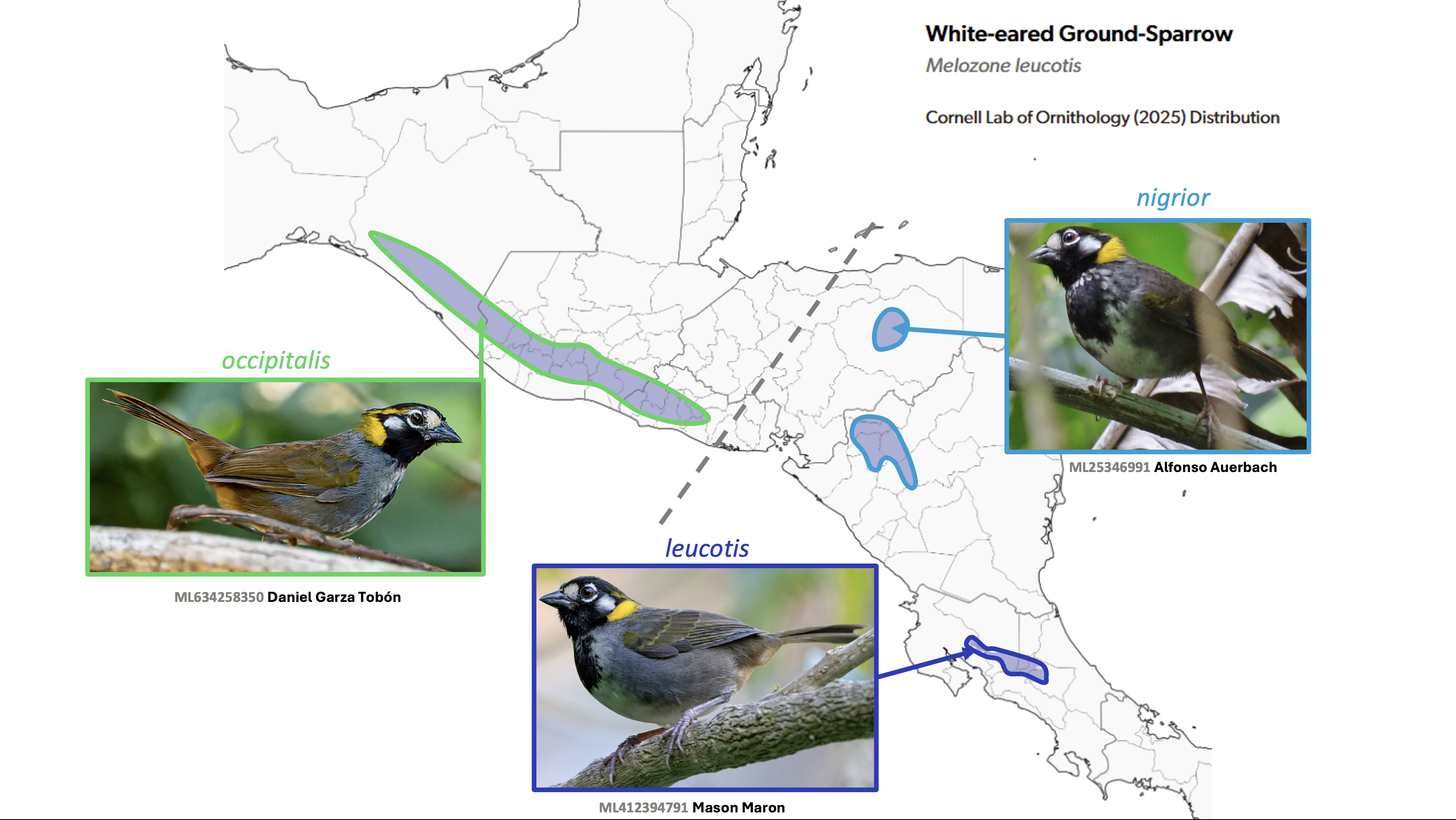
Black-fronted Brushfinch Atlapetes nigrifrons is split from Yellow-breasted Brushfinch Atlapetes latinuchus. The highly range restricted species Black-fronted Brushfinch gives another reason to visit the endemic-rich Perija Mountain range of northeastern Colombia and northwestern Venezuela. What genetic information we have at this stage suggests that despite similar plumage, these two species are not each other’s closest relatives.
- Black-fronted Brushfinch Atlapetes nigrifrons [map] [media] [my records]
-
- RANGE: Perijá Mountains (far northeastern Colombia and far western Venezuela)
-
- Yellow-breasted Brushfinch Atlapetes latinuchus [map] [media] [my records]
-
- RANGE: subtropical northern central Andes of Colombia (Antioquia) south to upper Marañón Valley in Cajamarca and La Libertad of Peru
-
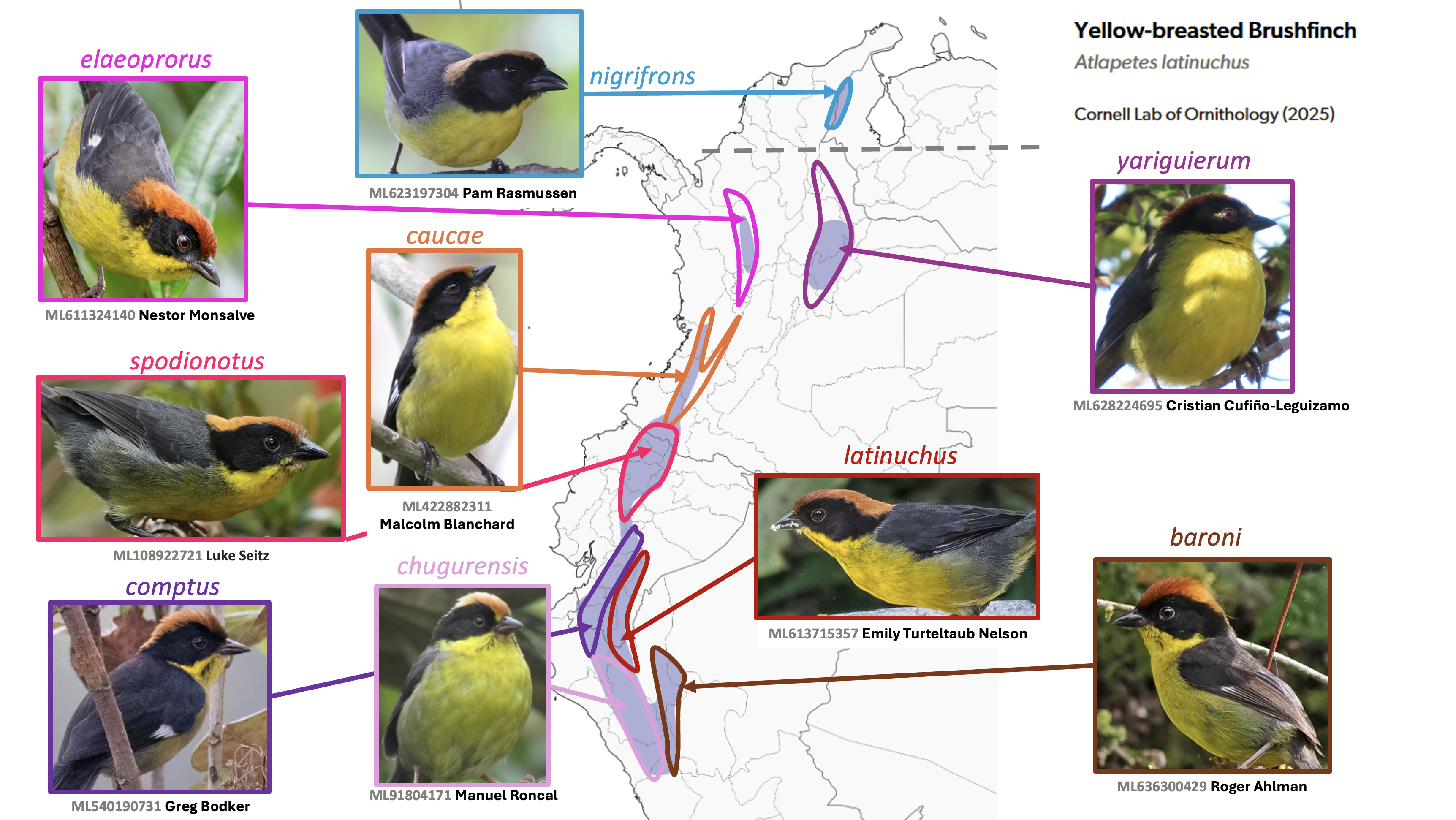
Northern Yellow Warbler Setophaga aestiva and Mangrove Yellow Warbler Setophaga petechia are split from Yellow Warbler Setophaga petechia.
This split has been long anticipated, but it took many years for enough evidence to accrue for it to be adopted here. As is often the case, entirely migratory taxa and entirely resident taxa probably don’t have much gene flow, so the question with respect to species limits depends more on how long they have been isolated and how much gene flow might happen if they somehow came into contact. Note that AOS-NACC did consider this split recently and opted against it, so this is one of few cases where eBird/Clements taxonomy differs from that of the North American Classification Committee (and also SACC). However, the IOC has long adopted this split and this year it was also adopted by AviList v2025.
This split is a tricky one for eBird to implement, because Northern Yellow Warbler overlaps extensively in range and habitat with Mangrove Yellow Warbler. The two species can sometimes be found in the same flock or even the same binocular view. It is also a tricky split because the window of dates when Northern Yellow Warbler is not possible on its wintering grounds is extremely narrow (late May to mid-July) which means that we truly don’t have a way to separate records out from much of the range. However, Mangrove Yellow Warbler, in all populations, is tied VERY closely to mangrove habitats near the coasts. That means that we can safely assume that a Yellow Warbler more than a kilometer or two from coastal mangroves is sure to be a Northern Yellow Warbler. There are a very few instances (but only very few; most remarkably a bird in central Arizona and another at the Salton Sea of California) that show that Mangrove Yellow Warbler can stray far from coastal mangroves, but as a general rule a Yellow Warbler away from that habitat will be a Northern. We strongly encourage birders to review their personal records and to make sure that known Mangrove Yellow Warblers are correctly tagged and that you assign your records of Northern/Mangrove Yellow Warbler to the correct species if you can work it out.
Prior to the split, we had Yellow Warbler divided into four groups: Golden Setophaga petecthia [petechia Group] (mostly resident Caribbean birds), Mangrove Setophaga petecthia [erithachorides Group] (generally red-headed birds from the coasts of Mexico, Central America, and South America), and Galapagos Setophaga petechia aureola, all three of which constitute Mangrove Yellow Warbler; and Northern, which equates to the new species Northern Yellow Warbler Setophaga aestiva. However, these groups are no longer appropriate. First, the name Mangrove Yellow Warbler (Mangrove) would not make much sense, especially since the Caribbean birds are equally tied to mangroves; second, the Golden group included some birds (like those on Martinique) that are not all red-headed; third, the groups were not monophyletic; and finally, there is a lot of interesting diversity that deserves to be represented by an eBird group. In the statements below, a quick description of male plumage will help understand the groups; females tend to be noticeably gray on the the face and nape and duller than Northern Yellow Warbler and in some regions are much easier to identify in the field. See the Clements update page for significantly more detail on these groups, including images.
- Northern Yellow Warbler Setophaga aestiva [map] [media] [my records]
-
- RANGE: breeds northern Alaska and Aleutian Islands to Newfoundland, southward to south-central Mexico; winters to northern South America
-
- Mangrove Yellow Warbler Setophaga petechia [map] [media] [my records]
- Mangrove Yellow Warbler (Mexican) Setophaga petechia [castaneiceps Group] [map] [media]
- Males with rich chestnut head, thick rusty streaking, and rich yellow bodies
- RANGE: coastal mangroves on both Caribbean and Pacific coasts, from south Texas (Cameron and Willacy Counties), northern Baja California, and southern Sonora to Costa Rica
- Males with rich chestnut head, thick rusty streaking, and rich yellow bodies
- Mangrove Yellow Warbler (Panama) Setophaga petechia [erithachorides Group] [map] [media]
- Males with rich chestnut head, thick rusty streaking, and rich yellow bodies; cienegae of n. Venezuela has minimal rufous on head restricted to faint hint on crown
- RANGE: Caribbean coast of Costa Rica, Panama, Colombia and Venezuela east to coastal Carabobo and Aragua and islands off Falcón, in northwest Venezuela; Pacific coast from Canal Zone of Panam to northern Chocó, Colombia
- Males with rich chestnut head, thick rusty streaking, and rich yellow bodies; cienegae of n. Venezuela has minimal rufous on head restricted to faint hint on crown
- Mangrove Yellow Warbler (Ecuadorian) Setophaga petechia peruviana [map] [media]
- Males with variable orange around head, often showing a bright orange cap, sometimes with a paler wash to face, and sometimes with a well-defined cap and also a rufous throat
- RANGE: southwestern Colombia (Valle del Cauca at least) southward to western Ecuador and northern Peru (Tumbes); perhaps also western Darien, southwestern Panama
- Males with variable orange around head, often showing a bright orange cap, sometimes with a paler wash to face, and sometimes with a well-defined cap and also a rufous throat
- Mangrove Yellow Warbler (Galapagos) Setophaga petechia aureola [map] [media]
- Males with indistinct rufous cap, clean throat, and well-defined breastband of chestnut streaking
- RANGE: Cocos Island (off Costa Rica) and Galapagos
- Males with indistinct rufous cap, clean throat, and well-defined breastband of chestnut streaking
- Mangrove Yellow Warbler (Cozumel) Setophaga petechia rufivertex [map] [media]
- Males with wash of orange on crown and with very thick, broad, and dense rufous breast streaking
- RANGE: Cozumel Island
- Males with wash of orange on crown and with very thick, broad, and dense rufous breast streaking
- Mangrove Yellow Warbler (San Andres) Setophaga petechia flavida/armouri [map] [media]
- Males with poorly defined rufous cap, bright plumage, and breast well-marked with dense rufous streaking
- RANGE: Isla Providencia and Isla San Andrés (western Caribbean Sea)
- Males with poorly defined rufous cap, bright plumage, and breast well-marked with dense rufous streaking
- Mangrove Yellow Warbler (Greater Antillean) Setophaga petechia [albicollis Group] [map] [media]
- Males with faint wash of rufous on caps (in most populations), bright yellow plumage, breast with quite sparse and thin breast streaking. In the Bahamas and South Florida, where Northern Yellow Warbler overlaps, look for very sparse and thin breast streaking, more olive (less yellow) crown, and the longer and more decurved bill.
- RANGE: lower Florida Keys, Bahamas, and Cuba including Isla de la Juventud, Jamaica, Cayman Islands, Hispaniola, Puerto Rico, Virgin Islands, northern Lesser Antilles to Montserrat and Antigua
- Males with faint wash of rufous on caps (in most populations), bright yellow plumage, breast with quite sparse and thin breast streaking. In the Bahamas and South Florida, where Northern Yellow Warbler overlaps, look for very sparse and thin breast streaking, more olive (less yellow) crown, and the longer and more decurved bill.
- Mangrove Yellow Warbler (Lesser Antillean) Setophaga petechia [petechia Group] [map] [media]
- Variable, with well-defined rufous cap in Lesser Antillean forms, poorly-defined rufous cap in forms off northern South America, and bright plumage but no rufous cap in alsiosa of the Grenadines
- RANGE: St. Lucia, Barbados, Grenadines and islands off northern South America including Aruba, Curaçao, Bonaire, islas Blanquilla, Margarita, Los Testigos, Las Aves, Los Roques, La Orchila, Tortuga, Las Tortuguillas, and de Píritu off northern Venezuela and coastal northeastern Venezuela (Anzoátegui and western Sucre)
- Variable, with well-defined rufous cap in Lesser Antillean forms, poorly-defined rufous cap in forms off northern South America, and bright plumage but no rufous cap in alsiosa of the Grenadines
- Mangrove Yellow Warbler (Martinique) Setophaga petechia ruficapilla [map] [media]
- Males with bright reddish orange head, sparse reddish breast streaking; the only red-headed form in the West Indies
- RANGE: Martinique (Lesser Antilles)
- Males with bright reddish orange head, sparse reddish breast streaking; the only red-headed form in the West Indies
- Mangrove Yellow Warbler (Mexican) Setophaga petechia [castaneiceps Group] [map] [media]
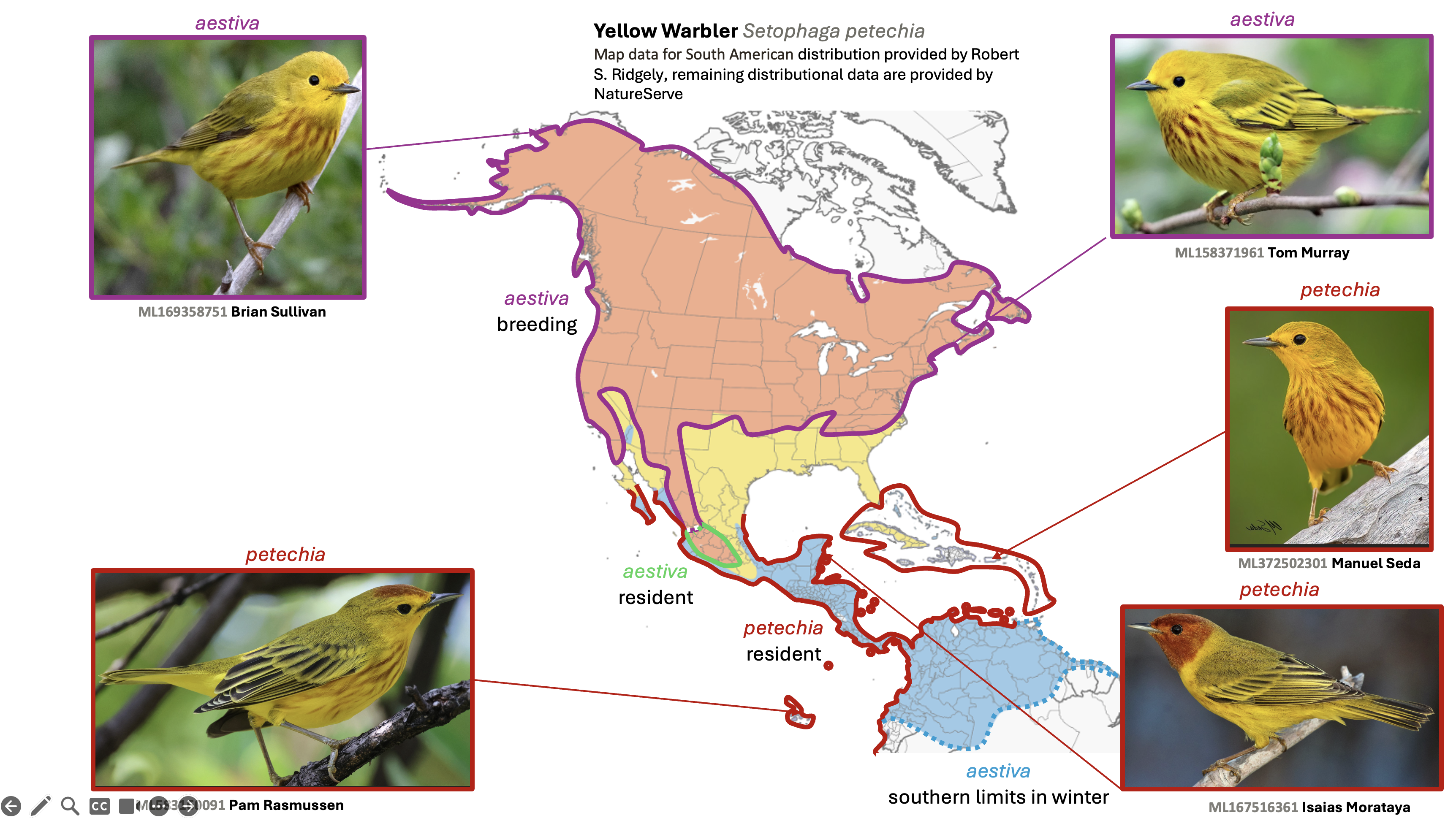
Regional Record Change Logic: Updating the records of Yellow Warblers was easy for the majority (95%) of the range of Northern Yellow Warbler, since it is the only species that occurs in most of the United States, all of Canada, all interior states in Middle America and South America, and the only species to occur south and east of coastal eastern Venezuela and north coastal Peru. However, there is a broad area of overlap. Below is the logic we are applying, but it is a slow process to update records almost one at a time and at this point we very much encourage birders to review your records of Northern/Mangrove Yellow Warbler and update them yourself if you know what species was involved. Below is the logic we are using:
- United States (most of country), Baja California (Norte), Canada, Bermuda, St. Pierre et Miquelon, Clipperton, etc. – Northern Yellow Warbler.
- United States (known Mangrove Yellow Warbler breeding areas) – no changes: In Monroe County, Florida and Cameron and Willacy Counties, Texas, where Mangrove Yellow Warbler breeds we are generally assuming that birders have designated the special taxon when observed, so we will convert to Northern Yellow Warbler. But at known breeding sites for Mangrove Yellow Warbler (where either species is possible) we plan to leave records as Northern/Mangrove Yellow Warbler except for the narrow summer period (mid-May to early August) when only Mangrove Yellow is likely. So please designate these records yourself if you have observed these species in the United States.
- coastal Mexico, Central America, and South America – no changes: Mangrove Yellow Warbler breeds coastally in Baja California Sur, and on the Pacific Coast from s. Sonora south to northern Peru and all along the Caribbean coast from south Texas to eastern Venezuela. We are attempting to treat all records within a kilometer of coastal mangroves as they were submitted (thus, if you submitted Yellow Warbler it will remain as Northern/Mangrove Yellow Warbler; if you designated a subspecies, it will have been moved to the correct new taxon). All inland records more than a kilometer from coastal mangroves will be moved to Northern Yellow Warbler. However, we encourage birders to help us with this process by reviewing your records of your records of Northern/Mangrove Yellow Warbler
- inland Mexico, Central America, and South America – Northern Yellow Warbler S. aestiva: We are attempting to treat all records more than a kilometer from known breeding areas in coastal mangroves to Northern Yellow Warbler. However, we encourage birders to help us with this process by reviewing your records of Northern/Mangrove Yellow Warbler, especially from coastal areas where either is possible. Keep as the slash if you are unsure, but if you have photos please check those and if you identified the bird as a local breeder, please do change it. Strongly territorial behavior can be a good hint, along with any other breeding behavior.
Rose-bellied Chat Granatellus paraensis is split from Rose-breasted Chat Granatellus pelzelni. Fairly subtle plumage and vocal differences were still enough to warrant treatment at the species level. Granatellus chats are wonderful birds, so a bright new day has dawned with one more species of Granatellus to seek out, although it may take some effort to encounter the range-restricted Rose-bellied Chat.
- Rose-breasted Chat Granatellus pelzelni [map] [media] [my records]
-
- RANGE: tropical southeastern Venezuela to Guyana, Suriname, central and Amazonian Brazil west of the lower Tocantins River, and northern Bolivia (eastern Pando eastward to far northern Santa Cruz)
-
- Rose-bellied Chat Granatellus paraensis [map] [media] [my records]
-
- RANGE: tropical northern Brazil east of the lower Tocantins River (eastern Pará and Maranhão)
-
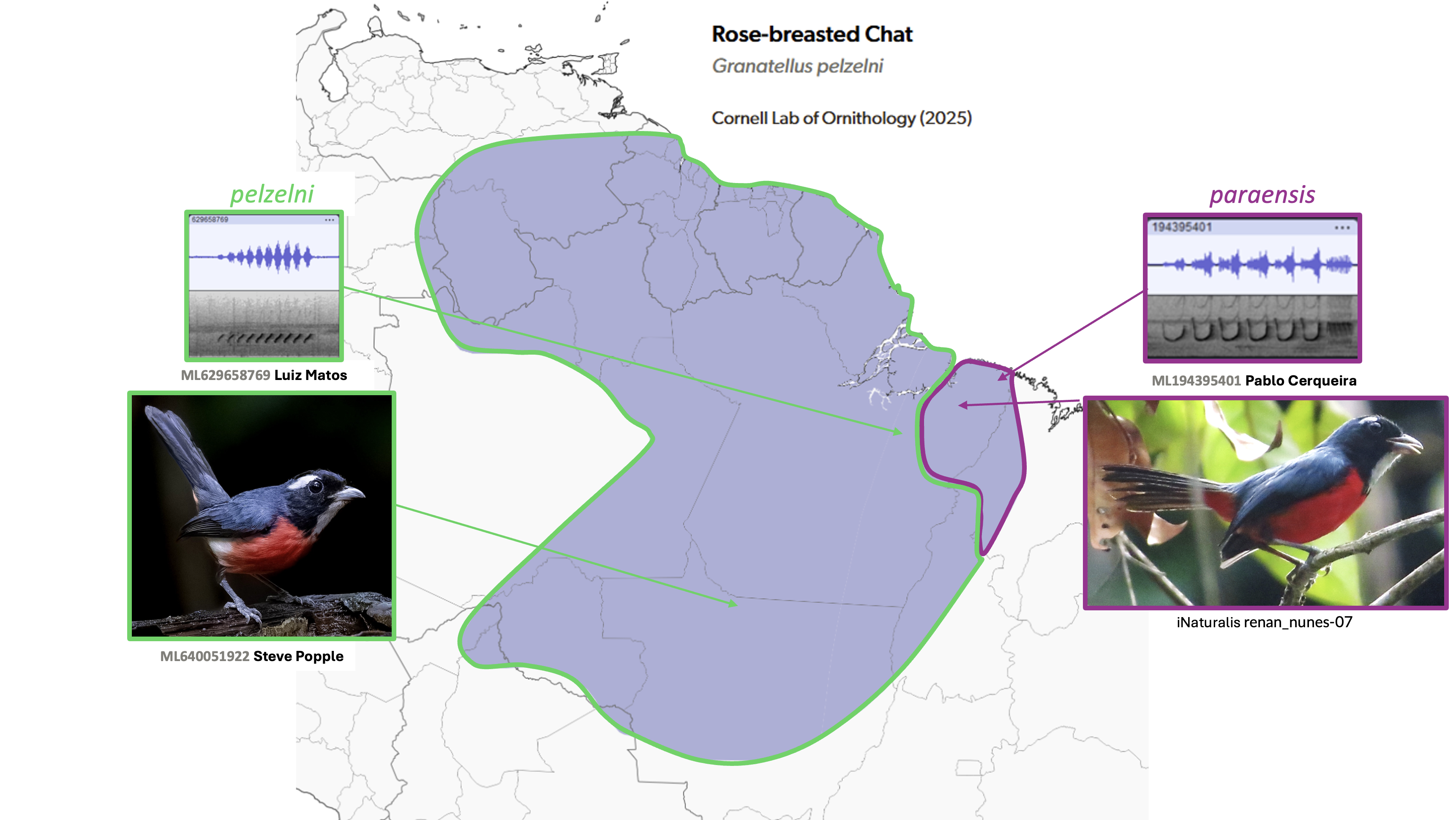
Carriker’s Mountain Tanager Dubusia carrikeri, Buff-banded Mountain Tanager Dubusia taeniata, and Streak-crowned Mountain Tanager Dubusia stictocephala are split from Buff-breasted Mountain Tanager Dubusia taeniata. Distinctive plumage features can be found in each of the new species: Carriker’s has a pale throat, Buff-banded has a streaky supercilium but blackish crown, and Streak-crowned is streaky all through the crown. Mountain Tanagers are fun birds to seek out in wonderful habitat, so enjoy your quest to find all three!
- Carriker’s Mountain Tanager Dubusia carrikeri [map] [media] [my records]
-
- RANGE: Santa Marta Mountains (northeastern Colombia)
-
- Buff-banded Mountain Tanager Dubusia taeniata [map] [media] [my records]
-
- RANGE: Andes of Venezuela, Colombia, Ecuador, and far northern Peru
-
- Streak-crowned Mountain Tanager Dubusia stictocephala [map] [media] [my records]
-
- RANGE: Andes of Peru (central Amazonas southward to Cusco)
-
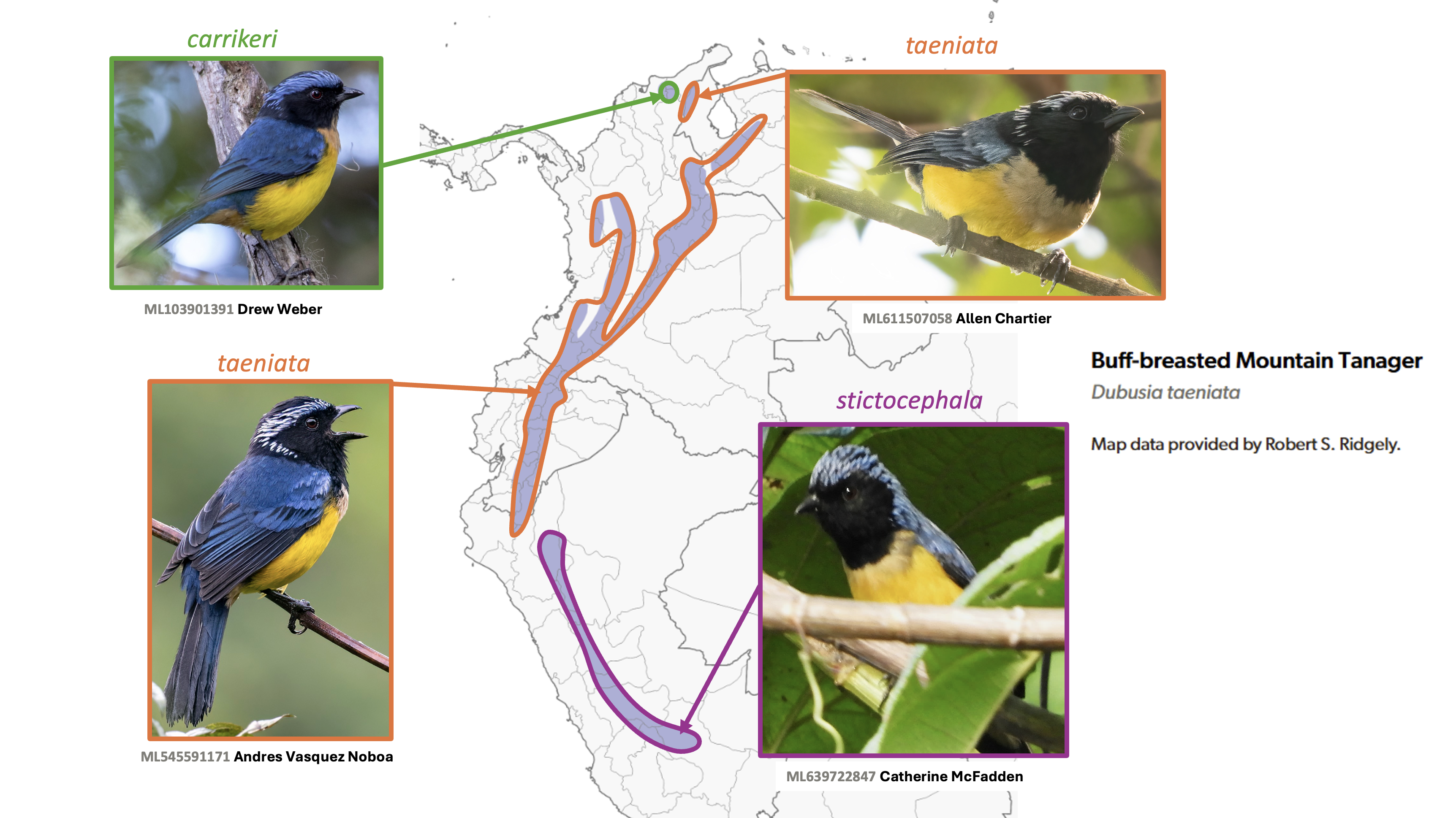
Black-hooded Tanager Stilpnia whitelyi is split from Black-headed Tanager Stilpnia cyanoptera. Well separated by range, the similar plumage in these species masked the fact that vocalizations differ and the two are better treated as separate species.
- Black-headed Tanager Stilpnia cyanoptera [map] [media] [my records]
-
- RANGE: mountains of northern Colombia to northern Venezuela
-
- Black-hooded Tanager Stilpnia whitelyi [map] [media] [my records]
-
- RANGE: tepuis of southern Venezuela to Guyana and far northern Brazil
-
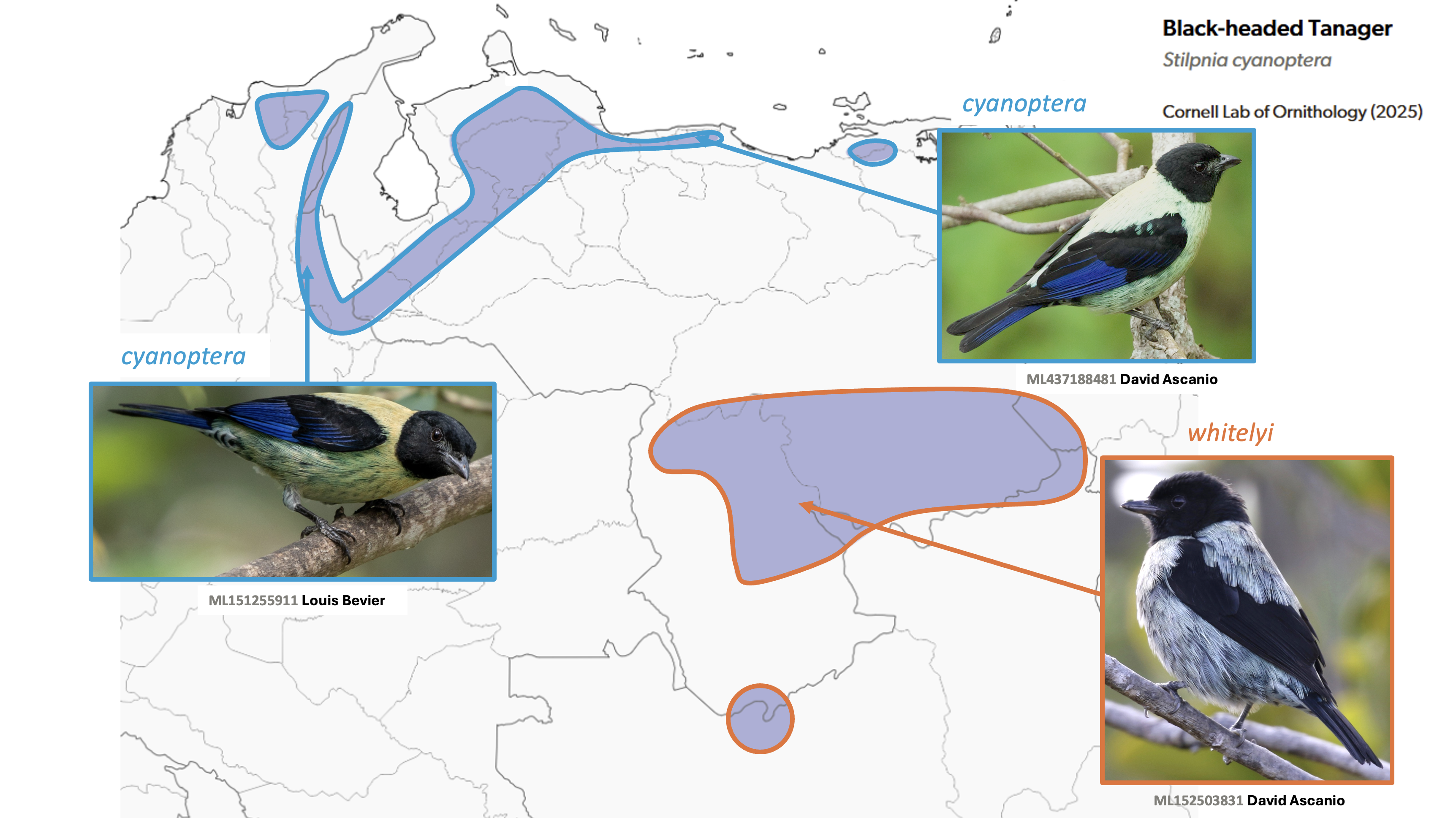
Yellow-tufted Dacnis Dacnis egregia is split from Black-faced Dacnis Dacnis lineata. These two are superficially similar in plumage, but Yellow-tufted also has a bright yellow belly that sets it apart. The two come almost in contact in Andean valleys that lead up from the lowlands in Colombia, but they don’t seem to interbreed and the two are now widely endorsed as separate species.
- Yellow-tufted Dacnis Dacnis egregia [map] [media] [my records]
- RANGE: tropical central Colombia (Magdalena and Cauca valleys) and tropical western Ecuador (Esmeraldas to Chimbo)
- Black-faced Dacnis Dacnis lineata [map] [media] [my records]
- RANGE: Colombia (east of the Andes) to northern Bolivia and Amazonian Brazil
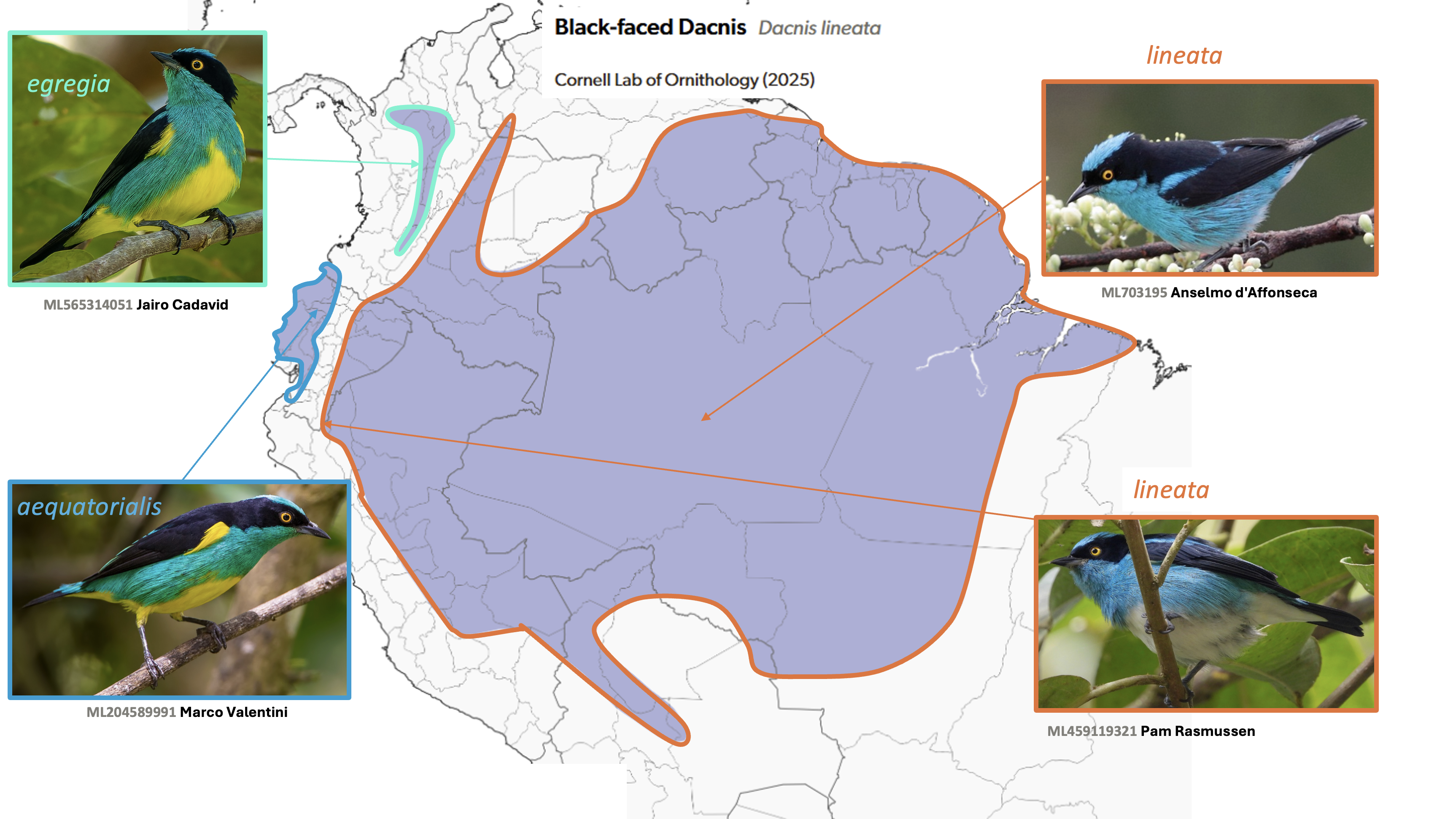
Regional Record Change Logic: Check your records in the foothills of the east slope of the Eastern Andes of Colombia with care, since some records were tricky to assign in those regions.
Black-billed Cnemoscopus Cnemoscopus chrysogaster and Pink-billed Cnemoscopus Cnemoscopus rubrirostris are split from Gray-hooded Bush Tanager Cnemoscopus rubrirostris. The plumage, bill color, and different vocalizations made this a solid split. While Bush Tanager was widely used for mid-sized tanager-like birds (Chlorospingus was a big genus of “bush-tanagers” previously), that term has been less and less useful as taxonomy has been revised. With this split, another opportunity to remove that unhelpful name arose and we are left with two Cnemoscopuses, tricky to spell but not as bad as it looks to pronounce (pronounced Knee-Mow-Scope-us).
- Pink-billed Cnemoscopus Cnemoscopus rubrirostris [map] [media] [my records]
- RANGE: Andes of Colombia to southwestern Venezuela (Táchira), eastern Ecuador, and northern Peru, north and west of the Marañón Valley
- Black-billed Cnemoscopus Cnemoscopus chrysogaster [map] [media] [my records]
- RANGE: Andes of Peru (Amazonas to Cordillera Vilcabamba in Cusco) and disjunctly in western Bolivia (near Tokoaque, in La Paz)
The two species probably don’t come into contact, but a slash is offered just in case for any areas of uncertainty.
- Pink-billed/Black-billed Cnemoscopus Cnemoscopus rubrirostris/chrysogaster [map] [media] [my records]
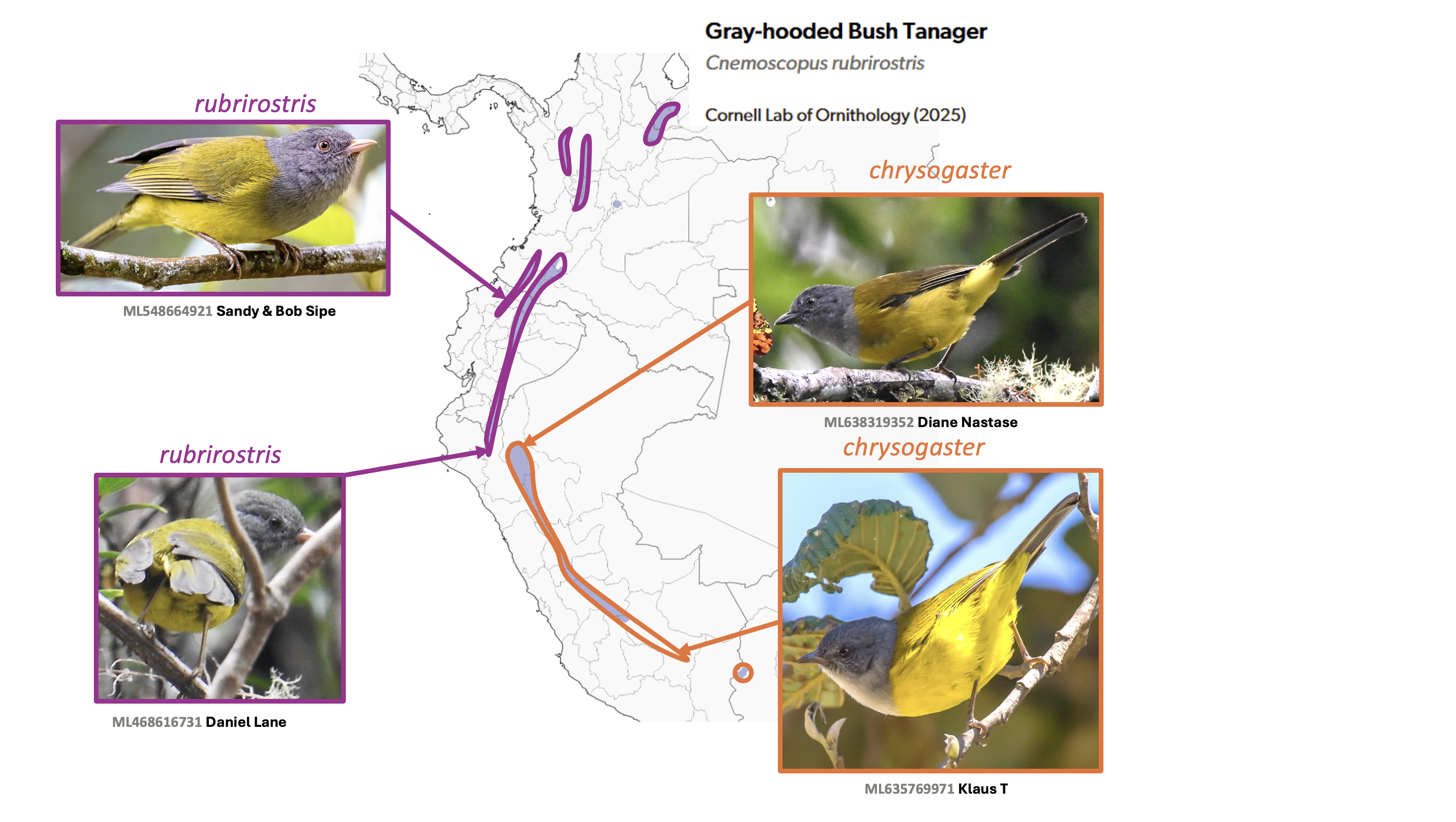
LUMPS and INVALID SPECIES
In eBird taxonomic revision, lumps are very easy to deal with. Usually the taxa become subspecies groups, so there is no changing of records necessary, just a recalculation of lists as the species drop to identifiable subspecies. Whenever possible, we encourage birders to continue reporting at the subspecies level, but whenever you select these options, be sure you understand the taxa that you are using; do not try to guess at the subspecies based on the name! This section also includes invalid species descriptions: these are rare but occur when an original description of a species or subspecies is proven to be a hybrid, rare variant, or other form of natural variation that does not represent a species. Full details can be seen at the Clements Updates & Corrections page.
This year’s update has three megalumps: updates that involve a loss of four or more species. The first of these is the Imperial Cormorant, which involves a lump of seven species into one. These taxa are each distinctive, and Kerguelen verrucosus especially so, and so they are retained as a subspecies group in eBird) and should be identifiable in the field. But they are believed to have diversified in a relatively recent radiation and AviList v2025 has treated them all as members of a single widespread species, so that treatment is also followed here.
- Imperial Cormorant Leucocarbo atriceps [map] [media] [my records]
- Imperial Cormorant (South Georgia) Leucocarbo atriceps georgianus [map] [media] [my records]
- RANGE: South Georgia, South Sandwich, and South Orkney islands
- Imperial Cormorant (Imperial) Leucocarbo atriceps [atriceps Group] [map] [media] [my records]
- RANGE: Islands and coasts of south-central Chile and Argentina southward to Cape Horn, Falkland Islands, South Sandwich, and South Orkney islands.
- Imperial Cormorant (Antarctic) Leucocarbo atriceps bransfieldensis [map] [media] [my records]
- RANGE: South Shetland Islands and Antarctic Peninsula
- Imperial Cormorant (Crozet) Leucocarbo atriceps melanogenis [map] [media] [my records]
- RANGE: Prince Edward, Marion, and Crozet islands
- Imperial Cormorant (Kerguelen) Leucocarbo atriceps verrucosus [map] [media] [my records]
- RANGE: Kerguelen Island (southern Indian Ocean)
- Imperial Cormorant (Heard Island) Leucocarbo atriceps nivalis [map] [media] [my records]
- RANGE: Heard Island (southern Indian Ocean)
- Imperial Cormorant (Macquarie) Leucocarbo atriceps purpurascens [map] [media] [my records]
- RANGE: Macquarie Island and adjacent Bishop and Clerk Rocks (southeast of Australia)
- Imperial Cormorant (South Georgia) Leucocarbo atriceps georgianus [map] [media] [my records]
Monotypic Maghreb Owl Strix mauritanica is lumped with polytypic Tawny Owl Strix aluco and is retained as a subspecies group. The North African endemic form is somewhat vocally distinct from the widespread Tawny Owl, but, at least at this time, it is not being considered vocally distinct enough for species status. There may be more changes to come within Tawny Owl, given that a subspecies in East Asia may not be correctly allocated between Tawny Owl and Himalayan Owl Strix nivicolum. Watch for more on this front in the years to come.
- Tawny Owl Strix aluco [map] [media] [my records]
- Tawny Owl (Tawny) Strix aluco [aluco Group] [map] [media] [my records]
- RANGE: Europe from Britain and Scotland through southern Fennoscandia to western Siberia, southward to the southernmost Iberian Peninsula, through the Levant, western Iran, and the western Himalayas eastward to Kashmir
- Tawny Owl (Maghreb) Strix aluco mauritanica [map] [media] [my records]
- RANGE: Morocco, Algeria, and Tunisia
- Tawny Owl (Tawny) Strix aluco [aluco Group] [map] [media] [my records]
The second of the megalumps is Black-eared Catbird. This species was split fairly recently (in 2016), when Spotted Catbird Ailuroedus melanotis was split into six species. Five of those splits are hereby reverted, with Black-eared Catbird Ailuroedus melanotis retaining species status but now involving four taxa that were also formerly treated as species. This reduces the endemic count for New Guinea by four.
- Black-eared Catbird Ailuroedus melanotis [map] [media] [my records]
- Black-eared Catbird (Black-eared) Ailuroedus melanotis [melanotis Group] [map] [media] [my records]
- RANGE: southern New Guinea, including Aru Islands (off southwestern New Guinea), and northeastern Australia
- Black-eared Catbird (Huon) Ailuroedus melanotis astigmaticus [map] [media] [my records]
- RANGE: northeastern New Guinea (mountains of Huon Peninsula)
- Black-eared Catbird (Black-capped) Ailuroedus melanotis melanocephalus [map] [media] [my records]
- RANGE: mountains of southeastern New Guinea
- Black-eared Catbird (Northern) Ailuroedus melanotis jobiensis [map] [media] [my records]
- RANGE: north-central New Guinea (north slope of Western, Border, and Eastern ranges and coastal ranges from Foja Mountains eastward to Adelbert Mountains)
- Black-eared Catbird (Arfak) Ailuroedus melanotis misoliensis/arfakianus [map] [media] [my records]
- RANGE: montane Bird’s Head Peninsula (northwestern New Guinea), including Misool (Raja Ampat Islands, off western New Guinea)
- Black-eared Catbird (Black-eared) Ailuroedus melanotis [melanotis Group] [map] [media] [my records]
Monotypic Manus Cuckooshrike Coracina ingens is lumped with polytypic White-bellied Cuckooshrike Coracina papuensis and is retained as a subspecies group. White-bellied Cuckooshrike is quite widespread while the Manus bird is restricted to two small islands. The two taxa differ substantially in size, and could still prove to represent different species, but the decision to lump for now aligns with the decision for AviList v2025.
- White-bellied Cuckooshrike Coracina papuensis [map] [media] [my records]
- White-bellied Cuckooshrike (White-bellied) Coracina papuensis [papuensis Group] [map] [media] [my records]
- RANGE: Moluccas, New Guinea region, Bismarck Archipelago, Solomon Islands, and eastern Australia
- White-bellied Cuckooshrike (Manus) Coracina papuensis ingens [map] [media] [my records]
- RANGE: Admiralty Islands (Manus and Los Negros)
- White-bellied Cuckooshrike (White-bellied) Coracina papuensis [papuensis Group] [map] [media] [my records]
Along with the cormorant and catbird above, the Little Shrikethrush lump completes the triumverate of pain for well-traveled world listers for this update. Together those three lumps account for a net loss of 16 species for the world list. In this case, the following species are recombined into a single Little Shrikethrush Colluricincla megarhyncha: Variable Shrikethrush Colluricincla fortis; Waigeo Shrikethrush Colluricincla affinis; Mamberamo Shrikethrush Colluricincla obscura; Sepik-Ramu Shrikethrush Colluricincla tappenbecki; Arafura Shrikethrush Colluricincla megarhyncha; Tagula Shrikethrush Colluricincla discolor; Rufous Shrikethrush Colluricincla rufogaster. Each will persist as an identifiable subspecific form, however, and it is always possible that the winds of the splitters will gust again over the range of this species…
- Little Shrikethrush Colluricincla megarhyncha [map] [media] [my records]
- Little Shrikethrush (Variable) Colluricincla megarhyncha [fortis Group] [map] [media] [my records]
- RANGE: eastern and southeastern New Guinea and southeastern satellite islands
- Little Shrikethrush (Waigeo) Colluricincla megarhyncha affinis [map] [media] [my records]
- RANGE: Waigeo (Raja Ampat Islands, off western New Guinea)
- Little Shrikethrush (Mamberamo) Colluricincla megarhyncha [obscura Group] [map] [media] [my records]
- RANGE: northwestern and west-central New Guinea, including Yapen (Cenderawasih Bay, off northwestern New Guinea)
- Little Shrikethrush (Sepik-Ramu) Colluricincla megarhyncha [tappenbecki Group] [map] [media] [my records]
- RANGE: north-central and northeastern New Guinea (Sepik-Ramu River drainages and Huon Peninsula)
- Little Shrikethrush (Arafura) Colluricincla megarhyncha [megarhyncha Group] [map] [media] [my records]
- RANGE: western and southern New Guinea, Aru Islands, and northwesterern Australia
- Little Shrikethrush (Tagula) Colluricincla megarhyncha discolor [map] [media] [my records]
- RANGE: Tagula (Louisiade Archipelago, off southeastern New Guinea)
- Little Shrikethrush (Rufous) Colluricincla megarhyncha [rufogaster Group] [map] [media] [my records]
- RANGE: southern New Guinea, northeastern to east-central Australia
- Little Shrikethrush (Variable) Colluricincla megarhyncha [fortis Group] [map] [media] [my records]
SUBSPECIES RESHUFFLES
Occasionally a subspecies, or portion of an existing species, will be moved from one species to another. These have the same effects as splits on birders’ lists, requiring data to be changed to match the taxonomic revision. These are quite confusing though, since name changes often don’t result–and when they do–they seem to come “out of nowhere”. Thankfully, subspecies shuffles are rare. We have just one such change for 2025 among Symposiachrus monarchs.
We correct an error from a v2024 split by moving subspecies wellsi from Australian Spectacled Monarch Symposiachrus trivirgatus to Moluccan Spectacled Monarch Symposiachrus bimaculatus, affecting a tiny adjustment to the range in the Seram Laut Islands and Watubela Islands. In Taxonerd Land (population two: Denis and Marshall), this results in a change to the taxonomic concept (e.g., the Avibase ID updates from C6D797EE to E61D0D04 for the Moluccan bird and from 3617AFFC to FDE2DC2E for the Australian one). In the real world, this means that eBird, AviList, IOC, and BirdLife taxonomies are 100% aligned when exchanging data about these birds, whether from Sydney or the Seram Laut archipelago.
- Moluccan Spectacled Monarch Symposiachrus bimaculatus [map] [media] [my records]
- Moluccan Spectacled Monarch (Halmahera) Symposiachrus bimaculatus bimaculatus [map] [media]
- RANGE: northern Moluccas (Morotai, Halmahera, and Bacan)
- Moluccan Spectacled Monarch (Obi) Symposiachrus bimaculatus diadematus [map] [media]
- RANGE: northern Moluccas (Obi and Bisa)
- Moluccan Spectacled Monarch (Seram) Symposiachrus bimaculatus nigrimentum/wellsi [map] [media]
- RANGE: southern Moluccas (Seram and Ambon) and Seram Laut Islands (Gorong and Manawoka) and Watubela Islands (Kasiui)
- Moluccan Spectacled Monarch (Halmahera) Symposiachrus bimaculatus bimaculatus [map] [media]
- Australian Spectacled Monarch Symposiachrus trivirgatus [map] [media] [my records]
- Australian Spectacled Monarch (Western) Symposiachrus trivirgatus trivirgatus/albiventris [map] [media]
- RANGE: Lesser Sundas and northeastern Australia
- Australian Spectacled Monarch (Eastern) Symposiachrus trivirgatus gouldii/melanorrhous [map] [media]
- RANGE: eastern Queensland (Cooktown to Burdekin River) southward to near Sydney, New South Wales; at least partially migratory, wintering to southern New Guinea (Trans-Fly) and Torres Strait Islands
- Australian Spectacled Monarch (Western) Symposiachrus trivirgatus trivirgatus/albiventris [map] [media]
One other issue from last year, that we were not able to fully resolve until this year, has been last year’s move of subspecies dialilaemus from Blue-throated Flycatcher Cyornis rubeculoides to Hainan Blue Flycatcher Cyornis hainanus. Up until 2024, we had the subspecies group Blue-throated Flycatcher (Notch-throated) Cyornis rubeculoides dialilaemus/rogersi but with last year’s revision, it did not make sense to maintain this since dialilaemus and rogersi were split across two species and since we also have a slash for Hainan Blue/Blue-throated/Chinese Blue Flycatcher Cyornis hainanus/rubeculoides/glaucicomans which better represents the major field problems. However, our South and Southeast Asia partners felt it was really important to not lose information from the old dialilaemus/rogersi and so for this year we have subspecies groups for all three taxa in Hainan Blue Flycatcher. This allows us to subdivide some of the old data (retained as the “Notch-throated” group) from dialilaemus/rogersi to the correct taxon. We have attempted that this year, and this may result in some species moving around on people’s lists.
- Hainan Blue Flycatcher Cyornis hainanus [map] [media] [my records]
- Hainan Blue Flycatcher (Western Orange-breasted) Cyornis hainanus dialilaemus [map] [media]
- RANGE: mostly lower hills and lowlands of northeastern India (western Arunachal and eastern Assam) and hills south of the Brahmaputra (where poorly documented) eastward to far southwestern Yunnan and northwestern and western Thailand (southward to about Phetchaburi); some winter farther south in Thailand
- Hainan Blue Flycatcher (Blue-breasted) Cyornis hainanus hainanus [map] [media]
- RANGE: mountains of southern China including Hainan to southern Myanmar, Thailand (except west and central, to north of the Isthmus of Kra), and Indochina
- Hainan Blue Flycatcher (Eastern Orange-breasted) Cyornis hainanus klossi [map] [media]
- RANGE: eastern Thailand, southern Laos, eastern Cambodia (at least in Mondulkiri), and southern Vietnam (central Annam southward to Cochinchina)
- Hainan Blue Flycatcher (Western Orange-breasted) Cyornis hainanus dialilaemus [map] [media]
- Blue-throated Flycatcher Cyornis rubeculoides [map] [media] [my records]
- Cyornis rubeculoides rubeculoides
- RANGE: Kashmir to northern India and northern Myanmar; winters to Sri Lanka
- Cyornis rubeculoides rogersi
- RANGE: Myanmar (Arakan Yoma and lower Chindwin River area); populations in the Indian hills south of the Brahmaputra have been treated as this
- Cyornis rubeculoides rubeculoides
Here’s what we wrote last year (as a refresher; it can also be seen in our 2024 update).
The enigmatic blue flycatcher taxon dialilaemus has been hard to categorize. For 2023 and years prior, we classified it as a subspecies of Blue-throated Flycatcher, Cyornis rubeculoides dialilaemus. With this update, however, it moves to Hainan Blue Flycatcher as Cyornis hainanus dialilaemus. This acknowledges the discovery that Hainan Blue Flycatcher seems to show impressive polymorphism, since some adult males are blue overall with a white belly while others have reddish breasts, like many other species. The orange-breasted birds were previously treated as subspecies klossi, which itself had uncertain affinities, until genetic information showed that it and the all blue hainanus Hainan Blue Flycatchers were fully intermixed such that klossi may be only a morph and not even a valid subspecies (we currently treat it ias valid, but that may change in the future). Genetic information now shows that dialilaemus is most closely related to Hainan Blue Flycatcher and is only distantly related to Blue-throated Flycatcher. While dialilaemus could be its own species, it cannot be considered part of Blue-throated Flycatcher. A very similar taxon, however, is rogersi, which has been clumped by eBird as the subspecies group (Blue-throated Flycatcher (Notch-throated) Cyornis rubeculoides dialilaemus/rogersi. But since eBirders did not distinguish subspecies within that group, since those two are very similar in plumage, and since they move to different subspecies, we have disbanded that group while the subspecies go their separate ways: rogersi with Blue-throated Flycatcher (still) and dialilaemus to its new home with Hainan Blue Flycatcher.

SHUFFLES OF OTHER TAXA and SUBSPECIES GROUP LUMPS
Revisions to eBird subspecies groups, and occasionally other taxa (like spuhs or slashes), can happen in our taxonomic update as well. This effectively changes the definition for these taxa and also changes how you should use them in reporting. To review your records of any of the subspecies groups below, simply open your Life List on eBird and use a browser search to search for the species name in question. Click the species to open all reports for that species; your subspecies reports will appear in this list and you can review those for accuracy. Selected revisions are listed below; for a complete listing of these changes see the Clements updates.
Two species involved in splits also have significant changes to subspecies groups. See the “splits” section above for these changes to Western Red-legged Thrush and Mangrove Yellow Warbler.
Other groups that existed in last year’s (2024) taxonomy, but have changed their composition within the species, are as follows:
Brown Tinamou Crypturellus obsoletus formerly had one monotypic subspecies group—Brown Tinamou (castaneus)—and another covering the rest of the subspecies. In fact, there is significant plumage of vocal differentiation that badly needs research to determine if these all represent different species. Below is the new set of subspecies groups for Brown Tinamou.
-
- Brown Tinamou (Venezuelan) Crypturellus obsoletus cerviniventris/knoxi [map] [media]
- RANGE: northern and northwestern Venezuela
- Brown Tinamou (Ecuadorian) Crypturellus obsoletus castaneus [map] [media]
- RANGE: tropical eastern Colombia to eastern Ecuador and northern Peru
- Brown Tinamou (Andean) Crypturellus obsoletus [punensis Group] [map] [media]
- RANGE: subtropical central Peru (Huánuco to Cusco) to the Yungas of northern Bolivia
- Brown Tinamou (Amazonian) Crypturellus obsoletus griseiventris [map] [media]
- RANGE: north-central and southwestern Brazil (Santarém region along Rio Tapajós and upper Rio Madeira in Rondônia)
- Brown Tinamou (Atlantic) Crypturellus obsoletus obsoletus [map] [media]
- RANGE: eastern Paraguay to southeastern Brazil and far northeastern Argentina (Misiones)
- Brown Tinamou (Venezuelan) Crypturellus obsoletus cerviniventris/knoxi [map] [media]
Amazilia Hummingbird Amazilis amazilia had previously been divided into three groups: polytypic Amazilia Hummingbird (White-throated) Amazilis amazilia [dumerilii Group], and two monotypic groups: Amazilia Hummingbird (Green-throated) Amazilis amazilia amazilia and Amazilia Hummingbird (Blue-throated) Amazilis amazilia caeruleigularis. However, each subspecies is quite different and this year we recognize each subspecies as a monotypic group, and rename the two monotypic groups that existed previously. Below is the new arrangement:
-
- Amazilia Hummingbird (Green-tailed) Amazilis amazilia dumerilii [map] [media]
- RANGE: Pacific lowlands of Ecuador to Tumbes, far northwestern Peru; east slope in Zamora Valley
- Amazilia Hummingbird (Azuay) Amazilis amazilia azuay [map] [media]
- RANGE: hills of southwestern Ecuador (Río Jubones drainage in Azuay and adjacent northern Loja)
- Amazilia Hummingbird (Montane) Amazilis amazilia alticola [map] [media]
- RANGE: Andes of southern Ecuador
- Amazilia Hummingbird (North Peruvian) Amazilis amazilia leucophoea [map] [media]
- RANGE: hills of northwestern to north-central Peru, from Tumbes to northern Lima
- Amazilia Hummingbird (Amazilia) Amazilis amazilia amazilia [map] [media]
- RANGE: arid littoral of west-central Peru
- Amazilia Hummingbird (Blue-throated) Amazilis amazilia caeruleigularis [map] [media]
- RANGE: foothills of southwestern Peru (Nazca Valley in Ica)
- Amazilia Hummingbird (Green-tailed) Amazilis amazilia dumerilii [map] [media]
Common Paradise-Kingfisher Tanysiptera galatea is being proposed for a six way split. The existing Rossel group is the only one that eBird has set up as of v2024, so for v2025 we have these subspecies groups which we expect to align with an upcoming split:
-
- Common Paradise-Kingfisher (Morotai) Tanysiptera galatea doris/emiliae [map] [media]
- RANGE: Moluccas (Morotai and Rau)
- Common Paradise-Kingfisher (Halmahera) Tanysiptera galatea [margarethae Group] [map] [media]
- RANGE: Moluccas (Halmahera, Doi, Kayoa, and Bacan)
- Common Paradise-Kingfisher (Obi) Tanysiptera galatea obiensis [map] [media]
- RANGE: central Moluccas (Obi and Bisa)
- Common Paradise-Kingfisher (Amboyna) Tanysiptera galatea [nais Group] [map] [media]
- RANGE: Moluccas (Buru, Boano, and Ambon, Manipa, Seram, Manawoka, and Gorong)
- Common Paradise-Kingfisher (Papuan) Tanysiptera galatea [galatea Group] [map] [media]
- RANGE: New Guinea
- Common Paradise-Kingfisher (Rossel) Tanysiptera galatea rosseliana [map] [media]
- RANGE: Rossel (Louisiade Archipelago, off southeastern New Guinea)
- Common Paradise-Kingfisher (Morotai) Tanysiptera galatea doris/emiliae [map] [media]
Brown-throated Parakeet Eupsittula pertinax had one monotypic group for birds in Costa Rica and Panama—Brown-throated Parakeet (Veraguas) Eupsittula pertinax ocularis—with the remaining subspecies in a single widespread group: Brown-throated Parakeet (Brown-throated) Eupsittula pertinax [pertinax Group]. However, there is a lot of variation that deserves additional groups, so that polytypic group is divided into:
-
- Brown-throated Parakeet (Veraguas) Eupsittula pertinax ocularis [map] [media]
- RANGE: Pacific lowlands of southwestern Costa Rica and Panama
- Brown-throated Parakeet (Colombian) Eupsittula pertinax [aeruginosa Group] [map] [media]
- RANGE: northern Colombia to northwestern Venezuela, northeastern Colombia (Sinú River Valley), and llanos of eastern Colombia (possibly adjacent western Venezuela)
- Brown-throated Parakeet (Gold-faced) Eupsittula pertinax pertinax/xanthogenia [map] [media]
- RANGE: Curaçao and Bonaire
- Brown-throated Parakeet (Venezuelan) Eupsittula pertinax [chrysophrys Group] [map] [media]
- RANGE: Aruba, islands off northern Venezuela, Venezuela, the Guianas, and adjacent Brazil (northern Roraima)
- Brown-throated Parakeet (Amazonian) Eupsittula pertinax chrysogenys/paraensis [map] [media]
- RANGE: north-central and south-central Amazonian Brazil (middle Rio Negro region and Rio Tapajós and Rio Cururu)
- Brown-throated Parakeet (Veraguas) Eupsittula pertinax ocularis [map] [media]
Ornate Stipplethroat Epinecrophylla ornata has a new group recognized from within the existing “Western” group:
-
- Ornate Stipplethroat (Western) Epinecrophylla ornata [ornata Group] [map] [media]
- RANGE: Andean foothills of central Colombia (western Meta), south-central Colombia (eastern Nariño, eastern Cauca, Putumayo), eastern Ecuador, and northeastern Peru (north of Río Marañón and west of Río Napo), east-central Peru (San Martín southeast to Ayacucho and Cuzco, east to Ucayali) and far southwestern Amazonian Brazil (far southwestern Amazonas and western Acre)
- Ornate Stipplethroat (Plain-backed) Epinecrophylla ornata meridionalis [map] [media]
- RANGE: southeastern Peru (Madre de Dios and Puno), adjacent Brazil, and northwestern Bolivia
- Ornate Stipplethroat (Eastern) Epinecrophylla ornata hoffmannsi [map] [media]
- RANGE: southeastern Amazonian Brazil east of Rio Madeira in eastern Rondônia, western and northern Mato Grosso, and Pará west of Rio Tocantins
- Ornate Stipplethroat (Western) Epinecrophylla ornata [ornata Group] [map] [media]
White-flanked Antwren (Gray-backed) Myrmotherula axillaris [axillaris Group] is split, with White-flanked Antwren (Black-backed) Myrmotherula axillaris melaena/albigula recognized as a new group. The Silver-flanked group remains unchanged.
- White-flanked Antwren (Black-backed) Myrmotherula axillaris melaena/albigula [map] [media]
- RANGE: Caribbean slope from southeastern Honduras southward to western Colombia, and Pacific slope from central Panama (Panamá Province) southward to Ecuador (Manabí, northwestern Azuay) and Santa Marta Mountains and Colombia east of Andes, western Venezuela (Andean slopes eastward to Mérida and Barinas, northwestern Bolívar, western Amazonas), northwestern Brazil (upper Rio Negro southward to northern bank of Amazon), eastern Ecuador, and northeastern Peru (to Loreto)
- White-flanked Antwren (Gray-backed) Myrmotherula axillaris [axillaris Group] [map] [media]
- RANGE: eastern Venezuela (eastern Apure, Monagas, Delta Amacuro, and south of Río Orinoco east of Río Caura), Trinidad, the Guianas, eastern Amazonian Brazil (from both banks of lower Rio Negro eastward to Amapá and, south of Amazon, east of Rio Madeira to Maranhão and southward to Tocantins, Mato Grosso, and southwestern amazonian Brazil and central Bolivia (west of Río Mamoré, and along base of Andes eastward to western Santa Cruz)
- White-flanked Antwren (Silvery-flanked) Myrmotherula axillaris luctuosa [map] [media]
- RANGE: coastal eastern Brazil (Paraíba to Rio de Janeiro)
Woodcreepers still probably have a lot of cryptic and unrecognized diversity, which is usually revealed through their distinctive vocalizations which are often determinative of species limits. In order to better categorize the variation within Black-banded Woodcreeper Dendrocolaptes picumnus, the three existing groups, Black-banded Woodcreeper (Spot-throated) Dendrocolaptes picumnus [puncticollis Group], Black-banded Woodcreeper (Black-banded) Dendrocolaptes picumnus [picumnus Group], and Black-banded Woodcreeper (Pale-billed) Dendrocolaptes picumnus pallescens/casaresi), are reorganized as follows:
-
- Black-banded Woodcreeper (Mexican) Dendrocolaptes picumnus puncticollis [map] [media]
- RANGE: highlands of southern Mexico (Chiapas) to Guatemala and northwestern Nicaragua
- Black-banded Woodcreeper (Costa Rican) Dendrocolaptes picumnus costaricensis [map] [media]
- RANGE: highlands of Costa Rica and Pacific slope of western Panama
- Black-banded Woodcreeper (Caribbean) Dendrocolaptes picumnus seilerni [map] [media]
- RANGE: tropical and subtropical zones in foothills and highlands of northern Colombia (Santa Marta region) and coastal range of northern Venezuela (Falcón eastward to Sucre and northern Monagas)
- Black-banded Woodcreeper (Andean) Dendrocolaptes picumnus multistrigatus [map] [media]
- RANGE: subtropical to lower temperate zones in Sierra de Perijá and Andes of Colombia (southward to Cauca), and northwestern and western Venezuela (Zulia and northern Barinas southward to Táchira)
- Black-banded Woodcreeper (Amazonian) Dendrocolaptes picumnus picumnus/validus [map] [media]
- RANGE: lowlands and foothills of W Amazonia, both north and south of Amazon, in southeastern Colombia, eastern Ecuador, eastern Peru, northern Bolivia, and western Brazil (eastward to Rio Negro and Rio Madeira, and southward to Mato Grosso) and tropical southern and eastern Venezuela eastward to the Guianas and Brazil north of the Amazon River (Rio Negro eastward to Amapá)
- Black-banded Woodcreeper (Tapajos) Dendrocolaptes picumnus transfasciatus [map] [media]
- RANGE: Amazonian Brazil south of the lower Amazon River, from Rio Tapajós eastward to Rio Xingu and southward to northern Mato Grosso
- Black-banded Woodcreeper (Bolivian) Dendrocolaptes picumnus olivaceus [map] [media]
- RANGE: foothills of Bolivian Andes (La Paz, Cochabamba, and Santa Cruz)
- Black-banded Woodcreeper (Southern) Dendrocolaptes picumnus pallescens/casaresi [map] [media]
- RANGE: Chaco of eastern Bolivia, southern Brazil, and western Paraguay and Andean foothills of northwestern Argentina (Jujuy, Salta, and Tucumán) and probably southernmost Bolivia
- Black-banded Woodcreeper (Mexican) Dendrocolaptes picumnus puncticollis [map] [media]
Brown-winged Schiffornis Schiffornis turdina previously had a monotypic group for Brown-winged Schiffornis (Amazonian) Schiffornis turdina amazonum and placed the remaining subspecies in Brown-winged Schiffornis (Brown-winged) Schiffornis turdina [turdina Group]. This latter group is further subdivided in accord with vocal and genetic information that may indicate that species status for each is warranted.
-
- Brown-winged Schiffornis (West Amazonian) Schiffornis turdina amazonum [map] [media]
- RANGE: southern Venezuela to eastern Peru and western Amazonian Brazil (east to Rio Negro and northwestern Mato Grosso)
- Brown-winged Schiffornis (East Amazonian) Schiffornis turdina wallacii [map] [media]
- RANGE: eastern Amazonian Brazil, south of the Amazon River (from Rio Tapajós and lower Rio Teles Pires eastward to Maranhão)
- Brown-winged Schiffornis (Peruvian) Schiffornis turdina steinbachi [map] [media]
- RANGE: upper tropical southeastern Peru (Junín) to northern Bolivia
- Brown-winged Schiffornis (Atlantic) Schiffornis turdina turdina/intermedia [map] [media]
- RANGE: campos of eastern Brazil (Paraíba southward to Alagoas) and southeastern Brazil (southern Bahia southward to eastern Espírito Santo)
- Brown-winged Schiffornis (West Amazonian) Schiffornis turdina amazonum [map] [media]
Riverside Tyrant Knipolegus orenocensis previously had a polytypic subspecies group for Riverside Tyrant (Riverside) Knipolegus orenocensis orenocensis/xinguensis, but each subspecies is now recognized as a monotypic group. Below are the three current groups for the species now:
-
- Riverside Tyrant (Orinoco) Knipolegus orenocensis orenocensis [map] [media]
- RANGE: eastern Colombia (northeastern Meta) and central Venezuela (lower Rio Apure and upper Rio Orinoco eastward to Ciudad Bolívar)
- Riverside Tyrant (Sclater’s) Knipolegus orenocensis sclateri [map] [media]
- RANGE: northeastern Ecuador (Rio Napo), northeastern and eastern Peru (Rio Napo, Rio Marañón, Rio Amazon; upper Rio Ucayali) to southern Colombia and north-central Brazil (along Rio Amazon and Rio Madeira eastward to lower Rio Tapajós)
- Riverside Tyrant (Xingu) Knipolegus orenocensis xinguensis [map] [media]
- RANGE: eastern Brazil (lower Rio Xingú, Rio Tapajós, and Rio Araguaia)
- Riverside Tyrant (Orinoco) Knipolegus orenocensis orenocensis [map] [media]
After lots of shuffles within the Pachycephala whistlers in the past few years, these two are fairly minor revisions.
First, Tenggara Whistler Pachycephala calliope previously had a monotypic subspecies group for Tenggara Whistler (Timor) Pachycephala calliope calliope, with the remaining subspecies within a broad Tenggara Whistler (Rusty-breasted) Pachycephala calliope [fulvotincta Group]. This year, we recognize two new monotypic groups from within that polytypic group: one for Sumba and one for the Flores Sea islands. Below are the four subspecies groups within the species:
- Tenggara Whistler (Rusty-breasted) Pachycephala calliope fulvotincta/javana [map] [media]
- RANGE: eastern Java, Bali, and western Lesser Sundas (Sumbawa to Alor)
- Tenggara Whistler (Flores Sea) Pachycephala calliope everetti [map] [media]
- RANGE: Tanahjampea, Kalaotoa, and Madu islands (Flores Sea)
- Tenggara Whistler (Sumba) Pachycephala calliope fulviventris [map] [media]
- RANGE: Sumba (Lesser Sundas)
- Tenggara Whistler (Timor) Pachycephala calliope calliope [map] [media]
- RANGE: eastern Lesser Sundas (Rote, Timor, Semau, and Wetar)
Second, Black-tailed Whistler Pachycephala melanura (known by AviList as Mangrove Golden Whistler) previously had a monotypic subspecies group for the Damar endemic subspecies and another to cover the remaining subspecies: Black-tailed Whistler (Black-tailed) Pachycephala melanura [melanura Group]. That polytypic group is split into three groups, with the recognition of distinctive groups for New Guinea, northern Australia, and western Australia. The new subspecies groups for the species are shown below:
-
- Black-tailed Whistler (Damar) Pachycephala melanura dammeriana [map] [media]
- RANGE: Damar (eastern Lesser Sundas)
- Black-tailed Whistler (Papuan) Pachycephala melanura spinicaudus/dahli [map] [media]
- RANGE: off southeastern New Guinea and Bismarck Archipelago, northwestern (Bintuni Bay, Bird’s Neck) and southern New Guinea and offshore islands, northeastern Australia (northwestern Torres Strait islands)
- Black-tailed Whistler (Pilbara) Pachycephala melanura melanura [map] [media]
- RANGE: mangroves of northwestern Western Australia (Pilbara and western Kimberley)
- Black-tailed Whistler (North Australian) Pachycephala melanura robusta [map] [media]
- RANGE: coastal northern Australia (northern Kimberley region to Yeppoon, east-central Queensland coast, including smaller southern, central, and eastern Torres Strait islands)
- Black-tailed Whistler (Damar) Pachycephala melanura dammeriana [map] [media]
The Gray Whistler Pachycephala simplex previously had brown and gray-headed subspecies groups, but the Gray Whistler (Gray-headed) Pachycephala simplex [griseiceps Group] it here split into three, with the recognition of distinctive monotypic subspecies groups on the Kai archipelago and on Tagula. The four subspecies groups for v2025 are shown below:
-
- Gray Whistler (Brown) Pachycephala simplex simplex/brunnescens [map] [media]
- RANGE: central northern Australia (northern Northern Territory, Tiwi islands, and Groote Eylandt) and southeastern New Guinea, including D’Entrecasteaux Archipelago (off southeastern New Guinea)
- Gray Whistler (Kai) Pachycephala simplex rufipennis [map] [media]
- RANGE: Kai Islands (Kai Kecil and Kai Besar)
- Gray Whistler (Gray-headed) Pachycephala simplex [griseiceps Group] [map] [media]
- RANGE: New Guinea and the Wet Tropics and eastern Cape York Peninsula (northeastern Queensland, Australia)
- Gray Whistler (Tagula) Pachycephala simplex sudestensis [map] [media]
- RANGE: Tagula (Louisiade Archipelago, off southeastern New Guinea)
- Gray Whistler (Brown) Pachycephala simplex simplex/brunnescens [map] [media]
Drab Whistler Pachycephala griseonota formerly had a single monotypic subspecies group (for Drab Whistler (Cinnamon-breasted) Pachycephala griseonota johni of Obi) and another group to cover the remaining five subspecies. However, as is often the case in Indonesia, significant diversity has been revealed through a deeper look at genetics and vocalizations, and these each warrant a monotypic subspecies group (if not a split as a monotypic species). Below is the full set of subspecies groups for v2025:
-
- Drab Whistler (Peleng) Pachycephala griseonota lineolata [map] [media]
- RANGE: Peleng, in Banggai Islands, and Taliabu, Seho, and Sanana, in Sula Islands (off eastern Sulawesi)
- Drab Whistler (Halmahera) Pachycephala griseonota cinerascens [map] [media]
- RANGE: northern Moluccas (Morotai, Halmahera, Ternate, Tidore, and Bacan)
- Drab Whistler (Buru) Pachycephala griseonota examinata [map] [media]
- RANGE: Buru (southern Moluccas)
- Drab Whistler (Seram) Pachycephala griseonota griseonota [map] [media]
- RANGE: Seram (southern Moluccas)
- Drab Whistler (Kai) Pachycephala griseonota kuehni [map] [media]
- RANGE: Kai Islands (Kai Kecil and Kai Besar)
- Drab Whistler (Cinnamon-breasted) Pachycephala griseonota johni [map] [media]
- RANGE: Obi (northern Moluccas)
- Drab Whistler (Peleng) Pachycephala griseonota lineolata [map] [media]
Australasian Figbird Sphecotheres vieilloti had these three groups for v2024: Australasian Figbird (flaviventris Group) Sphecotheres vieilloti [flaviventris Group], Australasian Figbird (salvadorii) Sphecotheres vieilloti salvadorii, and
Australasian Figbird (vieilloti) Sphecotheres vieilloti vieilloti. A new group for the Kai Islands is recognized from Australasian Figbird (flaviventris Group) Sphecotheres vieilloti [flaviventris Group] and all groups are renamed: Australasian Figbird (Yellow) for Sphecotheres vieilloti flaviventris/ashbyi, Australasian Figbird (Papuan) for Sphecotheres vieilloti salvadorii and Australasian Figbird (Green) for Sphecotheres vieilloti vieilloti
-
- Australasian Figbird (Kai) Sphecotheres vieilloti cucullatus [map] [media]
- RANGE: Kai Islands (Indonesia), Arafura Sea
- Australasian Figbird (Yellow) Sphecotheres vieilloti flaviventris/ashbyi [map] [media]
- RANGE: northwestern Australia (Kimberley region, northern Western Australia, to northern Northern Territory) and northeastern Australia (southwestern Torres Strait islands, Cape York Peninsula south to Wet Tropics region, northern Queensland)
- Australasian Figbird (Papuan) Sphecotheres vieilloti salvadorii [map] [media]
- RANGE: coastal southeastern New Guinea
- Australasian Figbird (Green) Sphecotheres vieilloti vieilloti [map] [media]
- RANGE: eastern Australia (Wet Tropics region, northern Queensland southward to Bairnsdale, eastern Victoria)
- Australasian Figbird (Kai) Sphecotheres vieilloti cucullatus [map] [media]
The subspecies group Southern Fiscal (Southern) Lanius collaris [collaris Group] is split to recognize the distinctive plumage, woth a bold supercilium instead of an all-black head, of the Lakatoo group of the western portion of southern Africa. The exact range limits for these two subspecies groups needs some work, so please report your sightings with care and with photos when possible. The monotypic Tanzanian subspecies group for Lanius collaris marwitzi remains unchanged. All three subspecies groups in Southern Fiscal are shown below.
-
- Southern Fiscal (Uhehe) Lanius collaris marwitzi [map] [media]
- RANGE: highlands from northeastern to south-central Tanzania (Mpwapwa and Ukagurus southward to Njombe, Mt. Rungwe, and Tukuyu)
- Southern Fiscal (Southern) Lanius collaris collaris/pyrrhostictus [map] [media]
- RANGE: far southern Namibia, South Africa (except north and northeast), Lesotho, Eswatini, and far southern Mozambique (Maputo), far northeastern Botswana (Basuto region), southern Zimbabwe (south of Harare), northeastern and eastern South Africa (Limpopo and Mpumalanga), and southwestern Mozambique (mainly Gaza province)
- Southern Fiscal (Latakoo) Lanius collaris subcoronatus/aridicolus [map] [media]
- RANGE: far southeastern Angola, Namibia (except coastal northwestern and far southern), Botswana, southwestern Zimbabwe, and northern South Africa (south to northwestern Northern Cape and central Free State) and dune-fog zone of Namib Desert in southwestern Angola and northwestern Namibia
- Southern Fiscal (Uhehe) Lanius collaris marwitzi [map] [media]
The addition of four new groups in Red-crowned Ant-Tanager Habia rubica means that the component subspecies for the two existing groups of Red-crowned Ant-Tanager also change. Below is the new arrangement with the eight subspecies groups:
-
- Red-crowned Ant-Tanager (West Mexican) Habia rubicarosea [map] [media]
-
- RANGE: Pacific slope of southwestern Mexico (Nayarit and Jalisco to Guerrero)
-
- Red-crowned Ant-Tanager (Oaxaca) Habia rubica affinis [map] [media]
-
- RANGE: Pacific slope of southern Mexico (Oaxaca)
-
- Red-crowned Ant-Tanager (East Mexican) Habia rubica holobrunnea [map] [media]
-
- RANGE: subtropical eastern Mexico (southern Tamaulipas to Veracruz and northern Oaxaca)
-
- Red-crowned Ant-Tanager (rubicoides Group) Habia rubica [rubicoides Group] [map] [media]
- Habia rubica nelsoni: southeastern Mexico (Yucatan Peninsula north of southern Campeche)
- Habia rubica rubicoides: southern Mexico (Puebla and eastern Veracruz) southward to El Salvador and northern Nicaragua
- Habia rubica alfaroana: northwestern Costa Rica (Nicoya Peninsula)
- Red-crowned Ant-Tanager (Isthmian) Habia rubica vinacea [map] [media]
-
- RANGE: Pacific slope of northwestern Costa Rica south of Nicoya Peninsula to eastern Panama
-
- Red-crowned Ant-Tanager (Amazonian) Habia rubica [rubra Group] [map] [media]
-
- RANGE: Trinidad, n. Venezuela, se. Colombia east of the Andes to ne. Peru and far nw. Brazil
to e. Peru to central Bolivia and adjacent w. Brazil
- RANGE: Trinidad, n. Venezuela, se. Colombia east of the Andes to ne. Peru and far nw. Brazil
- Habia rubica rubra: Trinidad
- Habia rubica crissalis: coastal mountains of northeastern Venezuela (Anzoátegui to Sucre)
- Habia rubica mesopotamia: Venezuela (Río Yuruán region of eastern Bolívar)
- Habia rubica coccinea: eastern base of eastern Andes of north-central Colombia and western Venezuela
- Habia rubica rhodinolaema: southeastern Colombia east of the Andes to northeastern Peru and far northwestern Brazil
- Habia rubica peruviana: tropical eastern Peru to central Bolivia and adjacent western Brazil
- Habia rubica hesterna: central Brazil south of the Amazon River (eastward to Rio Xingu), southward to northern Mato Grosso
-
- Red-crowned Ant-Tanager (Perija) Habia rubica perijana [map] [media]
- RANGE: Sierra de Perijá (Colombia/Venezuela border)
- Red-crowned Ant-Tanager (Atlantic) Habia rubica rubica/bahiae [map] [media]
- RANGE: tropical e. Brazil and se. Brazil (southern Minas Gerais) to e. Paraguay and ne. Argentina
- Red-crowned Ant-Tanager (West Mexican) Habia rubicarosea [map] [media]
Within Capped Conebill, Conirostrum albifrons cyanonotum is distinctive and isolated in range and is split out from the White-capped group, which changes its name from Conirostrum albifrons [albifrons Group] to Conirostrum albifrons albifrons/centralandium.
-
- Capped Conebill (White-capped) Conirostrum albifrons albifrons/centralandium [map] [media]
- RANGE: far southwestern Venezuela (Andes of southern Táchira) to central Andes of Colombia (south to eastern slope in Nariño)
- Capped Conebill (Venezuelan) Conirostrum albifrons cyanonotum [map] [media]
- RANGE: coastal mountains of northern Venezuela (eastern Aragua eastward to eastern Distrito Capital)
- Capped Conebill (White-capped) Conirostrum albifrons albifrons/centralandium [map] [media]
The Bananaquit has a large number of subspecies groups. One minor change this year is that two former groups Bananaquit (St. Vincent) Coereba flaveola aterrima and Bananaquit (Grenada) Coereba flaveola atrata are now lumped into one: Bananaquit (St. Vincent and Grenada) Coereba flaveola aterrima/atrata. They are very similar in plumage and both have a black form.
One English name change to Bananaquit subspecies groups is noteworthy: Bananaquit (Cozumel I.) is changed to Bananaquit (Quintana Roo), since this subspecies is common both on Cozumel and the adjacent mainland coast of Quintana Roo.
NEW SUBSPECIES GROUPS
Below are the new subspecies groups that are now available for data entry. When you are certain you have seen representatives of these groups, and ideally have identified them critically based on their field marks, please report them to eBird. Please do not guess based on the name, such as “Northern” and “Southern” or “African” and “Asian”; make sure you understand the differences being represented before reporting at so specific a level. A relatively large number of new subspecies groups were added this year, reflecting a thorough review of plumage variation across a number of taxa by Lab taxonomist Pam Rasmussen.
- Elegant Crested-Tinamou (Northern) Eudromia elegans [intermedia Group]
- Elegant Crested-Tinamou (Southern) Eudromia elegans [elegans Group]
- Andean Tinamou (Northern) Nothoprocta pentlandii [oustaleti Group]
- Andean Tinamou (Southern) Nothoprocta pentlandii [pentlandii Group]
- Black Tinamou (Colombian) Tinamus osgoodi hershkovitzi
- Black Tinamou (Peruvian) Tinamus osgoodi osgoodi
- Brown Tinamou (Venezuelan) Crypturellus obsoletus cerviniventris/knoxi
- Brown Tinamou (Amazonian) Crypturellus obsoletus griseiventris
- Brown Tinamou (Atlantic) Crypturellus obsoletus obsoletus
- Taiga Bean-Goose (Western) Anser fabalis fabalis/johanseni
- Taiga Bean-Goose (Eastern) Anser fabalis middendorffii
- Torrent Duck (Colombian) Merganetta armata leucogenis/colombiana
- Torrent Duck (Black-bellied) Merganetta armata turneri
- Torrent Duck (Bolivian) Merganetta armata garleppi/berlepschi
- Torrent Duck (Patagonian) Merganetta armata armata
- Sickle-winged Guan (Santa Marta) Chamaepetes goudotii sanctaemarthae
- Sickle-winged Guan (West Andean) Chamaepetes goudotii goudotii/fagani
- Sickle-winged Guan (East Andean) Chamaepetes goudotii tschudii
- Sickle-winged Guan (South Andean) Chamaepetes goudotii rufiventris
- Band-tailed Guan (Santa Marta) Penelope argyrotis colombiana
- Band-tailed Guan (Band-tailed) Penelope argyrotis argyrotis/albicauda
- Andean Guan (Northern) Penelope montagnii [montagnii Group]
- Andean Guan (Southern) Penelope montagnii sclateri/plumosa
- Spot-bellied Bobwhite (White-breasted) Colinus leucopogon hypoleucus/incanus
- Spot-bellied Bobwhite (White-faced) Colinus leucopogon leucopogon
- Spot-bellied Bobwhite (Dark-chinned) Colinus leucopogon [sclateri Group]
- Crested Bobwhite (Colombian) Colinus cristatus [cristatus Group]
- Crested Bobwhite (Venezuelan) Colinus cristatus [parvicristatus Group]
- Claret-breasted Fruit-Dove (Moluccan) Ptilinopus viridis viridis
- Claret-breasted Fruit-Dove (Northern) Ptilinopus viridis pectoralis/salvadorii
- Claret-breasted Fruit-Dove (Geelvink) Ptilinopus viridis geelvinkianus
- Claret-breasted Fruit-Dove (D’Entrecasteaux) Ptilinopus viridis vicinus
- Claret-breasted Fruit-Dove (Solomons) Ptilinopus viridis lewisii
- Rufous-vented Ground-Cuckoo (Western) Neomorphus geoffroyi [salvini Group]
- Rufous-vented Ground-Cuckoo (Amazonian) Neomorphus geoffroyi geoffroyi/amazonicus
- Rufous-vented Ground-Cuckoo (Atlantic) Neomorphus geoffroyi dulcis
- Amazilia Hummingbird (Green-tailed) Amazilis amazilia dumerilii
- Amazilia Hummingbird (Azuay) Amazilis amazilia azuay
- Amazilia Hummingbird (Montane) Amazilis amazilia alticola
- Amazilia Hummingbird (North Peruvian) Amazilis amazilia leucophoea
- Sooty Oystercatcher (Yellow-spectacled) Haematopus fuliginosus opthalmicus
- Sooty Oystercatcher (Orange-spectacled) Haematopus fuliginosus fuliginosus
- Hadada Ibis (Western) Bostrychia hagedash brevirostris
- Hadada Ibis (Eastern) Bostrychia hagedash erlangeri/nilotica
- Hadada Ibis (Southern) Bostrychia hagedash hagedash
- Little Heron (African) Butorides atricapilla [atricapilla Group]
- Little Heron (Seychelles) Butorides atricapilla crawfordi/degens
- Little Heron (Red Sea) Butorides atricapilla brevipes
- Little Heron (Asian) Butorides atricapilla [javanica Group]
- Little Heron (Australasian) Butorides atricapilla [stagnatilis Group]
- Little Heron (Tahiti) Butorides atricapilla patruelis
- Great Horned Owl (Northern) Bubo virginianus [virginianus Group]
- Great Horned Owl (North Andean) Bubo virginianus nigrescens
- Great Horned Owl (Tropical) Bubo virginianus nacurutu/deserti
- Tawny Owl (Tawny) Strix aluco [aluco Group]
- Blue-black Kingfisher (Western) Todiramphus nigrocyaneus nigrocyaneus
- Blue-black Kingfisher (Northern) Todiramphus nigrocyaneus quadricolor
- Blue-black Kingfisher (Southern) Todiramphus nigrocyaneus stictolaemus
- Common Paradise-Kingfisher (Morotai) Tanysiptera galatea doris/emiliae
- Common Paradise-Kingfisher (Halmahera) Tanysiptera galatea [margarethae Group]
- Common Paradise-Kingfisher (Obi) Tanysiptera galatea obiensis
- Common Paradise-Kingfisher (Amboyna) Tanysiptera galatea [nais Group]
- Brown Jacamar (Black-billed) Brachygalba lugubris [lugubris Group]
- Brown Jacamar (Pale-billed) Brachygalba lugubris melanosterna
- Yellow-throated Woodpecker (Red-moustached) Piculus flavigula flavigula
- Yellow-throated Woodpecker (Yellow-faced) Piculus flavigula magnus
- Yellow-throated Woodpecker (Red-throated) Piculus flavigula erythropis
- Black-capped Lory (Vogelkop) Lorius lory lory
- Black-capped Lory (Biak) Lorius lory cyanauchen
- Black-capped Lory (Northern) Lorius lory [jobiensis Group]
- Black-capped Lory (Southern) Lorius lory erythrothorax
- Black-capped Lory (Fly River) Lorius lory somu
- Red-lored Amazon (Red-lored) Amazona autumnalis autumnalis
- Red-lored Amazon (Salvin’s) Amazona autumnalis salvini
- Brown-throated Parakeet (Colombian) Eupsittula pertinax [aeruginosa Group]
- Brown-throated Parakeet (Gold-faced) Eupsittula pertinax pertinax/xanthogenia
- Brown-throated Parakeet (Venezuelan) Eupsittula pertinax [chrysophrys Group]
- Brown-throated Parakeet (Amazonian) Eupsittula pertinax chrysogenys/paraensis
- Black-faced Pitta (Bougainville) Pitta anerythra pallida
- Black-faced Pitta (Central Solomons) Pitta anerythra anerythra/nigrifrons
- Ornate Stipplethroat (Plain-backed) Epinecrophylla ornata meridionalis
- White-flanked Antwren (Black-backed) Myrmotherula axillaris melaena/albigula
- Slaty Antwren (Western) Myrmotherula schisticolor schisticolor
- Slaty Antwren (Eastern) Myrmotherula schisticolor sanctaemartae/interior
- Long-winged Antwren (Northern) Myrmotherula longipennis longipennis
- Long-winged Antwren (Western) Myrmotherula longipennis garbei/zimmeri
- Long-winged Antwren (Southern) Myrmotherula longipennis [paraensis Group]
- Plain-winged Antwren (Tepui) Myrmotherula behni [inornata Group]
- Plain-winged Antwren (Ecuadorian) Myrmotherula behni behni
- Gray Antwren (North Amazonian) Myrmotherula menetriesii cinereiventris/pallida
- Gray Antwren (West Amazonian) Myrmotherula menetriesii menetriesii/berlepschi
- Gray Antwren (Northeastern) Myrmotherula menetriesii omissa
- Striated Antbird (Western) Drymophila devillei devillei
- Striated Antbird (Eastern) Drymophila devillei subochracea
- Blackish Antbird (Guianan) Cercomacroides nigrescens nigrescens
- Blackish Antbird (Andean) Cercomacroides nigrescens notata/aequatorialis
- Blackish Antbird (Amazonian) Cercomacroides nigrescens approximans/ochrogyna
- Gray Antbird (Northern) Cercomacra cinerascens cinerascens/immaculata
- Gray Antbird (Southern) Cercomacra cinerascens sclateri/iterata
- Silvered Antbird (Eastern) Sclateria naevia [naevia Group]
- Silvered Antbird (Western) Sclateria naevia argentata
- Hairy-crested Antbird (Gray-crested) Rhegmatorhina melanosticta melanosticta
- Hairy-crested Antbird (Rufous-crested) Rhegmatorhina melanosticta purusiana/brunneiceps
- Giant Antpitta (Western) Grallaria gigantea hylodroma
- Giant Antpitta (Eastern) Grallaria gigantea gigantea/lehmanni
- Variegated Antpitta (Amazonian) Grallaria varia [varia Group]
- Variegated Antpitta (Atlantic) Grallaria varia imperator/intercedens
- Rufous-capped Antthrush (Rufous-capped) Formicarius colma [colma Group]
- Rufous-capped Antthrush (Rufous-fronted) Formicarius colma ruficeps
- Rufous-breasted Antthrush (Rufous-breasted) Formicarius rufipectus [rufipectus Group]
- Rufous-breasted Antthrush (Southern) Formicarius rufipectus thoracicus
- Short-tailed Antthrush (Tepui) Chamaeza campanisona [fulvescens Group]
- Short-tailed Antthrush (North Andean) Chamaeza campanisona [columbiana Group]
- Short-tailed Antthrush (South Andean) Chamaeza campanisona [olivacea Group]
- Short-tailed Antthrush (Atlantic) Chamaeza campanisona campanisona/tshororo
- Striated Antthrush (Striated) Chamaeza nobilis nobilis/rubida
- Striated Antthrush (Ochre-breasted) Chamaeza nobilis fulvipectus
- Barred Antthrush (Barred) Chamaeza mollissima mollissima
- Barred Antthrush (Yungas) Chamaeza mollissima yungae
- White-chinned Woodcreeper (Northern) Dendrocincla merula merula/obidensis
- White-chinned Woodcreeper (Southern) Dendrocincla merula [castanoptera Group]
- Black-banded Woodcreeper (Mexican) Dendrocolaptes picumnus puncticollis
- Black-banded Woodcreeper (Costa Rican) Dendrocolaptes picumnus costaricensis
- Black-banded Woodcreeper (Caribbean) Dendrocolaptes picumnus seilerni
- Black-banded Woodcreeper (Andean) Dendrocolaptes picumnus multistrigatus
- Black-banded Woodcreeper (Tapajos) Dendrocolaptes picumnus transfasciatus
- Black-banded Woodcreeper (Bolivian) Dendrocolaptes picumnus olivaceus
- Red-billed Scythebill (Northern) Campylorhamphus trochilirostris venezuelensis/brevipennis
- Red-billed Scythebill (Trans-Andean) Campylorhamphus trochilirostris thoracicus/zarumillanus
- Red-billed Scythebill (Amazonian) Campylorhamphus trochilirostris [trochilirostris Group]
- Brown-winged Schiffornis (East Amazonian) Schiffornis turdina wallacii
- Brown-winged Schiffornis (Peruvian) Schiffornis turdina steinbachi
- White-bellied Tody-Tyrant (White-bellied) Hemitriccus griseipectus griseipectus
- White-bellied Tody-Tyrant (Pernambuco) Hemitriccus griseipectus naumburgae
- Northern Beardless-Tyrannulet (Northern) Camptostoma imberbe imberbe
- Northern Beardless-Tyrannulet (Yucatan) Camptostoma imberbe thyellophilum
- Southern Beardless-Tyrannulet (Colombian) Camptostoma obsoletum caucae
- Southern Beardless-Tyrannulet (Caribbean) Camptostoma obsoletum pusillum
- Southern Beardless-Tyrannulet (Amazonian) Camptostoma obsoletum napaeum/olivaceum
- Southern Beardless-Tyrannulet (Peruvian) Camptostoma obsoletum [sclateri Group]
- Riverside Tyrant (Xingu) Knipolegus orenocensis xinguensis
- Nutting’s Flycatcher (Mexican) Myiarchus nuttingi inquietus
- Nutting’s Flycatcher (Central American) Myiarchus nuttingi nuttingi
- Yellow-breasted Bowerbird (Eastern) Chlamydera lauterbachi lauterbachi
- Yellow-breasted Bowerbird (Central) Chlamydera lauterbachi uniformis
- Brown Treecreeper (Cape York) Climacteris picumnus melanotus
- Brown Treecreeper (Southern) Climacteris picumnus picumnus/victoriae
- Black-tailed Treecreeper (Black-tailed) Climacteris melanurus melanurus
- Black-tailed Treecreeper (Pilbara) Climacteris melanurus wellsi
- White-shouldered Fairywren (Southern) Malurus alboscapulatus lorentzi
- White-shouldered Fairywren (Pied) Malurus alboscapulatus alboscapulatus/naimii
- White-shouldered Fairywren (Black) Malurus alboscapulatus [moretoni Group]
- Plain Honeyeater (Plain) Pycnopygius ixoides [ixoides Group]
- Plain Honeyeater (Rusty) Pycnopygius ixoides finschi
- Marbled Honeyeater (Western) Pycnopygius cinereus cinereus/dorsalis
- Marbled Honeyeater (Eastern) Pycnopygius cinereus marmoratus
- Yellow-gaped Honeyeater (Northern) Meliphaga flavirictus crockettorum
- Yellow-gaped Honeyeater (Southeastern) Meliphaga flavirictus flavirictus
- Yellow-throated Miner (Pale-rumped) Manorina flavigula [flavigula Group]
- Yellow-throated Miner (Dark-rumped) Manorina flavigula obscura
- Ornate Melidectes (Ornate) Melidectes torquatus [torquatus Group]
- Ornate Melidectes (Large-wattled) Melidectes torquatus emilii
- Belford’s Melidectes (Eastern) Melidectes belfordi belfordi/brassi
- Belford’s Melidectes (Western) Melidectes belfordi joiceyi/kinneari
- Belford’s Melidectes (Schrader Mts.) Melidectes belfordi schraderensis
- Varied Honeyeater (Northern) Gavicalis versicolor sonoroides
- Varied Honeyeater (Southern) Gavicalis versicolor versicolor
- Smoky Honeyeater (Kumawa) Melipotes fumigatus kumawa
- Smoky Honeyeater (Smoky) Melipotes fumigatus fumigatus/goliathi
- Papuan Black Myzomela (Waigeo) Myzomela nigrita steini
- Papuan Black Myzomela (Black) Myzomela nigrita [nigrita Group]
- Papuan Black Myzomela (D’Entrecasteaux) Myzomela nigrita forbesi
- Red-headed Myzomela (Papuan) Myzomela erythrocephala infuscata
- Red-headed Myzomela (Australian) Myzomela erythrocephala erythrocephala
- Rufous-sided Honeyeater (Red-eyed) Ptiloprora erythropleura erythropleura
- Rufous-sided Honeyeater (White-eyed) Ptiloprora erythropleura dammermani
- White-cheeked Honeyeater (White-cheeked) Phylidonyris niger niger
- White-cheeked Honeyeater (Gould’s) Phylidonyris niger gouldii
- Tawny-breasted Honeyeater (Western) Xanthotis flaviventer [flaviventer Group]
- Tawny-breasted Honeyeater (Northern) Xanthotis flaviventer meyerii/philemon
- Tawny-breasted Honeyeater (Southern) Xanthotis flaviventer [filiger Group]
- Tawny-breasted Honeyeater (D’Entrecasteaux) Xanthotis flaviventer spilogaster
- Weebill (Yellow) Smicrornis brevirostris flavescens
- Weebill (Brown) Smicrornis brevirostris [brevirostris Group]
- Large-billed Scrubwren (Straight-billed) Sericornis magnirostra viridior
- Large-billed Scrubwren (Recurve-billed) Sericornis magnirostra magnirostra/howei
- Southern Whiteface (Gray-flanked) Aphelocephala leucopsis leucopsis
- Southern Whiteface (Rufous-flanked) Aphelocephala leucopsis castaneiventris
- Buff-rumped Thornbill (Yellowish) Acanthiza reguloides squamata
- Buff-rumped Thornbill (Buff-rumped) Acanthiza reguloides [reguloides Group]
- Gray-crowned Babbler (Gray-crowned) Pomatostomus temporalis temporalis/strepitans
- Gray-crowned Babbler (Rufous-breasted) Pomatostomus temporalis rubeculus
- Papuan Logrunner (Arfak) Orthonyx novaeguineae novaeguineae
- Papuan Logrunner (Papuan) Orthonyx novaeguineae victorianus/dorsalis
- White-bellied Cuckooshrike (White-bellied) Coracina papuensis [papuensis Group]
- Sahul Cicadabird (Papuan) Edolisoma tenuirostre [muellerii Group]
- Sahul Cicadabird (Tagula) Edolisoma tenuirostre tagulanum
- Sahul Cicadabird (Rainforest) Edolisoma tenuirostre melvillense
- Sahul Cicadabird (Woodland) Edolisoma tenuirostre tenuirostre
- Yucatan Vireo (Yucatan) Vireo magister magister
- Yucatan Vireo (Cayman) Vireo magister caymanensis
- Gray Shrikethrush (Gray) Colluricincla harmonica [brunnea Group]
- Gray Shrikethrush (Brown-backed) Colluricincla harmonica harmonica/strigata
- Vanuatu Whistler (Vanuatu) Pachycephala chlorura [chlorura Group]
- Vanuatu Whistler (Loyalty) Pachycephala chlorura littayei
- Sclater’s Whistler (Sclater’s) Pachycephala soror [soror Group]
- Sclater’s Whistler (Bomberai) Pachycephala soror octogenarii
- Yellow-throated Fiji Whistler (Yellow-lored) Pachycephala graeffii graeffii/aurantiiventris
- Yellow-throated Fiji Whistler (Black-banded) Pachycephala graeffii [optata Group]
- Yellow-throated Fiji Whistler (Taveuni) Pachycephala graeffii torquata
- Bismarck Whistler (Manus) Pachycephala citreogaster goodsoni
- Bismarck Whistler (Bismarck) Pachycephala citreogaster [citreogaster Group]
- Oriole Whistler (North Solomons) Pachycephala orioloides [orioloides Group]
- Oriole Whistler (Vella Lavella) Pachycephala orioloides melanonota
- Oriole Whistler (Malaita) Pachycephala orioloides sanfordi
- Oriole Whistler (Guadalcanal) Pachycephala orioloides cinnamomea
- Oriole Whistler (Makira) Pachycephala orioloides christophori
- Tenggara Whistler (Flores Sea) Pachycephala calliope everetti
- Tenggara Whistler (Sumba) Pachycephala calliope fulviventris
- Moluccan Whistler (Moluccan) Pachycephala macrorhyncha [macrorhyncha Group]
- Moluccan Whistler (Tanimbar) Pachycephala macrorhyncha fuscoflava
- Black-chinned Whistler (North Moluccan) Pachycephala mentalis mentalis/tidorensis
- Black-chinned Whistler (Obi) Pachycephala mentalis obiensis
- Golden Whistler (Norfolk) Pachycephala pectoralis xanthoprocta
- Black-tailed Whistler (Pilbara) Pachycephala melanura melanura
- Black-tailed Whistler (North Australian) Pachycephala melanura robusta
- Gray Whistler (Kai) Pachycephala simplex rufipennis
- Gray Whistler (Tagula) Pachycephala simplex sudestensis
- Wallacean Whistler (Tayandu) Pachycephala arctitorquis tianduana
- Wallacean Whistler (Wallacean) Pachycephala arctitorquis arctitorquis/kebirensis
- Drab Whistler (Peleng) Pachycephala griseonota lineolata
- Drab Whistler (Halmahera) Pachycephala griseonota cinerascens
- Drab Whistler (Buru) Pachycephala griseonota examinata
- Drab Whistler (Seram) Pachycephala griseonota griseonota
- Drab Whistler (Kai) Pachycephala griseonota kuehni
- White-bellied Whistler (Papuan) Pachycephala leucogastra leucogastra
- White-bellied Whistler (Rossel) Pachycephala leucogastra meeki
- Rufous Whistler (Australian) Pachycephala rufiventris [rufiventris Group]
- Rufous Whistler (Grand Terre) Pachycephala rufiventris xanthetraea
- Northern Variable Pitohui (Northwestern) Pitohui kirhocephalus [kirhocephalus Group]
- Northern Variable Pitohui (Sepik-Ramu) Pitohui kirhocephalus brunneicaudus
- Northern Variable Pitohui (Onin) Pitohui kirhocephalus decipiens
- Northern Variable Pitohui (Wandammen) Pitohui kirhocephalus rubiensis/dohertyi
- Northern Variable Pitohui (Yapen) Pitohui kirhocephalus jobiensis
- Northern Variable Pitohui (Geelvink) Pitohui kirhocephalus brunneivertex
- Southern Variable Pitohui (Misool) Pitohui uropygialis uropygialis
- Southern Variable Pitohui (Mimika) Pitohui uropygialis aruensis/nigripectus
- Southern Variable Pitohui (Brown-headed) Pitohui uropygialis brunneiceps
- Southern Variable Pitohui (Southeastern) Pitohui uropygialis meridionalis
- Philippine Oriole (Mindanao) Oriolus steerii [steerii Group]
- Philippine Oriole (Cebu) Oriolus steerii assimilis
- Philippine Oriole (Sulu) Oriolus steerii cinereogenys
- Australasian Figbird (Kai) Sphecotheres vieilloti cucullatus
- Yellow-breasted Boatbill (Waigeo) Machaerirhynchus flaviventer albifrons
- Yellow-breasted Boatbill (White-browed) Machaerirhynchus flaviventer novus/albigula
- Yellow-breasted Boatbill (Yellow-faced) Machaerirhynchus flaviventer xanthogenys
- Yellow-breasted Boatbill (Black-cheeked) Machaerirhynchus flaviventer flaviventer/secundus
- New Zealand Fantail (Lord Howe) Rhipidura fuliginosa cervina
- New Zealand Fantail (New Zealand) Rhipidura fuliginosa [fuliginosa Group]
- Black-throated Shrikebill (Black-faced) Clytorhynchus nigrogularis nigrogularis
- Black-throated Shrikebill (Kadavu) Clytorhynchus nigrogularis maximus
- Southern Fiscal (Latakoo) Lanius collaris subcoronatus/aridicolus
- Australian Raven (Eastern) Corvus coronoides coronoides
- Australian Raven (Western) Corvus coronoides perplexus
- Eastern Yellow Robin (Wet Tropics) Eopsaltria australis chrysorrhos
- Eastern Yellow Robin (Southeastern) Eopsaltria australis australis
- Western Yellow Robin (Yellow-rumped) Eopsaltria griseogularis griseogularis
- Western Yellow Robin (Green-rumped) Eopsaltria griseogularis rosinae
- Pale-yellow Robin (Buff-lored) Eopsaltria capito nana
- Pale-yellow Robin (White-lored) Eopsaltria capito capito
- Black-crowned White-eye (northern Sulawesi) Zosterops atrifrons atrifrons/surdus
- Black-crowned White-eye (Banggai) Zosterops atrifrons subatrifrons
- Black-crowned White-eye (Sula) Zosterops atrifrons sulaensis
- Silvereye (Lord Howe) Zosterops lateralis tephropleurus
- Silvereye (Capricorn) Zosterops lateralis chlorocephalus
- Silvereye (West Australian) Zosterops lateralis chloronotus
- Silvereye (East Australian) Zosterops lateralis [westernensis Group]
- Silvereye (Cinnamon-flanked) Zosterops lateralis lateralis
- Silvereye (Ouvea and Mare) Zosterops lateralis nigrescens
- Silvereye (Lifou) Zosterops lateralis melanops
- Silvereye (New Caledonian) Zosterops lateralis griseonota
- Silvereye (Vanuatu) Zosterops lateralis [vatensis Group]
- Silvereye (Fiji) Zosterops lateralis flaviceps
- Bassian Thrush (Northern) Zoothera lunulata cuneata
- Bassian Thrush (Southern) Zoothera lunulata lunulata/halmaturina
- Slaty-backed Nightingale-Thrush (Pirre) Catharus fuscater mirabilis
- Slaty-backed Nightingale-Thrush (Darien) Catharus fuscater arcanus
- Slaty-backed Nightingale-Thrush (Antioquia) Catharus fuscater opertaneus/tenebris
- Slaty-backed Nightingale-Thrush (Trans-Andean) Catharus fuscater [berlepschi Group]
- Slaty-backed Nightingale-Thrush (Bolivian) Catharus fuscater mentalis
- Western Red-legged Thrush (Cuban Slaty) Turdus plumbeus schistaceus
- Great Thrush (Santa Marta) Turdus fuscater cacozelus
- Great Thrush (Great) Turdus fuscater [gigas Group]
- Great Thrush (Black) Turdus fuscater ockendeni
- Great Thrush (Bolivian) Turdus fuscater fuscater
- Hainan Blue Flycatcher (Western Orange-breasted) Cyornis hainanus dialilaemus
- Hainan Blue Flycatcher (Blue-breasted) Cyornis hainanus hainanus
- Hainan Blue Flycatcher (Eastern Orange-breasted) Cyornis hainanus klossi
- Olive-backed Flowerpecker (Luzon) Pachyglossa olivacea parsonsi
- Olive-backed Flowerpecker (Mindanao) Pachyglossa olivacea olivacea/samarensis
- Pygmy Flowerpecker (Fuga) Dicaeum pygmaeum fugaense
- Pygmy Flowerpecker (Luzon) Dicaeum pygmaeum pygmaeum/salomonseni
- Pygmy Flowerpecker (Palawan) Dicaeum pygmaeum palawanorum
- Pygmy Flowerpecker (Mindanao) Dicaeum pygmaeum davao
- Red-banded Flowerpecker (New Britain) Dicaeum eximium layardorum
- Red-banded Flowerpecker (New Ireland) Dicaeum eximium eximium
- Red-banded Flowerpecker (Dyaul) Dicaeum eximium phaeopygium
- Red-browed Firetail (Black-vented) Neochmia temporalis minor
- Red-browed Firetail (Gray-vented) Neochmia temporalis temporalis
- Double-barred Finch (Black-rumped) Stizoptera bichenovii annulosa
- Double-barred Finch (White-rumped) Stizoptera bichenovii bichenovii
- Long-tailed Finch (Yellow-billed) Poephila acuticauda acuticauda
- Long-tailed Finch (Red-billed) Poephila acuticauda hecki
- Australian Pipit (Papuan) Anthus australis rogersi/exiguus
- Australian Pipit (Australian) Anthus australis [australis Group]
- New Zealand Pipit (New Zealand) Anthus novaeseelandiae [novaeseelandiae Group]
- New Zealand Pipit (Antipodes) Anthus novaeseelandiae steindachneri
- Dusky Chlorospingus (Northern) Chlorospingus semifuscus livingstoni
- Dusky Chlorospingus (Red-eyed) Chlorospingus semifuscus semifuscus
- Dusky Chlorospingus (El Oro) Chlorospingus semifuscus xanthothorax
- Golden-winged Sparrow (Gray-backed) Arremon schlegeli canidorsum
- Golden-winged Sparrow (Green-backed) Arremon schlegeli schlegeli/fratruelis
- Mangrove Yellow Warbler (Mexican) Setophaga petechia [castaneiceps Group]
- Mangrove Yellow Warbler (Ecuadorian) Setophaga petechia peruviana
- Mangrove Yellow Warbler (Cozumel) Setophaga petechia rufivertex
- Mangrove Yellow Warbler (San Andres) Setophaga petechia flavida/armouri
- Mangrove Yellow Warbler (Lesser Antillean) Setophaga petechia [petechia Group]
- Mangrove Yellow Warbler (Martinique) Setophaga petechia ruficapilla
- Red-crowned Ant-Tanager (West Mexican) Habia rubica rosea
- Red-crowned Ant-Tanager (Oaxaca) Habia rubica affinis
- Red-crowned Ant-Tanager (East Mexican) Habia rubica holobrunnea
- Red-crowned Ant-Tanager (Isthmian) Habia rubica vinacea
- Yellow-green Grosbeak (Pirre) Caryothraustes canadensis simulans
- Yellow-green Grosbeak (Amazonian) Caryothraustes canadensis canadensis
- Yellow-green Grosbeak (Atlantic) Caryothraustes canadensis brasiliensis/frontalis
- Oleaginous Hemispingus (Andean) Sphenopsis frontalis frontalis/ignobilis
- Oleaginous Hemispingus (Perija) Sphenopsis frontalis flavidorsalis
- Oleaginous Hemispingus (Venezuelan) Sphenopsis frontalis hanieli/iterata
- Capped Conebill (Venezuelan) Conirostrum albifrons cyanonotum
- Bananaquit (St. Vincent and Grenada) Coereba flaveola aterrima/atrata
- Gray Warbler-Finch (Darwin) Certhidea fusca becki
- Gray Warbler-Finch (San Cristobal) Certhidea fusca luteola
- Gray Warbler-Finch (Gray) Certhidea fusca [fusca Group]
NEW HYBRIDS and INTERGRADES
eBird has a long list of field identifiable hybrids. These are always listed in taxonomic sequence (the species that comes first sequentially is listed first, before the “x”) and are always followed by “hybrid”. If you identified a hybrid, especially any of the below, please do report it to eBird (hopefully with photos)! eBird also maintains a much shorter lists of intergrades (hybrids between subspecies groups); these are sometimes followed by the phrase “intergrade” and can be identified from the scientific name by the structure of the names which indicates that it is a subspecies. Hybrids and intergrades are unique to the eBird taxonomy; they are not included in the Clements Checklist. Keep up the good work: each year it seems that eBirders notice more and more hybrids!
Most of the hybrids below represent exciting new hybrids that eBirders have discovered in the past year. Keep them coming. Special thanks to Lily Morello for a very detailed review of hybrids to add this year, especially among the waterfowl. In addition to those, new world warblers, Southeast Asian bulbuls, and hummingbirds continue their regular drumbeats of new hybrid additions here.
With Change Species, eBirders can quickly update their lists if you already have an entry of any of these (e.g., under duck sp. or hummingbird sp.)–just use “add species” to search for these taxa which are available but typically won’t be on default data entry checklists yet.
HYBRIDS
-
- Southern Brown x North Island Brown Kiwi (hybrid) Apteryx australis x mantelli
- Plumed x White-faced Whistling-Duck (hybrid) Dendrocygna eytoni x viduata
- Emperor x Snow Goose (hybrid) Anser canagicus x caerulescens
- Knob-billed Duck x Egyptian Goose (hybrid) Sarkidiornis melanotos x Alopochen aegyptiaca
- Wood Duck x Brazilian Teal (hybrid) Aix sponsa x Amazonetta brasiliensis
- Baikal x Blue-winged Teal (hybrid) Sibirionetta formosa x Spatula discors
- Baikal Teal x Eurasian Wigeon (hybrid) Sibirionetta formosa x Mareca penelope
- Falcated Duck x Eurasian Wigeon (hybrid) Mareca falcata x penelope
- Falcated Duck x Mallard (hybrid) Mareca falcata x Anas platyrhynchos
- Yellow-billed x Red-billed Duck (hybrid) Anas undulata x erythrorhyncha
- Cape Teal x Red-billed Duck (hybrid) Anas capensis x erythrorhyncha
- Northern Shoveler x Northern Pintail (hybrid) Spatula clypeata x Anas acuta
- Dusky x Sooty Grouse (hybrid) Dendragapus obscurus x fuliginosus
- Kalij x Silver Pheasant (hybrid) Lophura leucomelanos x nycthemera
- Inca x Common Ground Dove (hybrid) Columbina inca x passerina
- Mexican x Common Squirrel-Cuckoo (hybrid) Piaya mexicana x cayana
- Rivoli’s x Black-chinned Hummingbird (hybrid) Eugenes fulgens x Archilochus alexandri
- Rivoli’s x Anna’s Hummingbird (hybrid) Eugenes fulgens x Calypte anna
- Broad-tailed x White-eared Hummingbird (hybrid) Selasphorus platycercus x Basilinna leucotis
- Dunlin x Rock Sandpiper (hybrid) Calidris alpina x ptilocnemis
- Red Knot x White-rumped Sandpiper (hybrid) Calidris canutus x fuscicollis
- Short-billed x Ring-billed Gull (hybrid) Larus brachyrhynchus x delawarensis
- European Herring x Yellow-legged Gull (hybrid) Larus argentatus x michahellis
- Common x Lesser Black-backed Gull (hybrid) Larus canus x fuscus
- Ring-billed x California Gull (hybrid) Larus delawarensis x californicus
- Lesser Black-backed x Iceland Gull (hybrid) Larus fuscus x glaucoides
- Blue-billed x Little White-Tern (hybrid) Gygis candida x microrhyncha
- Sandwich x Lesser Crested Tern (hybrid) Thalasseus sandvicensis x bengalensis
- American x Greater Flamingo (hybrid) Phoenicopterus ruber x roseus
- Cape x Australasian Gannet (hybrid) Morus capensis x serrator
- Guanay x Imperial Cormorant (hybrid) Leucocarbo bougainvilliorum x atriceps
- Striated x Lava Heron (hybrid) Butorides striata x sundevalli
- Little Egret x Western Cattle-Egret (hybrid) Egretta garzetta x Ardea ibis
- Little Egret x Gray Heron (hybrid) Egretta garzetta x Ardea cinerea
- Lesson’s x Rufous Motmot (hybrid) Momotus lessonii x Baryphthengus martii
- Russet-throated x Two-banded Puffbird (hybrid) Hypnelus ruficollis x bicinctus
- Collared x Pale-mandibled Aracari (hybrid) Pteroglossus torquatus x erythropygius
- Arrowhead x White-barred Piculet (hybrid) Picumnus minutissimus x cirratus
- Black-cheeked x Hoffmann’s Woodpecker (hybrid) Melanerpes pucherani x hoffmannii
- Long-billed Corella x Sulphur-crested Cockatoo (hybrid) Cacatua tenuirostris x galerita
- Tropical x Western Kingbird (hybrid) Tyrannus melancholicus x verticalis
- Western x Gray Kingbird (hybrid) Tyrannus verticalis x dominicensis
- Eastern Kingbird x Scissor-tailed Flycatcher (hybrid) Tyrannus tyrannus x forficatus
- Yellow-throated x Plumbeous Vireo (hybrid) Vireo flavifrons x plumbeus
- Eastern Warbling x Red-eyed Vireo (hybrid) Vireo gilvus x olivaceus
- Western Warbling x Red-eyed Vireo (hybrid) Vireo swainsoni x olivaceus
- Western Parotia x Vogelkop Lophorina (hybrid) Parotia sefilata x Lophorina superba
- Carola’s Parotia x Greater Lophorina (hybrid) Parotia carolae x Lophorina latipennis
- Black-chested x Karoo Prinia (hybrid) Prinia flavicans x maculosa
- Red-whiskered x Yellow-vented Bulbul (hybrid) Pycnonotus jocosus x goiavier
- Common x Black-fronted Bulbul (hybrid) Pycnonotus barbatus x nigricans
- Black-fronted x Cape Bulbul (hybrid) Pycnonotus nigricans x capensis
- Long-tailed x Silver-throated Tit (hybrid) Aegithalos caudatus x glaucogularis
- Hoary-throated x Streak-throated Barwing (hybrid) Actinodura nipalensis x waldeni
- Red-billed x Yellow-billed Oxpecker (hybrid) Buphagus erythroryncha x africanus
- Chilean x Chalk-browed Mockingbird (hybrid) Mimus thenca x saturninus
- Red-throated x Naumann’s Thrush (hybrid) Turdus ruficollis x naumanni
- Red-capped x Chorister Robin-Chat (hybrid) Cossypha natalensis x dichroa
- Bohemian x Cedar Waxwing (hybrid) Bombycilla garrulus x cedrorum
- Beautiful x Gorgeous Sunbird (hybrid) Cinnyris pulchellus x melanogastrus
- Scaly-breasted x Chestnut Munia (hybrid) Lonchura punctulata x atricapilla
- Cut-throat x Red-headed Finch (hybrid) Amadina fasciata x erythrocephala
- Redpoll x American Goldfinch (hybrid) Acanthis flammea x Spinus tristis
- California x Spotted Towhee (hybrid) Melozone crissalis x Pipilo maculatus
- Moustached x Black-fronted Brushfinch (hybrid) Atlapetes albofrenatus x nigrifrons
- Hooded x Bullock’s Oriole (hybrid) Icterus cucullatus x bullockii
- Black-and-white x Blackburnian Warbler (hybrid) Mniotilta varia x Setophaga fusca
- Black-and-white x Chestnut-sided Warbler (hybrid) Mniotilta varia x Setophaga pensylvanica
- Northern Parula x Yellow-rumped Warbler (hybrid) Setophaga americana x coronata
- Chestnut-sided x Yellow-rumped Warbler (hybrid) Setophaga pensylvanica x coronata
- Black-throated Blue x Yellow-rumped Warbler (hybrid) Setophaga caerulescens x coronata
- Cerulean x Yellow-throated Warbler (hybrid) Setophaga cerulea x dominica
- American Redstart x Prairie Warbler (hybrid) Setophaga ruticilla x discolor
- Black-throated Blue x Canada Warbler (hybrid) Setophaga caerulescens x Cardellina canadensis
- Inaccessible Island x Wilkins’s Finch (hybrid) Nesospiza acunhae x wilkinsi
INTERGRADES
- Western Red-legged Thrush (Rusty-bellied x Cuban Slaty) Turdus plumbeus rubripes x schistaceus
NEW FORMS
Within eBird, we also have forms for taxa that are field identifiable (or likely potential species) and worth tracking, but are not formally described. These include undescribed species and undescribed subspecies groups (both noted with “undescribed form”), slashes at a level between subspecies group and species (e.g., White-crowned Sparrow (Yellow-billed)), and miscellaneous other taxa. This year’s update includes fifteen undescribed forms, some of which are very likely to pertain to previously unrecognized species. Two particularly exciting ones from South America are the new Crypturellus, here dubbed “Serra do Divisor Tinamou”, which is purported to be very distinctive in plumage, and the new Anairetes, here dubbed “Cocuy Tit-Tyrant” which resembles Ash-breasted Tit-Tyrant Anairetes alpinus, but occurs extremely far from the nearest population of that or any similar bird. Forms are unique to the eBird taxonomy; they are not found in the Clements Checklist.
- Serra do Divisor Tinamou (undescribed form) Crypturellus [undescribed form]
- Ampay Tapaculo (Apurimac) Scytalopus whitneyi [Apurimac form]
- Ampay Tapaculo (Ayacucho) Scytalopus whitneyi [undescribed Ayacucho form]
- Pale-tailed Canastero (Santa Valley) Asthenes huancavelicae [undescribed Ancash form]
- Dark-winged Canastero (Ayacucho) Asthenes arequipae [undescribed Ayacucho form]
- Dark-winged Canastero (Southern) Asthenes arequipae [Southern form]
- Cocuy Tit-Tyrant (undescribed form) Anairetes [undescribed form]
- Fakfak Honeyeater (undescribed form) Melipotes [undescribed Fakfak Mts. form]
- Wondiwoi Scrubwren (undescribed form) Aethomyias [undescribed form]
- Yapen Jewel-babbler (undescribed form) Ptilorrhoa [undescribed Yapen form]
- Sclater’s Whistler (undescribed Fakfak form) Pachycephala soror [undescribed Fakfak form]
- Black-crowned White-eye (undescribed Lake Matano form) Zosterops atrifrons [undescribed Lake Matano form]
- Luzon Island-Thrush (undescribed Sibuyan form) Turdus thomassoni [undescribed Sibuyan form]
- Mindanao Island-Thrush (undescribed Mt. Busa form) Turdus nigrorum [undescribed Mt. Busa form]
- Panay Island-Thrush (undescribed Panay form) Turdus [undescribed Panay form]
NEW DOMESTICS
eBird has a separate category for domesticated species that are regularly seen in a feral or wild state. The distinction between a “Domestic” and a wild type bird of the same species is in its appearance, and domestics are always identifiable as having domestic ancestry, often in their white, yellow, or otherwise abnormal plumage or, less often, in their size or shape (e.g., Graylag Goose (Domestic type) is larger and more pot-bellied than wild Graylag Geese). Domestics are unique to the eBird taxonomy; they are not found in the Clements Checklist. This year’s update includes two new options for species of old world quail, each of which is often distinguishable by coloration that does not match the wild type birds. We also add a domestic type for Eastern Rosella, which includes birds that can be entirely blue or yellow, which are morphs not found in the wild.
No new domestic taxa this year.
NEW SLASHES AND SPUHS
As with hybrids, eBird has a long list of “slashes” and “spuhs”. These are useful in the field if you get a good enough look at a bird to know it, for example, a scoter, but not to tell if it was a Common Scoter, Black Scoter, Surf Scoter, Velvet Scoter, or White-winged Scoter. You can use “scoter sp.”, in such instances. If you are able to narrow it down to two (or in rare cases, three or four) species options, we have “slashes”, which mention the full common name (and scientific name) for the species that are potential species for your observation (e.g., Surf/Black Scoter). This list is being regularly updated as observers let us know what field identification problems they encounter. Slashes and spuhs are unique to the eBird taxonomy; they are not found in the Clements Checklist.
- Darwin’s/Spotted Nothura Nothura darwinii/maculosa
- Flying/White-headed Steamer-Duck Tachyeres patachonicus/leucocephalus
- Sunda/Gray Teal Anas gibberifrons/gracilis
- Metriopelia sp. Metriopelia sp.
- Mexican/Common Squirrel-Cuckoo Piaya mexicana/cayana
- Asian/Pacific Koel Eudynamys scolopaceus/orientalis
- Black-billed/Pacific Koel Eudynamys melanorhynchus/orientalis
- Sabine’s/Cassin’s Spinetail Rhaphidura sabini/Neafrapus cassini
- Bornean/Plume-toed Swiftlet Collocalia dodgei/affinis
- Gray-breasted/Least Seedsnipe Thinocorus orbignyianus/rumicivorus
- seedsnipe sp. Thinocoridae sp.
- Temminck’s/Burchell’s Courser Cursorius temminckii/rufus
- Gray-hooded/Hartlaub’s Gull Chroicocephalus cirrocephalus/hartlaubii
- Blue-billed/Little White-Tern Gygis candida/microrhyncha
- Little/Damara Tern Sternula albifrons/balaenarum
- Little/Australasian Grebe Tachybaptus ruficollis/novaehollandiae
- crested penguin sp. Eudyptes sp.
- Common/South Georgia Diving-Petrel Pelecanoides urinatrix/georgicus
- Cape/Australasian Gannet Morus capensis/serrator
- Guanay/Imperial Cormorant Leucocarbo bougainvilliorum/atriceps
- Slaty Egret/Black Heron Egretta vinaceigula/ardesiaca
- Striated/Lava Heron Butorides striata/sundevalli
- Western/African Marsh Harrier Circus aeruginosus/ranivorus
- Hairy/Strickland’s Woodpecker Leuconotopicus villosus/stricklandi
- Hairy/Arizona Woodpecker Leuconotopicus villosus/arizonae
- Veniliornis sp. Veniliornis sp.
- Eurasian/African Hobby Falco subbuteo/cuvierii
- Oriental/Australian Hobby Falco severus/longipennis
- Monk/Cliff Parakeet Myiopsitta monachus/luchsi
- Patagonian Forest/Scale-throated Earthcreeper Upucerthia saturatior/dumetaria
- Great/Gray-bellied Shrike-Tyrant Agriornis lividus/micropterus
- Ash-throated/Salvadoran Flycatcher Myiarchus cinerascens/flavidior
- Ash-throated/Nutting’s/Salvadoran Flycatcher Myiarchus cinerascens/nuttingi/flavidior
- Rufous-fronted/Guianan Greenlet Tunchiornis ferrugineifrons/luteifrons
- Rufous-fronted/Para Greenlet Tunchiornis ferrugineifrons/rubrifrons
- Astrapia sp. Astrapia sp.
- Lesser/Raggiana Bird-of-Paradise Paradisaea minor/raggiana
- Raggiana/Greater Bird-of-Paradise Paradisaea raggiana/apoda
- bird-of-paradise sp. Paradisaeidae sp.
- Eurasian/White-crowned Penduline-Tit Remiz pendulinus/coronatus
- African/Southern Penduline-Tit Anthoscopus caroli/minutus
- Stierling’s/Barred Wren-Warbler Calamonastes stierlingi/fasciolatus
- Cape/Southern Yellow White-eye Zosterops virens/anderssoni
- Chilean/Chalk-browed Mockingbird Mimus thenca/saturninus
- Mimus sp. Mimus sp.
- Great/Chiguanco Thrush Turdus fuscater/chiguanco
- Little/Yellow-footed Flycatcher Muscicapa epulata/sethsmithi
- African Dusky/Spotted Flycatcher Muscicapa adusta/striata
- Spotted/Gambaga Flycatcher Muscicapa striata/gambagae
- African Dusky/Spotted/Gambaga Flycatcher Muscicapa adusta/striata/gambagae
- Gambaga/African Gray Flycatcher Muscicapa gambagae/Bradornis microrhynchus
- Marico/Pale Flycatcher Bradornis mariquensis/Agricola pallidus
- Large/Small Niltava Niltava grandis/macgrigoriae
- Fujian/Rufous-bellied/Chinese Vivid Niltava Niltava davidi/sundara/oatesi
- Sickle-winged/Familiar Chat Emarginata sinuata/Oenanthe familiaris
- Brown-throated/Red-throated Sunbird Anthreptes malacensis/rhodolaemus
- Grant’s/Red-headed Bluebill Spermophaga poliogenys/ruficapilla
- Northern/Southern Gray-headed Sparrow Passer griseus/diffusus
- snowfinch sp. Montifringilla/Onychostruthus/Pyrgilauda sp.
- West Mexican/Scrub Euphonia Euphonia godmani/affinis
- greenfinch sp. Chloris sp.
- Scottish/Red Crossbill Loxia scotica/curvirostra
- Gray-hooded/Patagonian Sierra Finch Phrygilus gayi/patagonicus
COMMON NAME CHANGES
These are cases where an existing species_code in eBird is renamed. See the Clements Checklist updates (here) for the reasoning behind these name changes. Note that some relate directly to splits discussed above, since some of the taxa that were formerly species may appear here. For example, if a widespread bird that occurs in North America and Eurasia is split into unique species on each continent, the population occurring on both continents might be retained here as a “slash” and appear as a name change (also a change from species to slash). Other name changes may be driven by changes in taxonomic sequence (as with hybrids and slashes, where the first-listed species always comes first), an attempt to follow an emerging consensus in local usage, or a taxonomic revision that affects hyphenation rules. Many other changes are in an effort to standardize English names between our checklist, IOC, and BirdLife. Other general changes, including corrections and decisions to use an alternate common name, have been made here.
Noteworthy changes (name changes to species that do not involve a split or lump) are shown in boldface. There are very few of those this year, and mostly relate to efforts to ensure consistency between AviList, AOS-NACC, SACC, and eBird/Clements, where possible.
- Brown Tinamou (castaneus) –> Brown Tinamou (Ecuadorian)
- Brown Tinamou (Brown) –> Brown Tinamou (Andean)
- Black-bellied Whistling-Duck (fulgens) –> Black-bellied Whistling-Duck (Northern)
- Black-bellied Whistling-Duck (autumnalis) –> Black-bellied Whistling-Duck (Southern)
- Brant (Atlantic) –> Brant (Pale-bellied)
- Brant (Atlantic x Black) –> Brant (Pale-bellied x Black)
- Swan Goose x Canada Goose (hybrid) –> Swan x Canada Goose (hybrid)
- Mallard x Pacific Black Duck (hybrid) –> Pacific Black Duck x Mallard (hybrid)
- Mallard x Hawaiian Duck (hybrid) –> Hawaiian Duck x Mallard (hybrid)
- Mallard x Indian Spot-billed Duck (hybrid) –> Indian Spot-billed Duck x Mallard (hybrid)
- Mallard x Eastern Spot-billed Duck (hybrid) –> Eastern Spot-billed Duck x Mallard (hybrid)
- Mallard/Pacific Black Duck –> Pacific Black Duck/Mallard
- Mallard/Hawaiian Duck –> Hawaiian Duck/Mallard
- Mallard/Indian Spot-billed Duck –> Indian Spot-billed Duck/Mallard
- Mallard/Eastern Spot-billed Duck –> Eastern Spot-billed Duck/Mallard
- Rusty-margined/Dusky-legged Guan –> Dusky-legged/Rusty-margined Guan
- Rufous-bellied x West Mexican Chachalaca (hybrid) –> West Mexican x Rufous-bellied Chachalaca (hybrid)
- Willow Ptarmigan (Red Grouse) –> Red Grouse
- Squirrel Cuckoo (West Mexico) –> Mexican Squirrel-Cuckoo
- Squirrel Cuckoo –> Common Squirrel-Cuckoo
- Squirrel Cuckoo (Middle America) –> Common Squirrel-Cuckoo (Middle American)
- Squirrel Cuckoo (nigricrissa) –> Common Squirrel-Cuckoo (nigricrissa)
- Squirrel Cuckoo (Amazonian) –> Common Squirrel-Cuckoo (Amazonian)
- Squirrel/Black-bellied Cuckoo –> Common Squirrel-Cuckoo/Black-bellied Cuckoo
- Amazilia Hummingbird (Green-throated) –> Amazilia Hummingbird (Amazilia)
- Sarus Crane x Brolga (hybrid) –> Brolga x Sarus Crane (hybrid)
- Whimbrel (Hudsonian) –> Hudsonian Whimbrel
- Whimbrel (White-rumped) –> Eurasian Whimbrel
- Whimbrel (European) –> Eurasian Whimbrel (European)
- Whimbrel (Steppe) –> Eurasian Whimbrel (Steppe)
- Whimbrel (Siberian) –> Eurasian Whimbrel (Siberian)
- Whimbrel –> Hudsonian/Eurasian Whimbrel
- Whimbrel/Eurasian Curlew –> Eurasian Whimbrel/Eurasian Curlew
- White Tern (Atlantic) –> Atlantic White-Tern
- White Tern (Pacific) –> Blue-billed White-Tern
- White Tern (Little) –> Little White-Tern
- White Tern –> white-tern sp.
- Southern Rockhopper Penguin (Western) –> Western Rockhopper Penguin
- Southern Rockhopper Penguin (Eastern) –> Eastern Rockhopper Penguin
- Macaroni x Southern Rockhopper Penguin (hybrid) –> Macaroni x Western Rockhopper Penguin (hybrid)
- Fea’s Petrel (Fea’s) –> Cape Verde Petrel
- Fea’s Petrel (Desertas) –> Desertas Petrel
- Fea’s Petrel –> Cape Verde/Desertas Petrel
- Zino’s/Fea’s Petrel –> Zino’s/Cape Verde/Desertas Petrel
- Brown x Blue-footed Booby (hybrid) –> Cocos x Blue-footed Booby (hybrid)
- South Georgia Shag –> Imperial Cormorant (South Georgia)
- Imperial Cormorant –> Imperial Cormorant (Imperial)
- Antarctic Shag –> Imperial Cormorant (Antarctic)
- Crozet Shag –> Imperial Cormorant (Crozet)
- Kerguelen Shag –> Imperial Cormorant (Kerguelen)
- Heard Island Shag –> Imperial Cormorant (Heard Island)
- Macquarie Shag –> Imperial Cormorant (Macquarie)
- Striated Heron (South American) –> Striated Heron
- Striated Heron (Galapagos) –> Lava Heron
- Striated Heron (Old World) –> Little Heron
- Tawny-bellied Screech-Owl (Tawny-bellied) –> Tawny-bellied Screech-Owl (Northern)
- Tawny-bellied Screech-Owl (Austral) –> Tawny-bellied Screech-Owl (Southern)
- Brown Wood-Owl (Bornean) –> Brown Wood-Owl (Sunda)
- Maghreb Owl –> Tawny Owl (Maghreb)
- Gartered Trogon –> Gartered Violaceous Trogon
- Guianan Trogon –> Guianan Violaceous Trogon
- Amazonian Trogon –> Amazonian Violaceous Trogon
- Guianan/Amazonian Trogon –> Guianan/Amazonian Violaceous Trogon
- Northern Black-throated Trogon –> Graceful Black-throated Trogon
- Elegant Trogon (Coppery-tailed) –> Coppery-tailed Trogon
- Elegant Trogon (Elegant) –> Elegant Trogon
- Eurasian Hoopoe –> Common Hoopoe
- Eurasian Hoopoe (Eurasian) –> Common Hoopoe (Eurasian)
- Eurasian Hoopoe (Central African) –> Common Hoopoe (Central African)
- Eurasian Hoopoe (African) –> Common Hoopoe (African)
- Common Paradise-Kingfisher (Common) –> Common Paradise-Kingfisher (Papuan)
- Collared Aracari (Collared) –> Collared Aracari
- Collared Aracari (Stripe-billed) –> Pale-mandibled Aracari (Stripe-billed)
- Collared Aracari (Pale-mandibled) –> Pale-mandibled Aracari (Pale-billed)
- Collared Aracari –> Collared/Pale-mandibled Aracari
- Monk Parakeet (Cliff) –> Cliff Parakeet
- Red-lored Amazon (Red-lored) –> Red-lored Amazon
- Red-lored Amazon (Lilacine) –> Lilacine Amazon
- Red-lored Amazon –> Red-lored/Lilacine Amazon
- Red-lored Amazon (Diademed) –> Diademed Amazon
- Painted Parakeet (Azuero) –> Subandean Parakeet (Azuero)
- Painted Parakeet (Sinu) –> Subandean Parakeet (Sinu)
- Painted Parakeet (Todd’s) –> Perija Parakeet
- Painted Parakeet (Venezuelan) –> Venezuelan Parakeet
- Painted Parakeet (Painted) –> Painted Parakeet
- Collared Antshrike (Collared) –> Collared Antshrike
- Collared Antshrike (shumbae) –> Marañon Antshrike
- Collared Antshrike –> Collared/Marañon Antshrike
- White-flanked Antwren (White-flanked) –> White-flanked Antwren (Gray-backed)
- Black-headed Antthrush (Central American) –> Black-capped Antthrush
- Black-headed Antthrush (Choco) –> Black-hooded Antthrush
- Piping Woodcreeper –> Piping Long-tailed Woodcreeper
- Whistling Woodcreeper –> Whistling Long-tailed Woodcreeper
- Mournful Woodcreeper –> Mournful Long-tailed Woodcreeper
- Yungas Woodcreeper (undescribed form) –> Yungas Long-tailed Woodcreeper (undescribed form)
- Black-banded Woodcreeper (Black-banded) –> Black-banded Woodcreeper (Amazonian)
- Black-banded Woodcreeper (Pale-billed) –> Black-banded Woodcreeper (Southern)
- Creamy-breasted Canastero (Huancavelica) –> Pale-tailed Canastero (Huancavelica)
- Creamy-breasted Canastero (Pale-tailed) –> Pale-tailed Canastero (Pale-tailed)
- Creamy-breasted Canastero (Dark-winged) –> Dark-winged Canastero
- Creamy-breasted Canastero (Rusty-vented) –> Rusty-vented Canastero
- Marcapata Spinetail (Pale-crowned) –> Vilcabamba Spinetail
- Marcapata Spinetail (Rufous-crowned) –> Marcapata Spinetail
- Brown-winged Schiffornis (Amazonian) –> Brown-winged Schiffornis (West Amazonian)
- Brown-winged Schiffornis (Brown-winged) –> Brown-winged Schiffornis (Atlantic)
- Southern Beardless-Tyrannulet (Northern) –> Southern Beardless-Tyrannulet (Central American)
- Greater Antillean Elaenia (Jamaican) –> Blue Mountain Elaenia
- Greater Antillean Elaenia (Hispaniolan) –> Hispaniolan Elaenia
- Riverside Tyrant (Riverside) –> Riverside Tyrant (Orinoco)
- Nutting’s Flycatcher (Nutting’s) –> Nutting’s Flycatcher
- Nutting’s Flycatcher (Salvadoran) –> Salvadoran Flycatcher
- Nutting’s Flycatcher –> Nutting’s/Salvadoran Flycatcher
- Black-eared Catbird –> Black-eared Catbird (Black-eared)
- Huon Catbird –> Black-eared Catbird (Huon)
- Black-capped Catbird –> Black-eared Catbird (Black-capped)
- Northern Catbird –> Black-eared Catbird (Northern)
- Arfak Catbird –> Black-eared Catbird (Arfak)
- Dark-brown Honeyeater –> Gray-eared Honeyeater
- Manus Cuckooshrike –> White-bellied Cuckooshrike (Manus)
- Tawny-crowned Greenlet (Tawny-crowned) –> Ochre-crowned Greenlet
- Tawny-crowned Greenlet (Rufous-fronted) –> Rufous-fronted Greenlet
- Tawny-crowned Greenlet (Olive-crowned) –> Guianan Greenlet
- Tawny-crowned Greenlet (Red-fronted) –> Para Greenlet
- Plumbeous x Blue-headed Vireo (hybrid) –> Blue-headed x Plumbeous Vireo (hybrid)
- Warbling Vireo (Eastern) –> Eastern Warbling Vireo
- Philadelphia/Warbling Vireo –> Philadelphia/Eastern Warbling Vireo
- Warbling Vireo (Western) –> Western Warbling Vireo
- Warbling Vireo –> Eastern/Western Warbling Vireo
- Warbling x Red-eyed Vireo (hybrid) –> Eastern/Western Warbling x Red-eyed Vireo (hybrid)
- Variable Shrikethrush –> Little Shrikethrush (Variable)
- Waigeo Shrikethrush –> Little Shrikethrush (Waigeo)
- Mamberamo Shrikethrush –> Little Shrikethrush (Mamberamo)
- Sepik-Ramu Shrikethrush –> Little Shrikethrush (Sepik-Ramu)
- Arafura Shrikethrush –> Little Shrikethrush (Arafura)
- Tagula Shrikethrush –> Little Shrikethrush (Tagula)
- Rufous Shrikethrush –> Little Shrikethrush (Rufous)
- Arafura/Rufous Shrikethrush –> Little Shrikethrush (Arafura/Rufous)
- Black-tailed Whistler (Black-tailed) –> Black-tailed Whistler (Papuan)
- Australasian Figbird (flaviventris Group) –> Australasian Figbird (Yellow)
- Australasian Figbird (salvadorii) –> Australasian Figbird (Papuan)
- Australasian Figbird (vieilloti) –> Australasian Figbird (Green)
- Ward’s Flycatcher –> Ward’s Vanga
- Stresemann’s Bush-Crow –> Ethiopian Bushcrow
- Winding/Coastal/Luapula Cisticola –> Coastal/Luapula/Winding Cisticola
- New Caledonian Grassbird –> New Caledonian Thicketbird
- Ptyonoprogne sp. –> crag-martin sp.
- Pacific Wren (pacificus Group) –> Pacific Wren (Pacific)
- White-bellied Wren (Middle America) –> White-bellied Wren (Middle American)
- Slaty-backed Nightingale-Thrush (Black-backed) –> Slaty-backed Nightingale-Thrush (Talamanca)
- Slaty-backed Nightingale-Thrush (Slaty-backed) –> Slaty-backed Nightingale-Thrush (Cordilleran)
- Karoo x Olive Thrush (hybrid) –> Olive x Karoo Thrush (hybrid)
- Karoo/Olive Thrush –> Olive/Karoo Thrush
- Gray-sided/Eyebrowed Thrush –> Eyebrowed/Gray-sided Thrush
- Red-legged Thrush –> Western Red-legged Thrush
- Red-legged Thrush (Bahamas) –> Western Red-legged Thrush (Bahamas)
- Red-legged Thrush (Cuban) –> Western Red-legged Thrush (Rusty-bellied)
- Red-legged Thrush (Antillean) –> Eastern Red-legged Thrush
- Pantepui/Campina Thrush –> Campina/Pantepui Thrush
- White-throated Thrush (Dagua) –> Dagua Thrush
- scrub-robin sp. –> african scrub-robin sp.
- Sri Lankan Shama –> Sri Lanka Shama
- Thick-billed Flowerpecker (obsoletum Group) –> Thick-billed Flowerpecker (obsoleta Group)
- Evening Grosbeak (type 1) –> Evening Grosbeak (Northwestern or type 1)
- Evening Grosbeak (type 2) –> Evening Grosbeak (Sierra Nevada or type 2)
- Evening Grosbeak (type 3) –> Evening Grosbeak (Eastern or type 3)
- Evening Grosbeak (type 4) –> Evening Grosbeak (Rocky Mountains or type 4)
- Common Chlorospingus (Middle America) –> Common Chlorospingus (Middle American)
- Pectoral Sparrow (Yellow-mandibled) –> Yellow-mandibled Sparrow
- Pectoral Sparrow (Pectoral) –> Pectoral Sparrow
- White-eared Ground-Sparrow (Gray-crowned) –> Gray-crowned Ground-Sparrow
- White-eared Ground-Sparrow (White-eared) –> White-eared Ground-Sparrow
- Yellow-breasted Brushfinch (nigrifrons) –> Black-fronted Brushfinch
- Yellow-breasted Brushfinch (Yellow-breasted) –> Yellow-breasted Brushfinch
- Yellow Warbler (Northern) –> Northern Yellow Warbler
- Common Yellowthroat x Yellow Warbler (hybrid) –> Common Yellowthroat x Northern Yellow Warbler (hybrid)
- Hooded x Yellow Warbler (hybrid) –> Hooded x Northern Yellow Warbler (hybrid)
- American Redstart x Yellow Warbler (hybrid) –> American Redstart x Northern Yellow Warbler (hybrid)
- Yellow Warbler (Mangrove) –> Mangrove Yellow Warbler (Panama)
- Yellow Warbler (Galapagos) –> Mangrove Yellow Warbler (Galapagos)
- Yellow Warbler (Golden) –> Mangrove Yellow Warbler (Greater Antillean)
- Yellow Warbler (Mangrove x Golden) –> Mangrove Yellow Warbler (Mexican x Cozumel)
- Yellow Warbler –> Northern/Mangrove Yellow Warbler
- Yellow x Black-throated Blue Warbler (hybrid) –> Northern Yellow x Black-throated Blue Warbler (hybrid)
- Yellow x Prairie Warbler (hybrid) –> Northern Yellow x Prairie Warbler (hybrid)
- Red-crowned Ant-Tanager (Northern) –> Red-crowned Ant-Tanager (rubicoides Group)
- Red-crowned Ant-Tanager (Scarlet-throated) –> Red-crowned Ant-Tanager (Amazonian)
- Red-crowned Ant-Tanager (Red) –> Red-crowned Ant-Tanager (Atlantic)
- Rose-breasted Chat (Rose-breasted) –> Rose-breasted Chat
- Rose-breasted Chat (Rose-bellied) –> Rose-bellied Chat
- Flame-crested Tanager (Natterer’s) –> Flame-crested x White-shouldered Tanager (hybrid)
- Buff-breasted Mountain Tanager (Carriker’s) –> Carriker’s Mountain Tanager
- Buff-breasted Mountain Tanager (Buff-breasted) –> Buff-banded Mountain Tanager
- Buff-breasted Mountain Tanager (Cerulean-streaked) –> Streak-crowned Mountain Tanager
- Black-headed Tanager (Black-headed) –> Black-headed Tanager
- Black-headed Tanager (Black-hooded) –> Black-hooded Tanager
- Black-faced Dacnis (Yellow-tufted) –> Yellow-tufted Dacnis
- Black-faced Dacnis (Black-faced) –> Black-faced Dacnis
- Gray-hooded Bush Tanager (Red-billed) –> Pink-billed Cnemoscopus
- Gray-hooded Bush Tanager (Black-billed) –> Black-billed Cnemoscopus
- Gray-hooded Bush Tanager –> Pink-billed/Black-billed Cnemoscopus
- Bananaquit (Cozumel I.) –> Bananaquit (Quintana Roo)
SCIENTIFIC NAME CHANGES
These are cases where an existing species_code in eBird is renamed. See the Clements Checklist updates (to be posted soon here) for full discussion of the reasoning behind these name changes. Note that some relate directly to splits discussed above, since some of the taxa that were formerly species may appear here. For example, if a widespread bird that occurs in North America and Eurasia that is split into unique species on each continent, the population occurring on both continents might be retained here as a “slash” and appear as a name change (also a downgrade from species to slash). We display the primary (v2025) English name as well (thus, the English name would match the revised Scientific Name in instances of a split).
One particularly noteworthy change here is the recognition of two new genera from within Dryobates—Leuconotopicus and Veniliornis—which means that some familiar birds like Hairy Woodpecker and Smoky-brown Woodpecker have a change in genus. This will take some getting used to, but often shakeups of genera like this can help understand these birds better in the field, as some of their important differences start to pop out and take on new meaning.
Similarly, the Ptilinopus genus of fruit-doves was formerly one of the more diverse genera on the planet, with 56 species. First, the highly-distinctive Cloven-feathered Dove Drepanoptila holosericea is moved from the monotypic genus Drepanoptila to Ptilinopus. But then Ptilinopus is reduced from a split into three genera: Megaloprepia (2 species), Ramphiculus (9 species), and Ptilinopus (46 species). After all that, there are still plenty of colorful doves in that genus!
Two other changes of note relate to one of North America’s very best birds–one that never seems to swarm our feeders the way that birdseed magazines have always seemed to promise. A genus change from Coccothraustes to Hesperiphona for Evening Grosbeak (and its Mexican counterpart, the Hooded Grosbeak) recognizes that both are quite distinct in plumage, shape, and calls from the Old World Hawfinch Coccothraustes coccothraustes. The second change is that we now feel confident that the five described subspecies actually align with the more recently-recognized call types that have account for eBird’s type 1, type 2, type 3, type 4, and type 5. Subspecies californica and warreni were not previously considered valid subspecies in Clements, but are recognized again in the Clements Checklist this year. Assigning scientific names to the other tricky finch with call type various (Red Crossbill Loxia curvirostra) may never be possible, but ongoing research from Fringilli-nuts at FiRN and elsewhere continues nonetheless!
- Brown Tinamou (Andean): Crypturellus obsoletus [obsoletus Group] –> Crypturellus obsoletus [punensis Group]
- Pacific Black Duck x Mallard (hybrid): Anas platyrhynchos x superciliosa –> Anas superciliosa x platyrhynchos
- Hawaiian Duck x Mallard (hybrid): Anas platyrhynchos x wyvilliana –> Anas wyvilliana x platyrhynchos
- Indian Spot-billed Duck x Mallard (hybrid): Anas platyrhynchos x poecilorhyncha –> Anas poecilorhyncha x platyrhynchos
- Eastern Spot-billed Duck x Mallard (hybrid): Anas platyrhynchos x zonorhyncha –> Anas zonorhyncha x platyrhynchos
- Pacific Black Duck/Mallard: Anas platyrhynchos/superciliosa –> Anas superciliosa/platyrhynchos
- Hawaiian Duck/Mallard: Anas platyrhynchos/wyvilliana –> Anas wyvilliana/platyrhynchos
- Indian Spot-billed Duck/Mallard: Anas platyrhynchos/poecilorhyncha –> Anas poecilorhyncha/platyrhynchos
- Eastern Spot-billed Duck/Mallard: Anas platyrhynchos/zonorhyncha –> Anas zonorhyncha/platyrhynchos
- eider sp.: Somateria sp. –> Polysticta/Somateria sp.
- Dusky-legged/Rusty-margined Guan: Penelope superciliaris/obscura –> Penelope obscura/superciliaris
- West Mexican x Rufous-bellied Chachalaca (hybrid): Ortalis wagleri x poliocephala –> Ortalis poliocephala x wagleri
- Red Grouse: Lagopus lagopus scotica/hibernica –> Lagopus scotica
- Scarlet-breasted Fruit-Dove: Ptilinopus bernsteinii –> Megaloprepia formosa
- Wompoo Fruit-Dove: Ptilinopus magnificus –> Megaloprepia magnifica
- Flame-breasted Fruit-Dove: Ptilinopus marchei –> Ramphiculus marchei
- Cream-breasted Fruit-Dove: Ptilinopus merrilli –> Ramphiculus merrilli
- Yellow-breasted Fruit-Dove: Ptilinopus occipitalis –> Ramphiculus occipitalis
- Red-eared Fruit-Dove: Ptilinopus fischeri –> Ramphiculus fischeri
- Red-eared Fruit-Dove (Red-eared): Ptilinopus fischeri fischeri/centralis –> Ramphiculus fischeri fischeri/centralis
- Red-eared Fruit-Dove (Lompobattang): Ptilinopus fischeri meridionalis –> Ramphiculus fischeri meridionalis
- Jambu Fruit-Dove: Ptilinopus jambu –> Ramphiculus jambu
- Black-chinned Fruit-Dove: Ptilinopus leclancheri –> Ramphiculus leclancheri
- Sula Fruit-Dove: Ptilinopus mangoliensis –> Ramphiculus mangoliensis
- Maroon-chinned Fruit-Dove: Ptilinopus epius –> Ramphiculus gularis
- Banggai Fruit-Dove: Ptilinopus subgularis –> Ramphiculus subgularis
- Cloven-feathered Dove: Drepanoptila holosericea –> Ptilinopus holosericea
- Mexican Squirrel-Cuckoo: Piaya cayana mexicana –> Piaya mexicana
- Long-trained Nightjar: Macropsalis forcipata –> Hydropsalis forcipata
- Dot-winged Crake: Laterallus spilopterus –> Laterallus spiloptera
- Brolga x Sarus Crane (hybrid): Antigone antigone x rubicunda –> Antigone rubicunda x antigone
- Wattled Crane: Bugeranus carunculatus –> Grus carunculatus
- Demoiselle Crane: Anthropoides virgo –> Grus virgo
- Blue Crane: Anthropoides paradiseus –> Grus paradiseus
- South Island x Variable Oystercatcher (hybrid): Haematopus unicolor x finschi –> Haematopus finschi x unicolor
- Hudsonian Whimbrel: Numenius phaeopus hudsonicus –> Numenius hudsonicus
- Eurasian Whimbrel: Numenius phaeopus [phaeopus Group] –> Numenius phaeopus
- Hudsonian/Eurasian Whimbrel: Numenius phaeopus –> Numenius hudsonicus/phaeopus
- Spotted/Solitary Sandpiper: Actitis hypoleucos/Tringa solitaria –> Actitis macularius/Tringa solitaria
- Atlantic White-Tern: Gygis alba alba –> Gygis alba
- Blue-billed White-Tern: Gygis alba candida/leucopes –> Gygis candida
- Little White-Tern: Gygis alba microrhyncha –> Gygis microrhyncha
- white-tern sp.: Gygis alba –> Gygis sp.
- Western Rockhopper Penguin: Eudyptes chrysocome chrysocome –> Eudyptes chrysocome
- Eastern Rockhopper Penguin: Eudyptes chrysocome filholi –> Eudyptes filholi
- Cape Verde Petrel: Pterodroma feae feae –> Pterodroma feae
- Desertas Petrel: Pterodroma feae deserta –> Pterodroma deserta
- Cape Verde/Desertas Petrel: Pterodroma feae –> Pterodroma feae/deserta
- Zino’s/Cape Verde/Desertas Petrel: Pterodroma madeira/feae –> Pterodroma madeira/feae/deserta
- Cocos x Blue-footed Booby (hybrid): Sula leucogaster x nebouxii –> Sula brewsteri x nebouxii
- Imperial Cormorant (South Georgia): Leucocarbo georgianus –> Leucocarbo atriceps georgianus
- Imperial Cormorant (Imperial): Leucocarbo atriceps –> Leucocarbo atriceps [atriceps Group]
- Imperial Cormorant (Blue-eyed): Leucocarbo atriceps (Blue-eyed) –> Leucocarbo atriceps [atriceps Group] (Blue-eyed)
- Imperial Cormorant (King): Leucocarbo atriceps (King) –> Leucocarbo atriceps [atriceps Group] (King)
- Imperial Cormorant (Antarctic): Leucocarbo bransfieldensis –> Leucocarbo atriceps bransfieldensis
- Imperial Cormorant (Crozet): Leucocarbo melanogenis –> Leucocarbo atriceps melanogenis
- Imperial Cormorant (Kerguelen): Leucocarbo verrucosus –> Leucocarbo atriceps verrucosus
- Imperial Cormorant (Heard Island): Leucocarbo nivalis –> Leucocarbo atriceps nivalis
- Imperial Cormorant (Macquarie): Leucocarbo purpurascens –> Leucocarbo atriceps purpurascens
- Yellow-crowned/Black-crowned Night Heron: Nycticorax nycticorax/Nyctanassa violacea –> Nyctanassa violacea/Nycticorax nycticorax
- Striated Heron: Butorides striata striata –> Butorides striata
- Lava Heron: Butorides striata sundevalli –> Butorides sundevalli
- Little Heron: Butorides striata [atricapilla Group] –> Butorides atricapilla
- Tawny-bellied Screech-Owl (Southern): Megascops watsonii usta –> Megascops watsonii [usta Group]
- Tawny Owl (Maghreb): Strix mauritanica –> Strix aluco mauritanica
- Coppery-tailed Trogon: Trogon elegans [ambiguus Group] –> Trogon ambiguus
- Elegant Trogon: Trogon elegans elegans/lubricus –> Trogon elegans
- Collared Aracari: Pteroglossus torquatus [torquatus Group] –> Pteroglossus torquatus
- Pale-mandibled Aracari (Stripe-billed): Pteroglossus torquatus sanguineus –> Pteroglossus erythropygius sanguineus
- Pale-mandibled Aracari (Pale-billed): Pteroglossus torquatus erythropygius –> Pteroglossus erythropygius erythropygius
- Collared/Pale-mandibled Aracari: Pteroglossus torquatus –> Pteroglossus torquatus/erythropygius
- Red-cockaded Woodpecker: Dryobates borealis –> Leuconotopicus borealis
- Hairy Woodpecker: Dryobates villosus –> Leuconotopicus villosus
- Hairy Woodpecker (Eastern): Dryobates villosus [villosus Group] –> Leuconotopicus villosus [villosus Group]
- Hairy Woodpecker (Pacific): Dryobates villosus [harrisi Group] –> Leuconotopicus villosus [harrisi Group]
- Hairy Woodpecker (Rocky Mts.): Dryobates villosus orius/icastus –> Leuconotopicus villosus orius/icastus
- Hairy Woodpecker (South Mexican): Dryobates villosus jardinii/sanctorum –> Leuconotopicus villosus jardinii/sanctorum
- Hairy Woodpecker (Costa Rican): Dryobates villosus extimus –> Leuconotopicus villosus extimus
- Downy x Hairy Woodpecker (hybrid): Dryobates pubescens x villosus –> Dryobates pubescens x Leuconotopicus villosus
- Nuttall’s x Hairy Woodpecker (hybrid): Dryobates nuttallii x villosus –> Dryobates nuttallii x Leuconotopicus villosus
- Ladder-backed x Hairy Woodpecker (hybrid): Dryobates scalaris x villosus –> Dryobates scalaris x Leuconotopicus villosus
- Downy/Hairy Woodpecker: Dryobates pubescens/villosus –> Dryobates pubescens/Leuconotopicus villosus
- White-headed Woodpecker: Dryobates albolarvatus –> Leuconotopicus albolarvatus
- Hairy x White-headed Woodpecker (hybrid): Dryobates villosus x albolarvatus –> Leuconotopicus villosus x albolarvatus
- Smoky-brown Woodpecker: Dryobates fumigatus –> Leuconotopicus fumigatus
- Strickland’s Woodpecker: Dryobates stricklandi –> Leuconotopicus stricklandi
- Arizona Woodpecker: Dryobates arizonae –> Leuconotopicus arizonae
- Red-rumped Woodpecker: Dryobates kirkii –> Veniliornis kirkii
- Golden-collared Woodpecker: Dryobates cassini –> Veniliornis cassini
- White-spotted Woodpecker: Dryobates spilogaster –> Veniliornis spilogaster
- Checkered Woodpecker: Dryobates mixtus –> Veniliornis mixtus
- Striped Woodpecker: Dryobates lignarius –> Veniliornis lignarius
- Striped Woodpecker (Bolivian): Dryobates lignarius puncticeps –> Veniliornis lignarius puncticeps
- Striped Woodpecker (Striped): Dryobates lignarius lignarius –> Veniliornis lignarius lignarius
- Blood-colored Woodpecker: Dryobates sanguineus –> Veniliornis sanguineus
- Little Woodpecker: Dryobates passerinus –> Veniliornis passerinus
- Blood-colored x Little Woodpecker (hybrid): Dryobates sanguineus x passerinus –> Veniliornis sanguineus x passerinus
- Dot-fronted Woodpecker: Dryobates frontalis –> Veniliornis frontalis
- Scarlet-backed Woodpecker: Dryobates callonotus –> Veniliornis callonotus
- Yellow-vented Woodpecker: Dryobates dignus –> Veniliornis dignus
- Bar-bellied Woodpecker: Dryobates nigriceps –> Veniliornis nigriceps
- Red-stained Woodpecker: Dryobates affinis –> Veniliornis affinis
- Little/Red-stained Woodpecker: Dryobates passerinus/affinis –> Veniliornis passerinus/affinis
- Choco Woodpecker: Dryobates chocoensis –> Veniliornis chocoensis
- Yellow-eared Woodpecker: Dryobates maculifrons –> Veniliornis maculifrons
- Mauritius Gray Parrot: Lophopsittacus bensoni –> Psittacula bensoni
- Cliff Parakeet: Myiopsitta monachus luchsi –> Myiopsitta luchsi
- Red-lored Amazon: Amazona autumnalis autumnalis/salvini –> Amazona autumnalis
- Lilacine Amazon: Amazona autumnalis lilacina –> Amazona lilacina
- Red-lored/Lilacine Amazon: Amazona autumnalis –> Amazona autumnalis/lilacina
- Diademed Amazon: Amazona autumnalis diadema –> Amazona diadema
- Subandean Parakeet: Pyrrhura picta –> Pyrrhura subandina
- Subandean Parakeet (Azuero): Pyrrhura picta eisenmanni –> Pyrrhura subandina eisenmanni
- Subandean Parakeet (Sinu): Pyrrhura picta subandina –> Pyrrhura subandina subandina
- Perija Parakeet: Pyrrhura picta caeruleiceps –> Pyrrhura caeruleiceps
- Venezuelan Parakeet: Pyrrhura picta emma –> Pyrrhura emma
- Painted Parakeet: Pyrrhura picta picta –> Pyrrhura picta
- Collared Antshrike: Thamnophilus bernardi bernardi –> Thamnophilus bernardi
- Marañon Antshrike: Thamnophilus bernardi shumbae –> Thamnophilus shumbae
- Collared/Marañon Antshrike: Thamnophilus bernardi –> Thamnophilus bernardi/shumbae
- Black-capped Antthrush: Formicarius nigricapillus nigricapillus –> Formicarius nigricapillus
- Black-hooded Antthrush: Formicarius nigricapillus destructus –> Formicarius destructus
- Black-banded Woodcreeper (Amazonian): Dendrocolaptes picumnus [picumnus Group] –> Dendrocolaptes picumnus picumnus/validus
- Pale-tailed Canastero (Huancavelica): Asthenes dorbignyi huancavelicae –> Asthenes huancavelicae huancavelicae
- Pale-tailed Canastero (Pale-tailed): Asthenes dorbignyi usheri –> Asthenes huancavelicae usheri
- Dark-winged Canastero: Asthenes dorbignyi arequipae –> Asthenes arequipae
- Rusty-vented Canastero: Asthenes dorbignyi dorbignyi/consobrina –> Asthenes dorbignyi
- Vilcabamba Spinetail: Cranioleuca marcapatae weskei –> Cranioleuca weskei
- Marcapata Spinetail: Cranioleuca marcapatae marcapatae –> Cranioleuca marcapatae
- Serra do Mar Tyrant-Manakin: Neopelma chrysolophum –> Protopelma chrysolophum
- Brown-winged Schiffornis (Atlantic): Schiffornis turdina [turdina Group] –> Schiffornis turdina turdina/intermedia
- Southern Beardless-Tyrannulet (Central American): Camptostoma obsoletum [pusillum Group] –> Camptostoma obsoletum [flaviventre Group]
- Blue Mountain Elaenia: Elaenia fallax fallax –> Elaenia fallax
- Hispaniolan Elaenia: Elaenia fallax cherriei –> Elaenia cherriei
- Riverside Tyrant (Orinoco): Knipolegus orenocensis orenocensis/xinguensis –> Knipolegus orenocensis orenocensis
- Nutting’s Flycatcher: Myiarchus nuttingi nuttingi/inquietus –> Myiarchus nuttingi
- Salvadoran Flycatcher: Myiarchus nuttingi flavidior –> Myiarchus flavidior
- Nutting’s/Salvadoran Flycatcher: Myiarchus nuttingi –> Myiarchus nuttingi/flavidior
- Black-eared Catbird (Black-eared): Ailuroedus melanotis –> Ailuroedus melanotis [melanotis Group]
- Black-eared Catbird (Huon): Ailuroedus astigmaticus –> Ailuroedus melanotis astigmaticus
- Black-eared Catbird (Black-capped): Ailuroedus melanocephalus –> Ailuroedus melanotis melanocephalus
- Black-eared Catbird (Northern): Ailuroedus jobiensis –> Ailuroedus melanotis jobiensis
- Black-eared Catbird (Arfak): Ailuroedus arfakianus –> Ailuroedus melanotis misoliensis/arfakianus
- mouse-warbler sp.: Crateroscelis robusta/murina/Aethomyias nigrorufus –> Origma robusta/murina/Aethomyias nigrorufus
- White-bellied Cuckooshrike (Manus): Coracina ingens –> Coracina papuensis ingens
- Ochre-crowned Greenlet: Tunchiornis ochraceiceps [ochraceiceps Group] –> Tunchiornis ochraceiceps
- Rufous-fronted Greenlet: Tunchiornis ochraceiceps ferrugineifrons/viridior –> Tunchiornis ferrugineifrons
- Guianan Greenlet: Tunchiornis ochraceiceps luteifrons –> Tunchiornis luteifrons
- Para Greenlet: Tunchiornis ochraceiceps rubrifrons/lutescens –> Tunchiornis rubrifrons
- Blue-headed x Plumbeous Vireo (hybrid): Vireo plumbeus x solitarius –> Vireo solitarius x plumbeus
- Eastern Warbling Vireo: Vireo gilvus gilvus –> Vireo gilvus
- Western Warbling Vireo: Vireo gilvus [swainsoni Group] –> Vireo swainsoni
- Eastern/Western Warbling Vireo: Vireo gilvus –> Vireo gilvus/swainsoni
- Eastern/Western Warbling x Red-eyed Vireo (hybrid): Vireo gilvus x olivaceus –> Vireo gilvus/swainsoni x olivaceus
- Little Shrikethrush (Variable): Colluricincla fortis –> Colluricincla megarhyncha [fortis Group]
- Little Shrikethrush (Waigeo): Colluricincla affinis –> Colluricincla megarhyncha affinis
- Little Shrikethrush (Mamberamo): Colluricincla obscura –> Colluricincla megarhyncha [obscura Group]
- Little Shrikethrush (Sepik-Ramu): Colluricincla tappenbecki –> Colluricincla megarhyncha [tappenbecki Group]
- Little Shrikethrush (Arafura): Colluricincla megarhyncha –> Colluricincla megarhyncha [megarhyncha Group]
- Little Shrikethrush (Tagula): Colluricincla discolor –> Colluricincla megarhyncha discolor
- Little Shrikethrush (Rufous): Colluricincla rufogaster –> Colluricincla megarhyncha [rufogaster Group]
- Little Shrikethrush (Arafura/Rufous): Colluricincla megarhyncha/rufogaster –> Colluricincla megarhyncha [megarhyncha Group/rufogaster Group]
- Tenggara Whistler (Rusty-breasted): Pachycephala calliope [fulvotincta Group] –> Pachycephala calliope fulvotincta/javana
- Black-tailed Whistler (Papuan): Pachycephala melanura [melanura Group] –> Pachycephala melanura spinicaudus/dahli
- Australasian Figbird (Yellow): Sphecotheres vieilloti [flaviventris Group] –> Sphecotheres vieilloti flaviventris/ashbyi
- Moluccan Spectacled Monarch (Seram): Symposiachrus bimaculatus nigrimentum –> Symposiachrus bimaculatus nigrimentum/wellsi
- Australian Spectacled Monarch (Western): Symposiachrus trivirgatus [trivirgatus Group] –> Symposiachrus trivirgatus trivirgatus/albiventris
- Southern Fiscal (Southern): Lanius collaris [collaris Group] –> Lanius collaris collaris/pyrrhostictus
- Coastal/Luapula/Winding Cisticola: Cisticola marginatus/haematocephalus/luapula –> Cisticola haematocephalus/luapula/marginatus
- Pale-breasted/Scaly-breasted Illadopsis: Illadopsis fulvescens/albipectus –> Illadopsis rufipennis/albipectus
- Pacific Wren (Pacific): Troglodytes pacificus [pacificus Group] –> Troglodytes pacificus pacificus
- Slaty-backed Nightingale-Thrush (Cordilleran): Catharus fuscater [fuscater Group] –> Catharus fuscater fuscater/sanctaemartae
- Olive x Karoo Thrush (hybrid): Turdus smithi x olivaceus –> Turdus olivaceus x smithi
- Olive/Karoo Thrush: Turdus smithi/olivaceus –> Turdus olivaceus/smithi
- Eyebrowed/Gray-sided Thrush: Turdus feae/obscurus –> Turdus obscurus/feae
- Eastern Red-legged Thrush: Turdus plumbeus ardosiaceus/albiventris –> Turdus ardosiaceus
- Campina/Pantepui Thrush: Turdus murinus/arthuri –> Turdus arthuri/murinus
- Dagua Thrush: Turdus assimilis daguae –> Turdus daguae
- Plum-headed Finch: Emblema modesta –> Emblema modestum
- Hooded Grosbeak: Coccothraustes abeillei –> Hesperiphona abeillei
- Evening Grosbeak: Coccothraustes vespertinus –> Hesperiphona vespertina
- Evening Grosbeak (Northwestern or type 1): Coccothraustes vespertinus (type 1) –> Hesperiphona vespertina brooksi
- Evening Grosbeak (Sierra Nevada or type 2): Coccothraustes vespertinus (type 2) –> Hesperiphona vespertina californica
- Evening Grosbeak (Eastern or type 3): Coccothraustes vespertinus (type 3) –> Hesperiphona vespertina vespertina
- Evening Grosbeak (Rocky Mountains or type 4): Coccothraustes vespertinus (type 4) –> Hesperiphona vespertina warreni
- Evening Grosbeak (Mexican or type 5): Coccothraustes vespertinus (type 5) –> Hesperiphona vespertina montana
- Yellow-mandibled Sparrow: Arremon taciturnus axillaris –> Arremon axillaris
- Pectoral Sparrow: Arremon taciturnus taciturnus/nigrirostris –> Arremon taciturnus
- Gray-crowned Ground-Sparrow: Melozone leucotis occipitalis –> Melozone occipitalis
- White-eared Ground-Sparrow: Melozone leucotis leucotis/nigrior –> Melozone leucotis
- Black-fronted Brushfinch: Atlapetes latinuchus nigrifrons –> Atlapetes nigrifrons
- Yellow-breasted Brushfinch: Atlapetes latinuchus [latinuchus Group] –> Atlapetes latinuchus
- Northern Yellow Warbler: Setophaga petechia [aestiva Group] –> Setophaga aestiva
- Common Yellowthroat x Northern Yellow Warbler (hybrid): Geothlypis trichas x Setophaga petechia –> Geothlypis trichas x Setophaga aestiva
- Hooded x Northern Yellow Warbler (hybrid): Setophaga citrina x petechia –> Setophaga citrina x aestiva
- American Redstart x Northern Yellow Warbler (hybrid): Setophaga ruticilla x petechia –> Setophaga ruticilla x aestiva
- Mangrove Yellow Warbler (Greater Antillean): Setophaga petechia [petechia Group] –> Setophaga petechia [albicollis Group]
- Mangrove Yellow Warbler (Mexican x Cozumel): Setophaga petechia [erithachorides Group x petechia Group] –> Setophaga petechia [castaneiceps Group] x rufivertex
- Northern/Mangrove Yellow Warbler: Setophaga petechia –> Setophaga aestiva/petechia
- Brewster’s x Chestnut-sided Warbler (hybrid): Vermivora chrysoptera x cyanoptera (F1 hybrid) x pensylvanica –> Vermivora chrysoptera x cyanoptera (F1 hybrid) x Setophaga pensylvanica
- Northern Yellow x Black-throated Blue Warbler (hybrid): Setophaga petechia x caerulescens –> Setophaga aestiva x caerulescens
- Northern Yellow x Prairie Warbler (hybrid): Setophaga petechia x discolor –> Setophaga aestiva x discolor
- Fan-tailed Warbler: Basileuterus lachrymosus –> Euthlypis lachrymosa
- Rose-breasted Chat: Granatellus pelzelni pelzelni –> Granatellus pelzelni
- Rose-bellied Chat: Granatellus pelzelni paraensis –> Granatellus paraensis
- Flame-crested x White-shouldered Tanager (hybrid): Loriotus cristatus nattereri –> Loriotus cristatus x luctuosus
- Carriker’s Mountain Tanager: Dubusia taeniata carrikeri –> Dubusia carrikeri
- Buff-banded Mountain Tanager: Dubusia taeniata taeniata –> Dubusia taeniata
- Streak-crowned Mountain Tanager: Dubusia taeniata stictocephala –> Dubusia stictocephala
- Black-headed Tanager: Stilpnia cyanoptera cyanoptera –> Stilpnia cyanoptera
- Black-hooded Tanager: Stilpnia cyanoptera whitelyi –> Stilpnia whitelyi
- Yellow-tufted Dacnis: Dacnis lineata egregia/aequatorialis –> Dacnis egregia
- Black-faced Dacnis: Dacnis lineata lineata –> Dacnis lineata
- Capped Conebill (White-capped): Conirostrum albifrons [albifrons Group] –> Conirostrum albifrons albifrons/centralandium
- Pink-billed Cnemoscopus: Cnemoscopus rubrirostris rubrirostris –> Cnemoscopus rubrirostris
- Black-billed Cnemoscopus: Cnemoscopus rubrirostris chrysogaster –> Cnemoscopus chrysogaster
- Pink-billed/Black-billed Cnemoscopus: Cnemoscopus rubrirostris –> Cnemoscopus rubrirostris/chrysogaster
Additional changes
Miscellaneous other changes are mentioned below. There are several changes to families and orders this year; the Orders and Families can be seen on eBird species pages, such as for Black-crowned Palm-Tanager or for Shining Sunbeam. This year’s changes involve the loss of three families and one order as those are lumped with existing families and orders already on the list. One additional family has a name change, correcting a nomenclatural error from v2024. With these changes, the eBird/Clements checklist has 251 families and 45 orders.
- The Order Galbuliformes is lumped with Piciformes
- Two Caribbean-endemic families—Nesospingidae and Spindalidae—are lumped with Phaenicophilidae. In v2024, Phaenicophilidae was known as Hispaniolan Tanagers, since it included four unique species endemic to the Caribbean island of Hispaniola: Black-crowned and Gray-crowned Palm-Tanagers, Green-tailed Warbler, and White-winged Warbler. With this year’s merger with Spindalises (e.g., Hispaniolan Spindalis) and Puerto Rican Tanager, previously the only member of Nesospingidae, the name is changed to Greater Antillean Tanagers.
- The family Bucorvidae was previously used for the two species of ground-hornbill, Abyssinian Ground-Hornbill Bucorvus abyssinicus and Southern Ground-Hornbill Bucorvus leadbeateri, is merged in to Bucerotidae.
- Finally, family Scotocercidae is changed to Cettiidae, simply because of the rules of nomenclatural priority. The use of Scotocercidae in previous versions of this checklist was a nomenclatural error that is now corrected.


